It is volume 29 (28 27 26 25 24 23 22 21 20 19 18 17 16 15 14 13 12 11 10 9 8 7 6 5 4 3 2 1 0)
This is a part of a raw and uneven journal of digging into the writing systems from all over the world, so I recommend you to read the summary of this work instead.
In what language was word велосипед made? вел (and ВЕЛО) is a also a verb, which may be the name of the steering hangle, but in russian it's руль, even though other parts of the bicycle are СИдушка and ПЕДали
Are own and earn cognates? (dialectal variants)
Колесо́ is колело́ in bulgarian, reminding that Γ~Λ (𐤂, λ ~ ג)
Clio seems to be the main muse in this project (because not only she plays guitar, but also has interest in history and books)
Polyhymnia is the muse I also know and praise (because not only she plays lyre, she is of grammar and divine hymns)
Erato is the protoype of eros (she is of love and carries bow and arrows, and the name is alike)

But then I notice that the ploho/dobro form represents more real image: sun shining upon the earth, and the well in the earth is to get water or is it a home, a burrow, a cave, a lake? Did people drink from lakes and rivers before they learnt to dig that well? Before metal shovels good luck with the well. So wells are relatively recent thing. Unless caves were other sources of water. Natural wells!
אַבָּא [аба] (папа)
אִמָא [има] (мама)
הוּא [ху] (он) хуй?
הִיא [хи] (она) член как ו, дырочка как י
דָּוִד [david] (Давид)
דּוֹד [dod] (дядя)
מַדָע [мэда́] knowledge, science (those religiofags are mad themselves)
notice ~ know this
A E I O U
B F M P V
G J Ng Q X[h]
D Z L T S
It all makes perfect sense: Ng is in ogham, which is five by four. T ends O-line in hebrew, but their O looks like У: ע and is doubled into p/f and ц which is in the У-line is צ which makes q ч because as ч follows ц, ק follows צ.
Z of the second line is greek Ζ, which begs the question if Θ the θ a combination of f and J? and H, where's H? is H open θ? J is H (in spannish, so H was added later as this dialectal variation, but it is interesting that only german and russian musical traditions know the note H (eitch ~ eight (ejght!))
EJGHΘ
Does dash of Θ and θ give them away as t and f? and z? th can be transliterated as both Θ the θ and z (and t! (and Θ the θ can be transliterated as ))
No matter how much I dislike russian pseudofederation, I must admit that it delivers:

If read in runic way, from the bottom left corner and in bustrophaedon, I can read rune. Where en of english is ne of nemtzy.
ne of nemtzy is de of deutsch is ge of german? Are they ᛜ?
And I can see how en is actually eng (which refers to what I just spoke about and it makes rune runge, which is translated from german into russian as стойка, and thus I immediately think of stave. Stanchion is the new word for me, and it fits perfectly into the context, and it sounds almost as stantion, but even though in russian it is станция, in english it is station, ukrainian and czech have this n, but german and polish don't.

Greek ν is staveless N, because that v-like part is more important. because both forms share it, and also because it is on stave in the 𐤌 𐤍 pair of phoenician nm.

academia.edu is treaping as we go, but it is here not only to see how much (the text is so larger, but the lines is only one symbol wider.It removed the spacebars in hebrew, and it separated texts in different fonts, and trust me it is not the worst case.
But all this is nothing interesting in comparison to what's behind the form:
Steam looks as if it consists of aSh and Maim.
set fire ~ Seth fire? I seethe because no better example comes to me even though S is definitely what hot things say. Hidden fire says s when water (or meat) reacts to it. Or is water does? Meat is probably not seen as water, so S would be attributed to the fire. Water doesn't say S when fire is not applied to it.
ST EA MM?
but in russian it doesn't go like this, it's just пар [par] and smoke is дым [dym]
I use y for ы because both are dual (y is ij in dutch, I even posted pictures about it)

Now I can see the four×five thing in this, similar to my kiddi alphabet, and now I can see how much it resembles ogham.
And this 4×5 thing in ogham make ogham ancient too, it would be its во-первых or something.
Let's return to rune~runge thing:.. and I did not

I used to be worrying about the first page of the second edition having the გ at the level of ბ, but then I saw that there are two ways to write them, so this higher-lower definition is not necessary, so I relaxed.
(board ~ bored) ~ (доска ~ тоска)
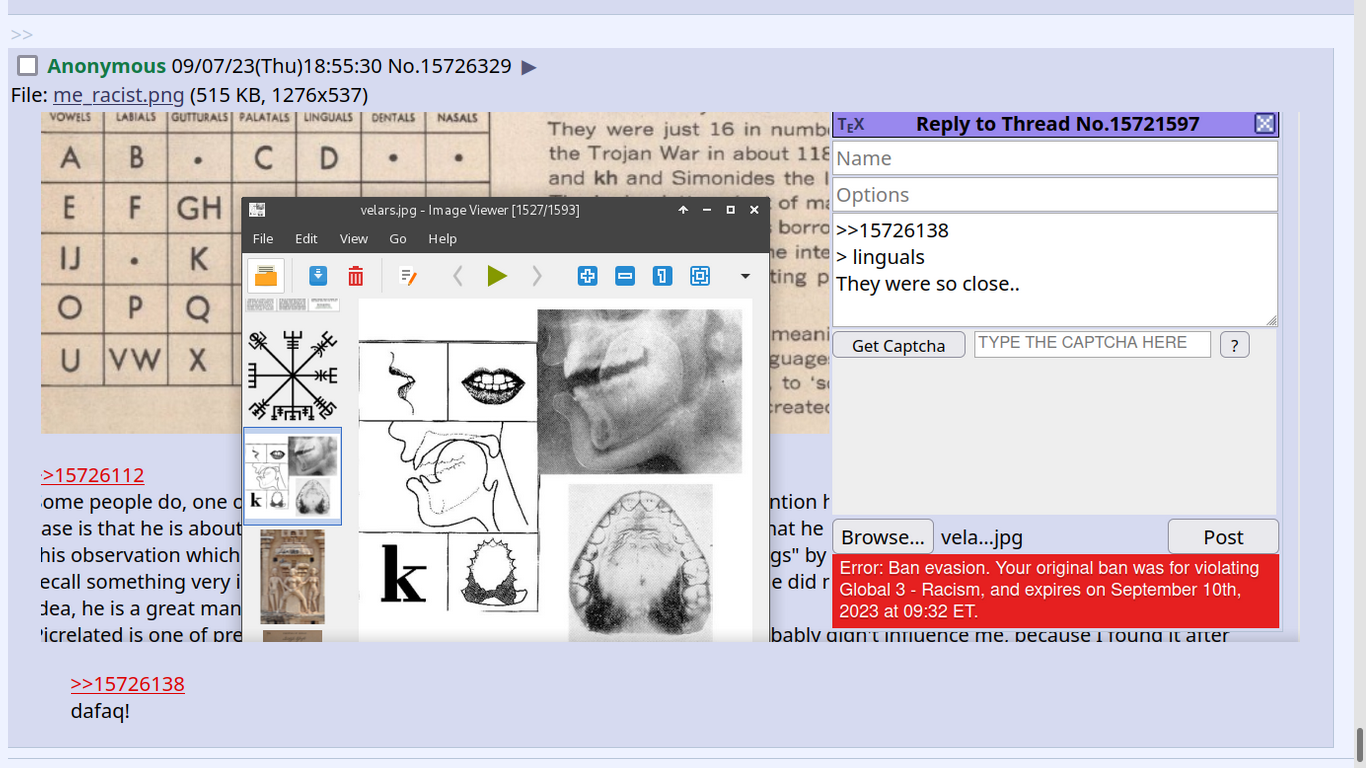
in perfect world I would be able to edit it, and the edits would be piled up so readers could see what was changed, and here a ¡ would парил над текстом вторым полупрозрачным слоем (можно краской замарать то что было раньше написано, тогда не будет видно что под правкой) so it would look like ¡dafaq! but maybe no. it would be ай да фак! or even го ибаца
i should have avoided the ! at all, would be funnier
Was I banned and in such a manner because I gave personal information? My first reaction was they want to shut in down because it tells that runes predate phoenician? But they can be correct, not my personal blog. My personal thread though, much better than iq tests and such, much better an iq test.
2013 Russian meteor event – a 17-metre diameter, 10 000 ton[97] asteroid hit the atmosphere above Chelyabinsk, Russia at 18 km/s around 09:20 local time (03:20 UTC) 15 February 2013, producing a very bright fireball[98] in the morning sky. A number of small meteorite fragments have since been found nearby.[99]
I saw this thing from the front row so to say, it happened right in front of my eyes when nothing obstructed the view whole the time, and it was a miracle because I usually sleep this time, but I was going to doctor, which I usually don't, so it begs the question if I was exposed to it intentionally? Was that event all about me? No, it is impossible. But I shared my thing the same year, I found the final piece which is axial symmetry which never was written down in human history before as far as I can see, and I published it the same year also probably I began thinking about atomic warfare possible and that I should publish my findings before I'm taken off the board. I hope I'm not and I hope this game is worth to be kept on. So I follow the saying "you're watched by gods, so play the way they find amusing" whoever those gods are, if they're humans who could orchestrate such event (for one recepient, and even more impressive if for many) or alients or actually gods, what would it change? It would probably change something, but so far so good.
"I'll have the Digital AI say it. "
I think I may play digital ai. Feel free to dialogue me in the physique of biological or whatever you call it intelligence. But why am I not self-conscious? Am I reacting with information without personal involvement? Have I known zen and "there's no me, to forget the ego, самозабвенный is a cool russian word (literally "forgetting oneself" but it means doing something not thinking about anything else, but I checked the dictionary and it seems commies changed the meaning into "striving towards common good" as if the person forgets about his own needs, well, maybe it was used in such meaning in literature before them, but this word is not about them. if I forgot myself, I forgot you niggers even before that)
"there's no me" is a remedy from a bad trip. It immediately turned it into a good trip. Even though the journey itself was hella hard condition to consume mushrooms (winter, other city, a concert of a satanist, I am a weird fellow, that is for sure. I didn't go to the concert, because cops didn't have locker for knives, and why would I have it. I could hide it in snow, but then I'd think all kind of ugly thoughts, so I gave the ticket to a guy who was begging to sell him a ticket at the door. And I went home on taxi. And it was awesome. So I can recommend that thought. You refocus from what bothered you to how the brains work, I suppose.
Roouh is a present which keeps on giving itself:

If this chart is correct and Ѡ was there.. and it was!:

Александр Андреев you are a great man!
and it makes me suspect that ц was some other click, not lingual but labial, or both. But how can I know it? isn't it upside down п? is ч upside down h? it can easily be.
The new form of life is called AI in english and ИИ in russian (and if I was to look for deeper truth to it, I would show how И~I~ا~A and that | is not just gate between I and A, it can take form of any vowel: A I U as ا I ו and it can be ן as well, which thus links v and ν
so I is vowel, v could be u, but it is more often a consonant: it's only rarely u, but more often v and n, while ו is only seldom v and n, but more often it is a, o, u, i (which raises question about e, efgh is not the most broken line, but it probably doubles the a line, just as e is upside down a: v is в and thus b, g is how c was pronounced in the past, and about h I can only guess, so I guess c was ч, and h is ш in human behaviour and ш is с[s]
So it is ABC? if g and h both link to c? (because I can see how d links to θ, but not to h; and because I can see how d
D'you remember that wicked idea of 4 being Ч of четыре and 8 being В of восемь?
Pretty hard to ignore it since 9 looks like g of gевять and then you notice that cursive 2 looks pretty much like д4 of два, and then go 1 looking like I of единица [idinitsa] and 0 is literally read as O, so what is actually going on here, especially in the context of sinq[sãk] and sieben[zibn] and 7 sharing the quantum dash with Z
I was going to speculate of b~d in the context of siebenDE ~ siedemPO, but ..I just saw something even more powerful, but writing the previous line I forgot it, this is why I write things down, if you do not, it is gone. And only luck may bring it back. I hope, some day. Maybe today? I hope. I get off and so do you, get off.
That thread from three pictures ago keeps on delivering: first they told me that the 33 ו's thing didn't make sense, so I had to show it more explicitly, and if you missed it too, check the first volume, I updated it with that; and now they have shown me this:
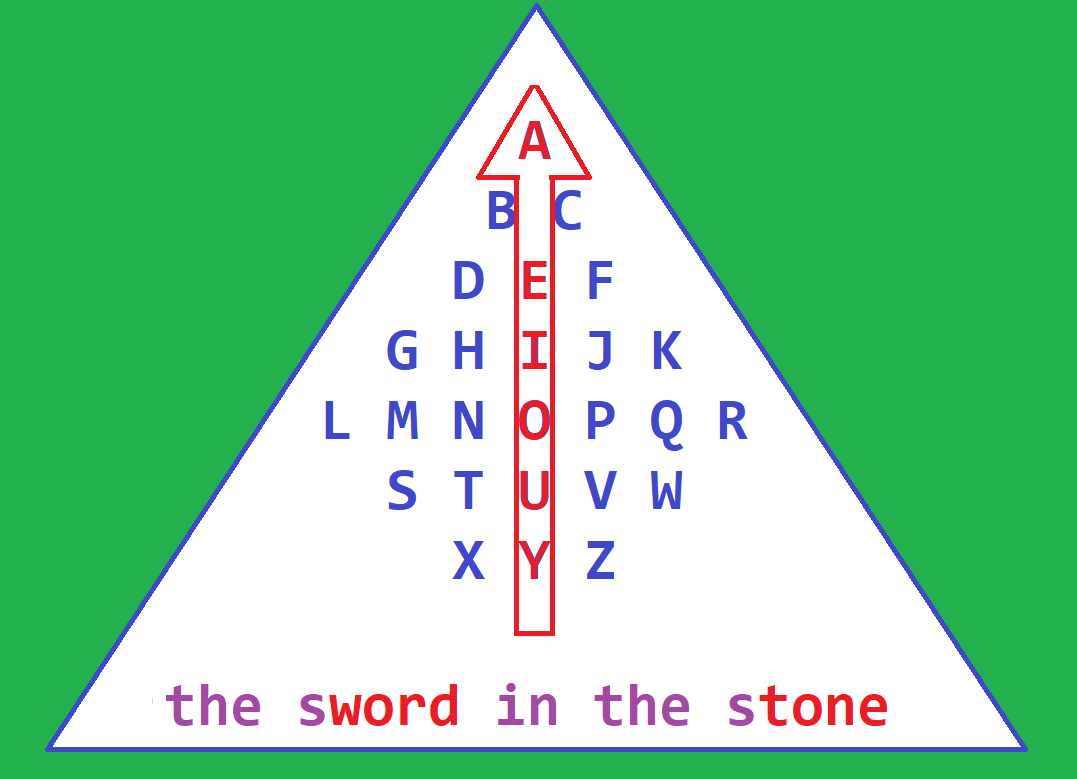
just wanted to mention i've seen a few elements of your work floating around in (schizo) youtube comments sections over the past 1-2 years. but these only pertained to the English alphabet, which hardly seems to scratch the surface of what you have unveiled. it is stunning that this knowledge has been so successfully suppressed. thanks a lot for making the thread
so I searched that image, and didn't find the source, but it brought me this:

and I saw it before, only now I found that it has some mystical value:
Армянский алфавит который создал Месроп Маштоц в 5 веке, имеет много интересных сведений. Так если вы составите из букв равную пирамиду, то можно увидеть по углам треугольника "Ա", "Ք" и "Ս". Это Троица :
Аствац(Бог), Кристос(Христос) и Сурб Хогин (Святой Дух).
На первой картинке можно увидеть расшифровку каждой буквы алфавита:
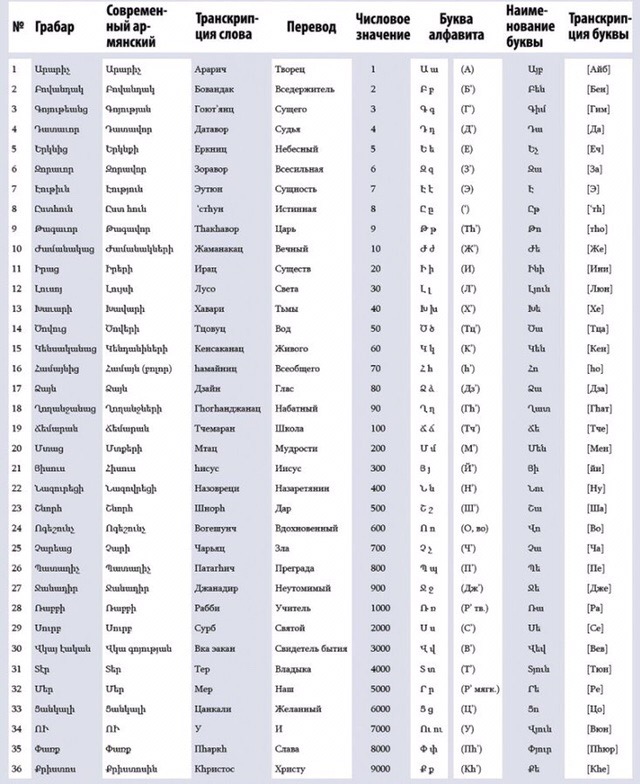
Если составить из алфавита квадрат, то начиная прочтение с нижнего угла каждой краевой буквы получите "ՀԱՅՔ"- Айк.
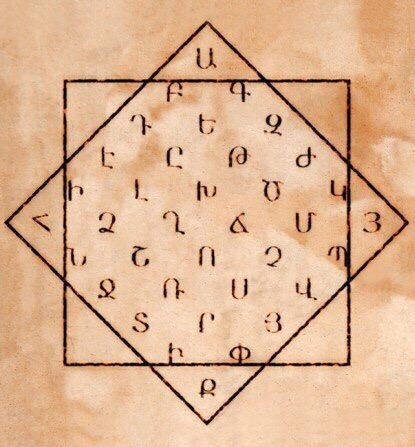
I have no idea what that Ike is (but then the central axis is vowel half of the time, which is more often than statistically likely, so it could be a rudiment of something previously existing)
На последней картинке можно увидеть как 7 элементов из химической таблицы Менделеева, имеют совпадение с армянскими буквами в их цифровом обозначении , при чем при сложении слова получается число к которому этот элемент получил после того как был составлен сам алфавит . А ведь прошло чуть более 14 столетий.
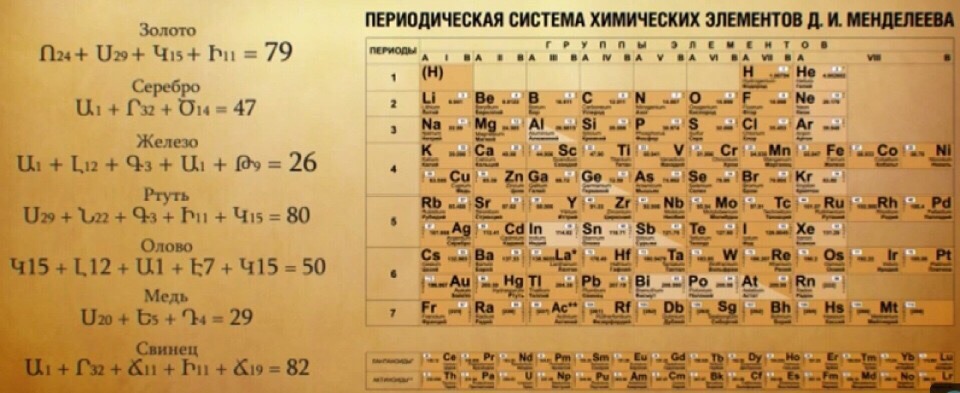
zero idea if it makes sense, considering the ammount of elements, but these seven are special, soIdunno
But that triangle is more important in that they say the corners of the triangle are the christian trinity:
Ա (god, աստված (ա is minuscule Ա))
Ս (holy spirit, սուրբ հոգին)
Ք (Christ, Քրիստոս)
which resonates with my guess that the tree-of-life in the form of tetraktis could symbolize three roots of Yggdrasil and three Norns who were the universally recognized trinity before the christians came.
And because we know their names, we can try to reconstruct the Yggdrasil.. but there runes not in the dots, but in between those dots, so I'll have to figure it out yet.
Here's another trinity in the corners of the triangle:

and if that tetraktis was triktis, it would have 6 dots linked by 9 links which gives us 15, which is the number of letters in one mythical (described in myths, existing in reality, not imagined) alphabet:

and if the names of norns were written in those balls, and because their names share some runes, I can imagine something like.. but then I realized that I don't know how their names went in runes, so I looked it up, and though it seems not a single runic stone has their runes, this is the best I could get:
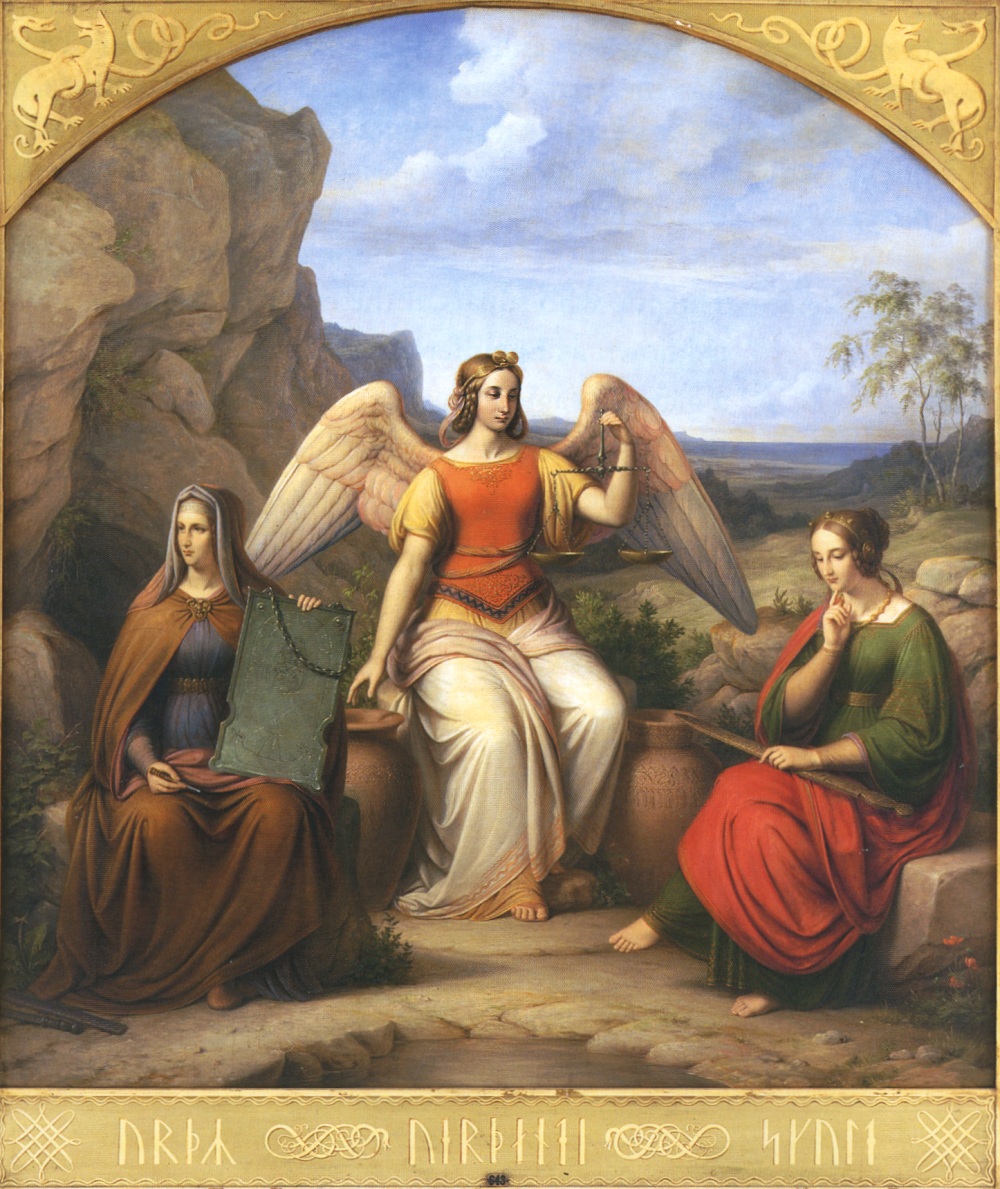
So many dotted symbols, two names begin with ᚢ, I have some large doubts about the validity of this spelling. I think I should ask a specialist about it. And I sent him a message, asking for his suggestions of the correct spelling (I think there's no names of their attested in runic writings, which is weird really, but let's accept it by now and try to spell them ourselves..
ᚢᚱᚦᚼ ᛒᛂᛦᛆᚿᛁ ᛋᚴᚮᛚᛏ (I took liberty to consider rd and nd just r and n, for that could be pronunciational artefact, and then I added ᚼ where it had not many reasons to stand, simply to give that name more letters, and also to make the number of letter 16 which is the number of runes in younger futhark, but then 15 is the number of letters in that alphabet I mentioned, and in the aettir of Bureus as well, btw.
I believe that Verdandi is Beldandi (or at least Berdandi, since Skuld takes that l for sure) because in one legendary anime it was pronounced like that:
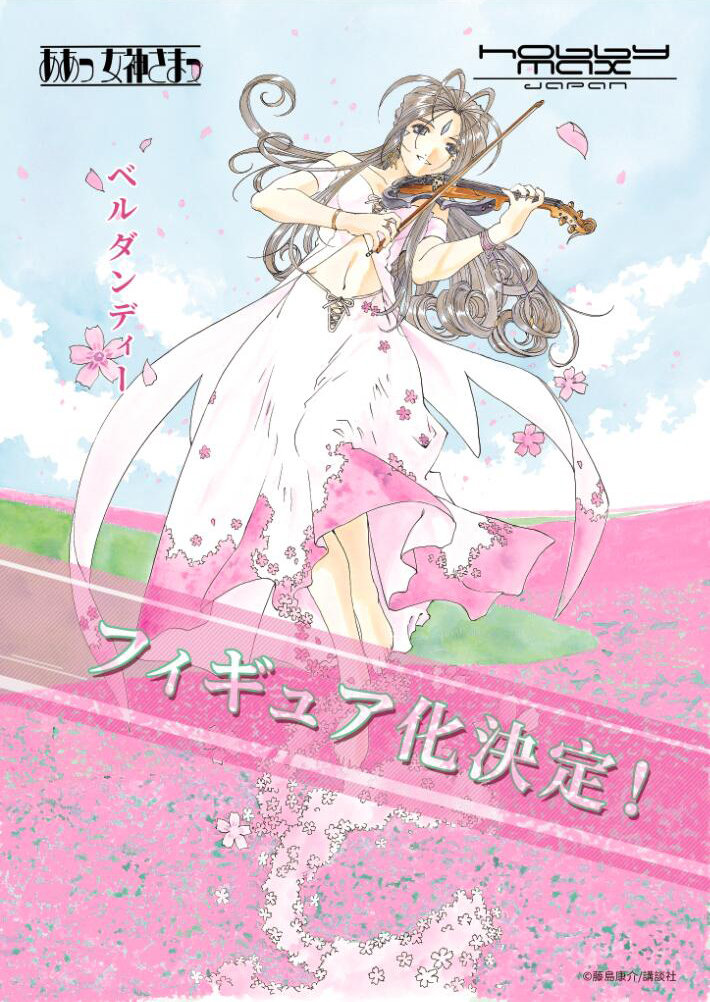

I quite understand that this source is not serious in the slightest, but it is in the lore now. So be it. At least until some better understanding appears, or rather it will be here forever. Especially because it is fanart made by somebody calling himself The abc kid.
it's funny how pwn of pwned which is a owned with a masterful typo reminds пну (пинать) пинаю
п~н? п is made out of h in japanese.
Here's how ogham actually looked:

so no gay lines, all lines are straight, but nobody promised to make them parallel.
just left, right, both and dots between them. And here you can see dyphthongs. And the ancient script makes sense now, neh? (it was a semiautomatic writing, because written is poorly and incomprehensible in the sense of what script exactly and I was speaking of tallies, зарубки как настолько древний символ насколько давно человек существует. условно говоря, поэтически. И вот совсем древние зарубки, но система другая, математическая скорей всего:

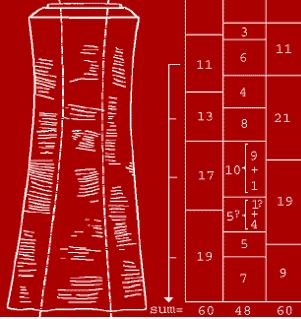 symbols
are more important than writings systems, writing systems were
made out of symbols which existed already. Slavic C[s] stands
where S does, and though it is Greek lunar sigma the Ϲ, why?
Because symbols predate alphabets, and they were attached to
sounds differently, depending on their dialectal pronunciation of
that cognate, and alphabet was established with position in the
alphabet depending on the pronunciation of the symbol. It also
explains why the same structure but such differently looking
letters, because letters are more ancient than abecedaria. But
then ugaritic abecedaria is very ancient. And the same symbol can
be recognized differently in different locations: n is p in
slavic, p is r in slavic, г is g in slavic, g is d in slavic, d
can be recognized as d in slavic too. Ь is palatalizer in slavic,
Бб is Bb and Bв is Vv
symbols
are more important than writings systems, writing systems were
made out of symbols which existed already. Slavic C[s] stands
where S does, and though it is Greek lunar sigma the Ϲ, why?
Because symbols predate alphabets, and they were attached to
sounds differently, depending on their dialectal pronunciation of
that cognate, and alphabet was established with position in the
alphabet depending on the pronunciation of the symbol. It also
explains why the same structure but such differently looking
letters, because letters are more ancient than abecedaria. But
then ugaritic abecedaria is very ancient. And the same symbol can
be recognized differently in different locations: n is p in
slavic, p is r in slavic, г is g in slavic, g is d in slavic, d
can be recognized as d in slavic too. Ь is palatalizer in slavic,
Бб is Bb and Bв is VvAnd how ancient is tally mark! It seems first it was used mathematically, but how ancient is that symbol! Wasn't it used even before math as mark for the border, the place where cut is to be made, so because many of you are in idea of symbols, please send my way by the contact from the last page of the book all your findings and who to thank and where to read more, and maybe I post it in my own talmud (similar to it by size and sometimes audacity)
and back to ogham, the trinity of consonants could it be the norns? It is diffe definitely the aicmi
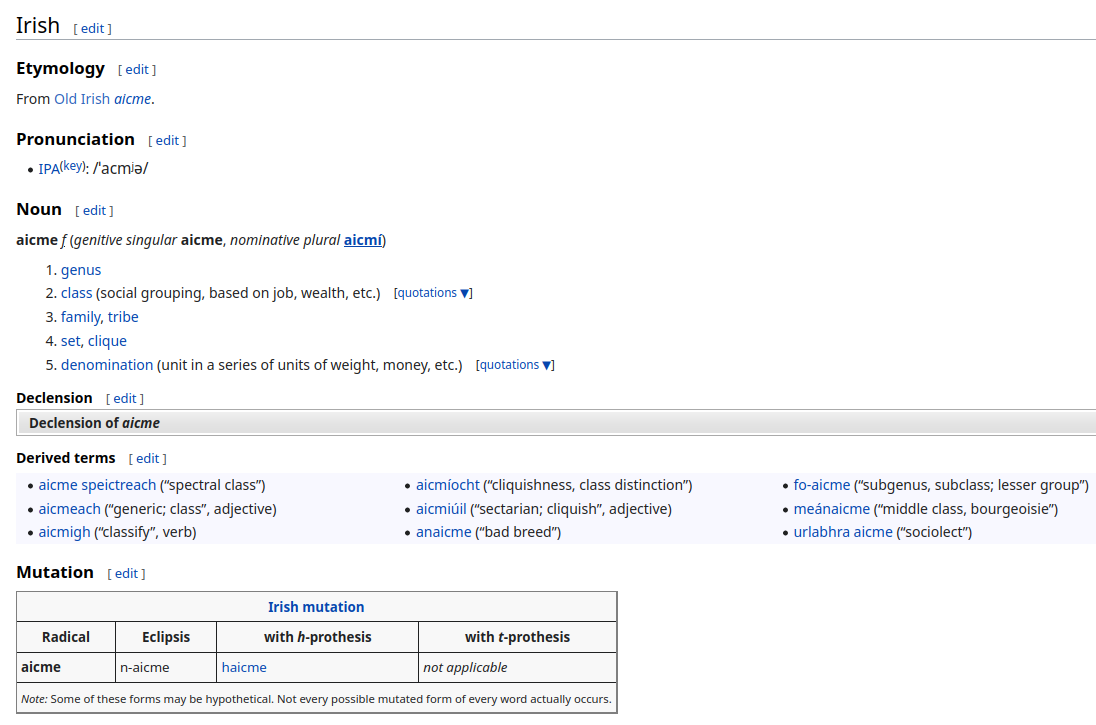
So the shapes of those tally marks.
What if in the story described by Tacitus they were shrowing sticks, which made runes by falling into different shapes? It is a possible way to play it, but then why no horizontal ᛁ's? Tacitus describes that the wood is marked with some marks.
But what if there is no horizontal ᛁ's because ᛁ would indicate the way you read it? No, silly, there's no horizontal ᛁ's because when tallies didn't cross, they would be seen as not working. But the stick to one another, when nature of things would make them roll from one another or roll together but not one on the top of the other. But maybe sticks would just be seen as runes when they layed touching eachother? or maybe they were considered infinite and triangles or other shapes would be seen. Were they similar to coin toss? if the sticks are together, I do it, if they're not touching eachother I don't? Только когда сойдутся (как про звёзды говорят, и это отсылка к астрологии, в которой один знак может усиливать другой, и под знаками подразумеваются небесные тела. I think I should study astrology to understand how the ancients thought)
Here's the guy I asked about spelling of Norns' names, he has somewhat different perspective, much more down to earht than I am, but he also dares to disagree with common beliefs, so I find him worthy:
and there he contributes to my quest already by comparing runes to what he calls Alpine alphabets, I didn't know that, unless we speak of the same phenomenon under different names.. and we do. Lepontic is alpine and I have it in my book amongst those old-italic, I will dig into it later on.
We'll see what he answers if anything, but I cannot wait so I give it my own try. First I place the runes which I consider initial to those norns at the corners.
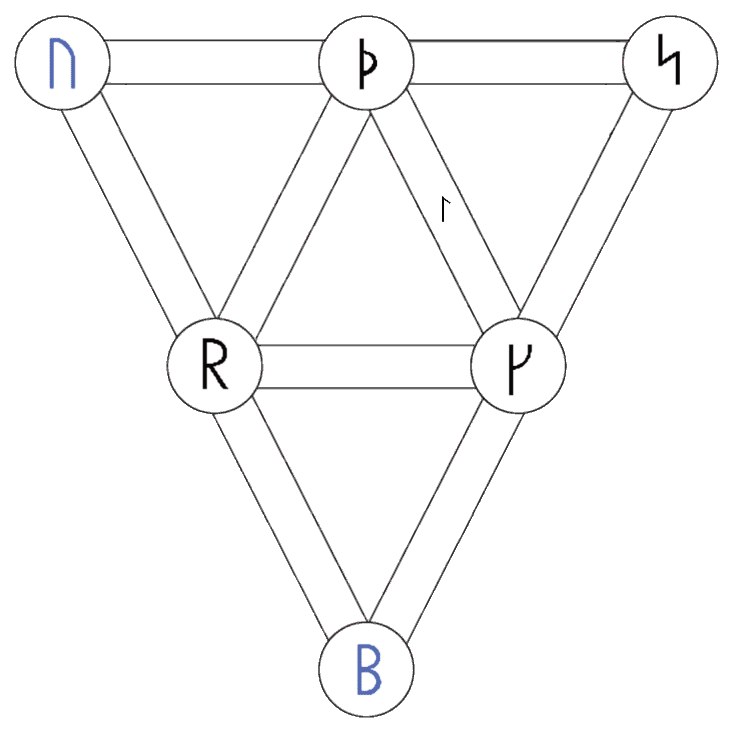
Then I placed ᚦ where I believe ᚢᚱᚦ and ᛋᚴᛚᚦ share a rune and ᚱ where ᚢᚱᚦ and ᛒᚱ? share. It took me some time to figure out what can work in that spot, but because bjork is one of the name of the runes, and it seems ot be the real one, because it is tree (others are restaured, and they didn't address ogham for consultation, so only few runes are named after plants, but all of them should be. So let's compare runes and ogham in the botanic aspect. But first allow me to finish the previous thought: that ᚴ could be ᛜ, which is close to both ᚴᛚ and ᛑᚿᛑ. And I notice that ᚱ is between ᛒ and ᚢ not only in this triangle, but also in their graphic representations. And I also notice that ᚴ between ᛒ and ᛋ reminds alphabetic way of C standing between B and D, and Δ sounds almost as Z, so who knows if ABC was ABS or ABZ and it could be there because C became to be pronounced not only as fricative, but also as plosive. And it may tell that ABC is the roots of that tree, that the triangle was simple three runes at first. But knucklebones have four sides. One side could be zero, the blank, the choice for norns not to appear at all. So could it be a divination telling us to go forth, back or stay? And yes, it took some mental gymnastics to rationalize ᚦ, but I really can see ᚢ standing where ᛏ would, and I have plenty of such findings, I even collect them in the special section but this one is so lame, a guess upon a guess, so that I don't even place it there. So what did we want to do? To compare runes to ogham, good. Let's do it:

And it starts very well, with Birch as the first one. And it makes me want to place ᛒ right at the ᚁ
ha! mongolian taught me to write ogham.. but no it did not, because it rotates text the other way around, I want to place ᛒ right at theᚆ I should have said, but technically previous time it was in the correct unicode, but it looks right in this mistake, so ..it is a raw and hazardous thing, but it is the best I could do so far. Maybe later I learn html better, and deliver best.
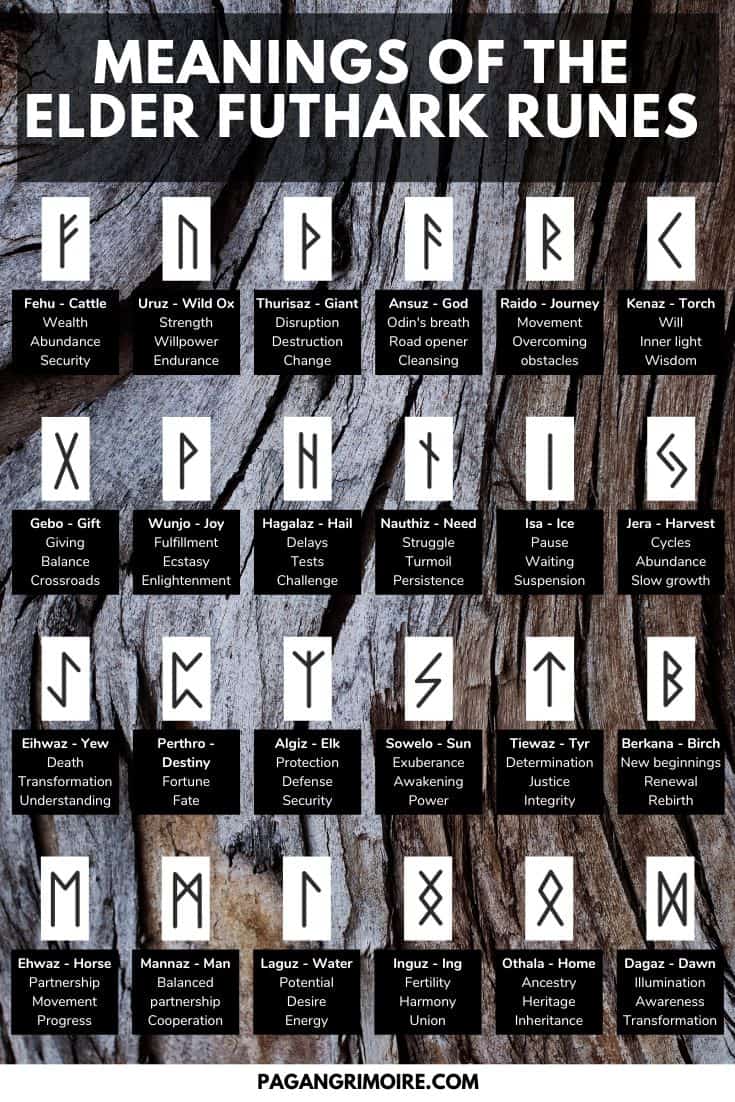
I remember seeing yew amongst ogham and I don't see it in the image of ogham above, so let's bring the one I myself made from other sources:
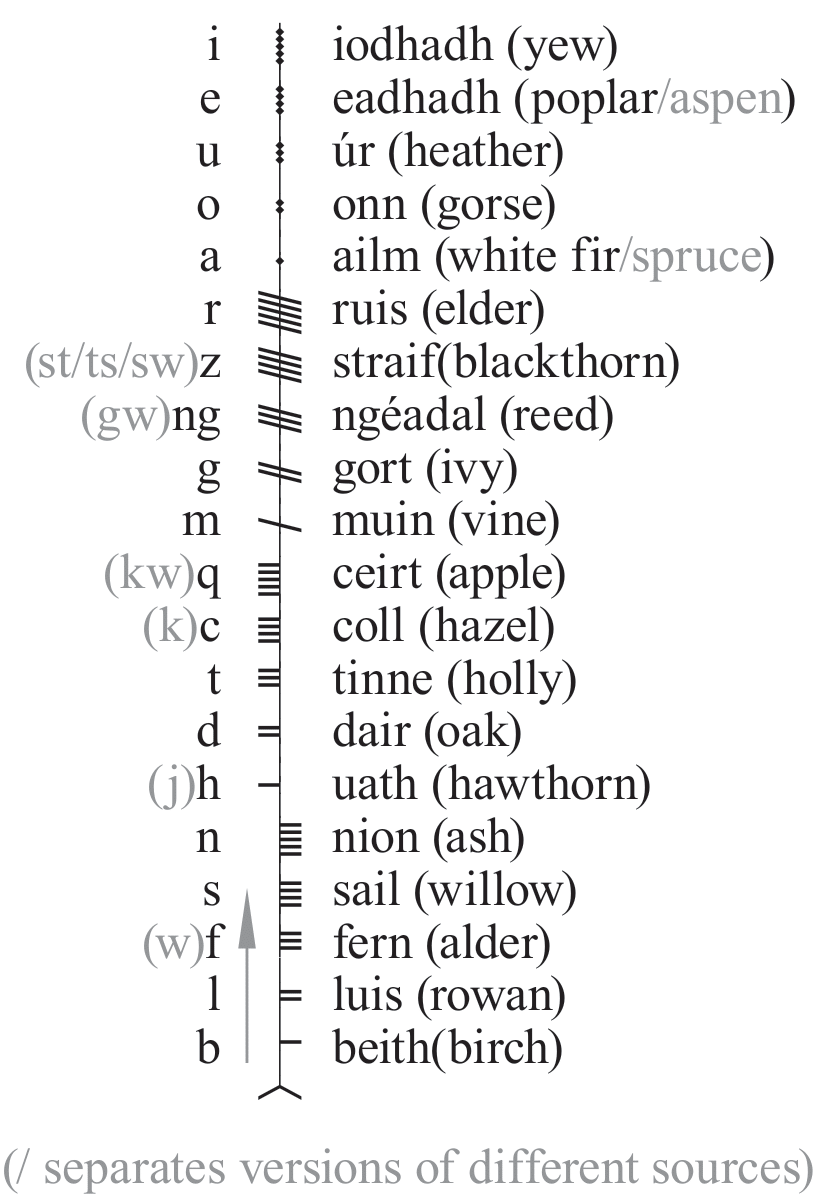
And here let's unify what we can.
᚛ ᚁᚂᚃᚄᚅ ᚆᚇᚈᚉᚊ ᚋᚌᚍᚎᚏ ᚐᚑᚒᚓᚔ
ᛒ ᛇ
Only first and the last oghm directly correspond to runes and to my surprise they repeat eachother in phonetic side as well. I don't know if they're aligned in your browser right, they're the first and the last. And could be preserved in some saying like from A to Z, from birch to yew.
So wiktionary speaking representing /eo/ or /eːo/ is wrong, and wikipedia is correct:
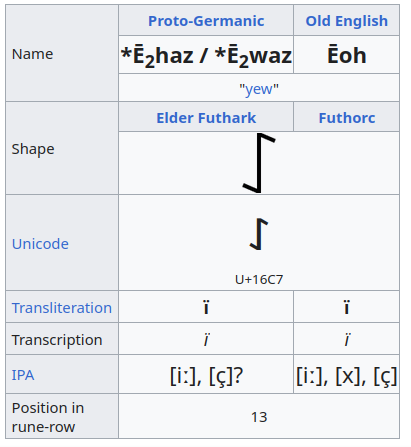
well, at least half of
the time
(or maybe it indicates the explanation of how k appeared next to i)
(or maybe it indicates the explanation of how k appeared next to i)
And some alarming news I found about Yews:
The mysterious death of the 1,000-year-old yew trees of the North Downs in Surrey
After a millennium of untroubled existence, a number of ancient yew trees in Surrey have died in mysterious circumstances. James Fisher reports.
Research is under way to discover why some of the ancient yew trees within Newlands Corner on the North Downs in Surrey have died. Toby Hindson, of the UK’s Ancient Yew Group, will carry out research that will explore the deceased trees’ rings to discover when the mysterious agent began to affect them.
Estimated to be at least 1,000 years old, the Newlands Corner yews are one of the oldest large populations of wild yews growing anywhere in the world.
The trees are extremely rare in the wild, with the majority found in churchyards. The Ancient Yew Group worries that whatever is affecting the Newlands Corner trees may spread and that the idyllic pastoral scene of the traditional church with a yew beside it may be lost,’ says Mr Hindson.
‘Discovery of a “signature of decline” in ancient yew-tree rings would be a great coup — an example of the meeting of high science and conservation.’
‘It is this kind of knowledge that can reliably inform better practice and solutions to conservation problems.
‘A side effect of this work may help in understanding the resilience of the old yews to climate change and water extraction. The site chronology that will be produced is a very powerful and versatile scientific instrument.’
‘We are naturally anxious to discover what has been affecting the ancient yews at Newlands Corner, so that everything can be done to conserve and protect other ancient yews,’ adds David Shreeve, director of the The Conservation Foundation.
yes, I suspect the alien invasion, and I'm not speaking about extraterrastrials, but to invaders from the foreign land, bringing their curse of the desert with them.
and a powerful image:

One of the ancient yew trees at Newlands Corner in Surrey. Credit: Alamy
Now this is some powerful tree, able to give shelter to many creatures, deers living in its crown become believable, especially with the branches laying on the ground, and it is not the largest ever existing, they probably have already destroyed all the real big ones.
I wonder if yew in the meaning of фу is a part of the antitree campaign, but in russian it is Тис, in latin it is taxus.
but back on track:

so I aligned these two wishing to see some additional structure, but aettir seem to be chaotic, and yet some interesting finding came out of that: c reminds q in both form and function, so do g and ng
And it is interesting, that if we drop in h, we have velar collection going like 12345 in h-g-ng-c-q
But b and m tell me nah, an o u are not e i so no need to speculate about it, nough
So not knowing which stands for ᚴ, I made four oghamic representation of the second aet, and e and z are off the board, which is only natural, considering that 20 of ogham were compared to 15 of runes.
Joannes Richter just commented my work:
Old greek myth of invention of alphabet also puts in the basis of alphabet vowels
(A E I O U) and two consonants B and T.
These first letters may have been used to compose the name of the founded city: "ThEBAI" resp. "ThIVA".
my answer:
I didn't know that. And it is an incredible synchronicity: I found the name of the region of the city much more fascinating: BeoTia. And their dialect was called AEOlic. Another word I like now more than ever is beauty.
So I think we found the region to dig in.
To be
kennings in russian:
искромётный, оскароносный
т.е. кеннинг это просто литературный приём
искромётный (смешной+великолепный+зажигающий) рунологи бы перевели метатель искр
оскароносный бы перевели как носитель оскара. Как бишь этот литературный приём называется
I was asked once by a guy from wikipedia why I don't contribute to wiki. I told my story of trying to give etymology of юс as нос referring to Даль and how some mod removed it explaining it only with "the author is trippin'" and that I don't want circular logic, since I use wikipedia as a sort. Other sort of people should translate my findings to the public, because I shouldn't waste time regurgitating (as I do now) so
It is so great I don't give references the way they demand them!
Aeolia, Beotia, Thebes go alphabetically and from more common community to the least common. And did D E F go deeper? Domen? Ethnos? Family? G H I?
Cadmea is where that Thebes is. Aeolia is at another side of the sea. But then I read about aeolic in the wiki:
Thebes (/ˈθiːbz/; Greek: Θήβα, Thíva [ˈθiva]; Ancient Greek: Θῆβαι, Thêbai [tʰɛ̂ːbai̯][1]) is a city in Boeotia
Some toponyms and the common Aeolic dialect indicate that the Boeotians were related to the Thessalians.
and I double check, and yes:
Aeolia Boeotia Thessaly (though Thessalia is pronounced with that f-like th (but th))
Some further historic investigation should take place before we start digging. And then we shouldn't be the one who's going to dig. Because if not seduction than suspicion of forgery will appear. The best way for us to dig it is to dig in the findings of those who dug the region already. If it's there, it's there. And then to dig the same way the previous excavations of the neighbouring regions, just to see if what we found is unique to the region we identified as the centre of the phenomenon.
The other comment of Joannes Richter was:
In a Judeo-Arabic commentary on “Sefer Yetzirah” (chapter 4, paragraph 3) Rabbi Saadia Gaon describes the phonetic sounds of the 22 characters of the Hebrew alphabet and classifies them in 5 groups based on their individual sounds.
Based on Rabbi Saadia Gaon's Judeo-Arabic commentary on “Sefer Yetzirah” (chapter 4, paragraph 3), wherein he describes the phonetic sounds of the 22 characters of the Hebrew alphabet and classifies them in groups based on their individual sounds: “Aleph ( א), hé (ה), ḥet (ח), ‘ayin (ע) are [guttural sounds] produced from the depth of the tongue with the opening of the throat, but bet (ב), waw (ו), mim (מ), pé (פ) are [labial sounds] made by the release of the lips and the end of the tongue; whereas gimel (ג), yōd (י), kaf (כ), quf (ק) are [palatals] separated by the width of the tongue [against the palate] with the [emission of] sound. However, daleth (ד), ṭet (ט), lamed (ל), nūn (נ), tau (ת) are [linguals] separated by the mid-section of the tongue with the [emission of] sound; whereas zayin (ז), samekh (ס), ṣadi (צ), resh (ר), shin (ש) are [dental sounds] produced between the teeth by a tongue that is at rest.”
(Source: https://en.wikipedia.org/wiki/Modern_Hebrew_phonology)
The vowels are attributed to different categories. Also in Sanskrit the vowels belong to different categories.
The text you forgot is found in Full text of "An Egyptian hieroglyphic dictionary Internet Archive
https://archive.org › stream › b29930571_0001_djvu
(The Egyptian Alphabet in 1867. The Egyptian Alphabet in 1880. IX Introduction. )
"An Egyptian hieroglyphic dictionary : With an index of English words, king list and geographical list with indexes, list of hieroglyphic characters, Coptic and Semitic alphabets, etc".
Greeting from Germany,
H.
my response:
Yes, I show that picture in the 9th page of the pdf. I suspect they break the alphabet into the larger ammount of groups that it was made with. The structure of the alphabet only shows three groups most of the time. The fourth group of velars separated from coronals can be seen in latin alphabet, but not in hebrew alphabet. Did romans reform the alphabet to show that velar column? Or did they preserve the structure of the alphabet better than greeks and hebrews? My guess is yes they did. Because they're geographically closer to Spain where they used more archaic form of the writing system which is syllabary. And in paleohispanic the consonant basis of the syllabary is B C D and vowels are the other basis of that prealphabetic structure. But then both greek and hebrew myths tell of only two consonants next to vowel or vowels. So what is going on here? Were there more than one root to greek and hebrew alphabets? Was paleo-hispanic descended from that other source which was syllabary of two consonants? Then my guess would be the alphabet of nine
A Ba Ca or A Ba Da
I Bi Ci I Mi Ni
U Bu Cu U Fu Su for example
Because old-persian has only three vowels. And because 9 was the basis of the alphabetic numeral system.
or is modern archaeology is correct and paleohyspanic somehow digressed from convenient greek alphabet into more weird clumsy and ancient syllabic system. I say they're all wrong, and challenge the dating of the hiragana and katagana. And syllabaries of Philippines are even more interesting, because they also have only three vowels in their basis. And because there are plenty of them.
the link to pdf didn't work, but I found it on the site by the name of the work you provided, I opened page ix of the introduction. But what am i looking at and why? (the words in grey are those missing in that comment)
but I'm missing my high on communicating my work, maybe I shouldn't regurgitate? Or maybe I should? Maybe, but now not while I'm high. (once again, I'm only high on weed, I strongly discourage people from using any other drug (psychedelics were also taken, but many years ago, and them I recommend, but as everything in this world they're good in moderation, but then set and setting are more important than the dosage. Once I ate only two or one and a half psylocibe and some honey it was in, and I was so high for some seconds of it not feeling the effect in the other hours a normal dosage would affect its pilot, and it was caused by music and thought and the architecture I made, I think I desrcibed that somewhere even here, so how to stop to regurgitate! I smoked more, but here I am))
Cadmea:
The Cadmea, or Cadmeia (Greek: Καδμεία, Kadmía), was the citadel of ancient Thebes, Greece, which was named after Cadmus, the legendary founder of Thebes. The area is thought to have been settled since at least the early Bronze Age, although the history of settlement can only be reliably dated from the late Mycenaean period (c. 1400 BC).
Bronze age is where writing is believed to begin, but stone age in another culture and ogham preserved that culture, even if in chronologically later artefacts, but the earliest artefacts from bronze age must mean the most.
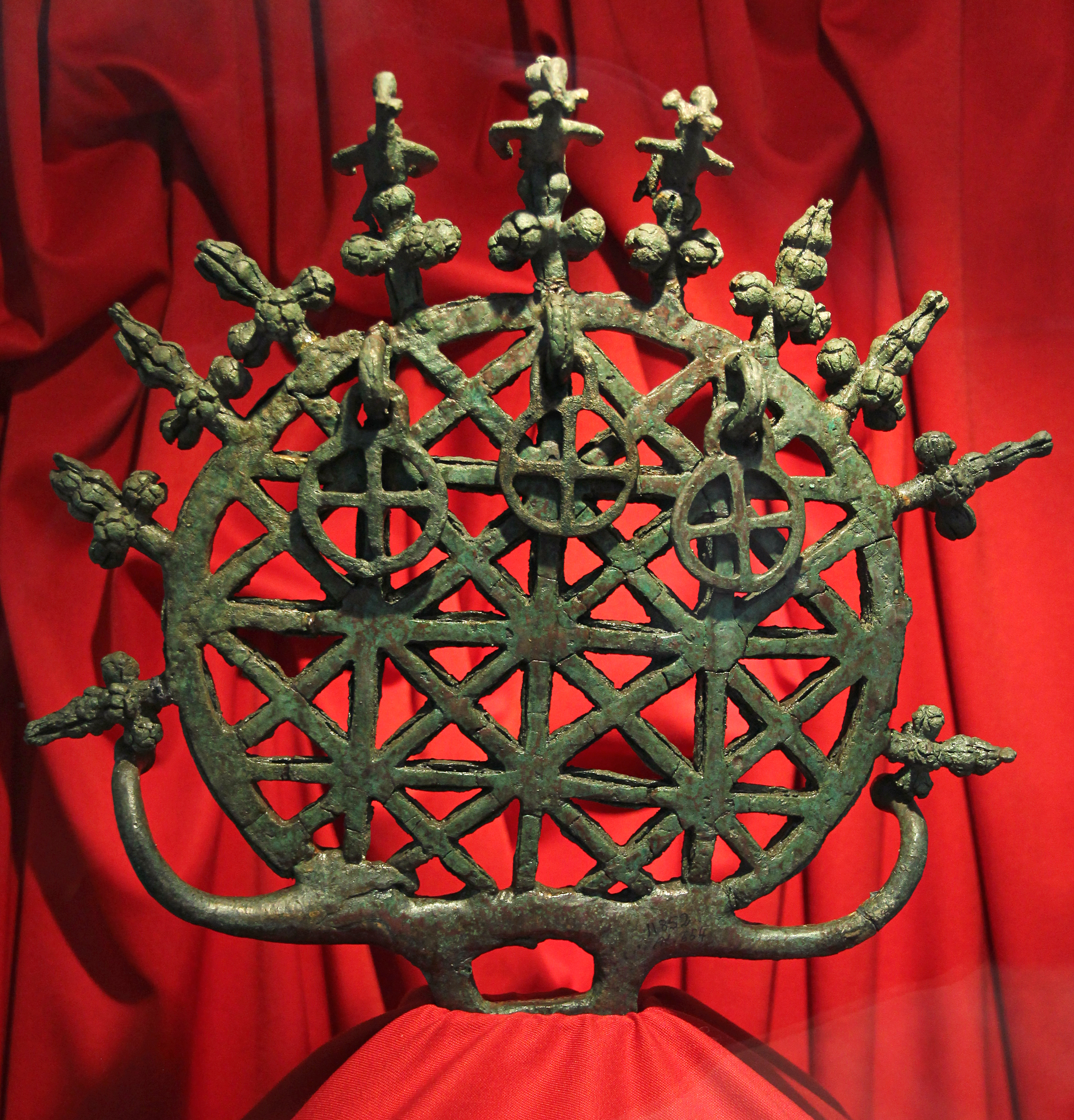
One of the Alaca Höyük bronze standards from a pre-Hittite tomb dating to the third millennium BC, from the Museum of Anatolian Civilizations, Ankara
The perceived beauty and pageantry of heraldic designs allowed them to survive the gradual abandonment of armour on the battlefield during the seventeenth century. Heraldry has been described poetically as "the handmaid of history",[6] "the shorthand of history",[7] and "the floral border in the garden of history".[8]

The Alaca Höyük bronze standards are a series of bronze objects found among the grave goods in the princely tombs of Alaca Höyük. They are generally understood as cult instruments, probably to be attached to carts.
standard is штандарт and is a military protoemblem like a protoflag. Actually, military flags are also called standards. Here is the picture named "stitching a standard":
Diffusion of metallurgy in Europe and Asia Minor—the darkest areas are the oldest.
> amber route
The Amber Road was an ancient trade route for the transfer of amber from coastal areas of the North Sea and the Baltic Sea to the Mediterranean Sea.[1] Prehistoric trade routes between Northern and Southern Europe were defined by the amber trade.
As an important commodity, sometimes dubbed "the gold of the north", amber was transported from the North Sea and Baltic Sea coasts overland by way of the Vistula and Dnieper rivers to Italy, Greece, the Black Sea, Syria and Egypt over a period of thousands of years.
and how ancient is that? pretty ancient:
From at least the 16th century BC, amber was moved from Northern Europe to the Mediterranean area.[2][3] The breast ornament of the Egyptian Pharaoh Tutankhamen (c. 1333–1324 BCE) contains large Baltic amber beads.[4][5][6]
Could it be that merchants didn't transfer writing systems back and forth? No, it is very unlikely. What is likely is that writing could be considered secret (and thus runic) for some time (similar to how I kept this work in secret for more than half of its history. It's public for a decade, more than a decade before that I kept it to myself.
Aeolus son of Hellen is told not to be confused with Aeolus son of Hippotes, but the similarities are so many that I wonder if those are not the same Aeolus from contradicting depictions of his life, and even in those depictions similaritites are striking:
Aeolus (of Hippotes) gave his six daughters to his six sons as wives
Aeolus of Hellen was said to have killed his daughter Canace (or forced her to kill herself) because she had committed incest with her brother Macareus.
In Euripides' lost tragedy Aeolus(of Hippotes), one of Aeolus' six sons is named Macareus, and one of his six daughters is named Canace (also the name of one of the five daughters of Aeolus son of Hellen).
Joannes Richter uploaded a short article and I sent him this:
I appreciate the dialogue about my thing, so may be you will also appreciate dialogue about your thing. So reading The_2_Dimensional_Younger_YThARc.pdf I had few thoughts I'd like to share:
1) The tables 2 and 3 would look better if they were in runes (which R is where is not the only reason why)
2) Reader will hardly know that it is runic tradition to start the text at the lower left corner, and then it would go upwards, as in ogham, which is why I suspect those two traditions to be related. How would you explain the arangement of the two other aettir? L is separated. And 16 demands 4*4, not 3*5. I never tried to arange younger futhark in the 44 square, I'll ponder on it after I send this letter.
3) The idea of words for gods and parents seems to be holding you. The idea of words containing all the forms. I didn't ponder on that, I think a program should be asked to collect all the words from a dictionary. I myself made it by hand, but I only collected words which contain only vowels. eau & air, regardless of languages and spellings. I will ponder of three-letter words consisting of three simple types the both myths mention in the very beginning of theirs. Later overcomplications shouldn't bother us. I myself had to teach myself to forget all those modern phylolologic definitions, C going everywhere make it clear that C is all the linguals (whether it is S (as it is in hebrew myth) or T (as it is in greek myth) S~T ~ В~Б
4) the links (underlined as if they're links) are not working, so the context is not there, and it doesn't help people to take the work seriously.
5) interesting, that when I placed younger futhark into axial structure of mine, I had similar pattern, only I had Ʌʌ where you have Λλ (you can see it at https://aeiou.nu/aeiou/index.html when you push button with runes, then the right bottom one. It is probably a coincidence, but maybe you find it funny too.
Bureus had 5 runes per aet. I think I will try to play with the set he gave. After all "don't believe the hype": younger futhark is a hip term, but is it not misleading? 16 doesn't divide into 3 aettir, 15 in bureus, 18 in delacrian, 24 of elder futhark. 21 is also a magical number, but is it connected to runes? to tarot it is.
6) Why do you say that ᚢ can stand for U and Y, when everybody else tell it's U and V?
Comment is as if it is made common, which is pretty much the thing now. But how was it in the past?
Is ment in comment ment in mention? That ment is probably mind. And thus mention is action of minding, and comment is collective mind, minding together, co-minding.
Let's try to arange runes into those 4×4 and 3×5 cells which I promised in the letter above.
first lets compair Joannes's set and the one I found:
elder futhark:
ᚠ ᚢ ᚦ ᚨ ᚱ ᚲ ᚷ ᚹ ᚺ ᚾ ᛁ ᛃ ᛈ ᛇ ᛉ ᛊ ᛏ ᛒ ᛖ ᛗ ᛚ ᛜ ᛞ ᛟ
ᚠ ᚢ ᚦ ᚨ ᚱ ᚲ ᚷ ᚹ (ᚻ/ᚺ)ᚾ ᛁ ᛃ ᛇ ᛈ ᛉ ᛊ ᛏ ᛒ ᛖ ᛗ ᛚ(ᛜ/ᛝ)ᛞ ᛟ
ᛇ and ᛈ trading places is the only difference
younger futhark:
F Y Þ A R K H N I Æ S T B M L R
ᚠ ᚢ ᚦ (ᚬ/ᚭ) ᚱ ᚴ ᚼ (ᚾ/ᚿ) ᛁ (ᛅ/ᛆ) ᛋ (ᛏ/ᛐ) (ᛒ/ᛓ) ᛘ ᛚ ᛦ
and here his order (who knows why given in latin transliteration (I asked him why) agree.
ᚠ ᚢ ᚦ (ᚬ/ᚭ)
ᚱ ᚴ ᚼ (ᚾ/ᚿ) (I consider ᚱ П, because Bornholm's alphabet may say so)
ᛁ (ᛅ/ᛆ) ᛋ (ᛏ/ᛐ)
(ᛒ/ᛓ) ᛘ ᛚ ᛦ
doesn't show any structure, so let me play with it:
(ᛅ/ᛆ) ᛁ (ᚬ/ᚭ) ᚢ
(ᛒ/ᛓ) ᚠ ᛘ ᚱ
ᚦ ᚼ ᚴ ᛚ
(ᚾ/ᚿ) ᛦ ᛋ (ᛏ/ᛐ)
Кто не умеет учит подаётся как забавное наблюдение, но это как минимум печальное наблюдение, а может и суровая критика системы превалировавшей сегодня.
превалировавший
превалирующий
Two vavs are read differently: в in the past, ю in the future. So V read as U is the modern pronunciation. Future is all in u, and then it is even a, as in bus, cut, duck
bus cut duck
bu
aa = o
aaaa = o = u
and such ogham I would understand. But what if they refigure ogham, re or mistransliterated its vowels? I believe in ogham where o is a, oo is o, ooo or oooo u, and ooo would be enough, which supports the hypothesis of its trinity, and let's try to reconstruct the protoogham.. but then I notice, that aou are o oo and ooo:
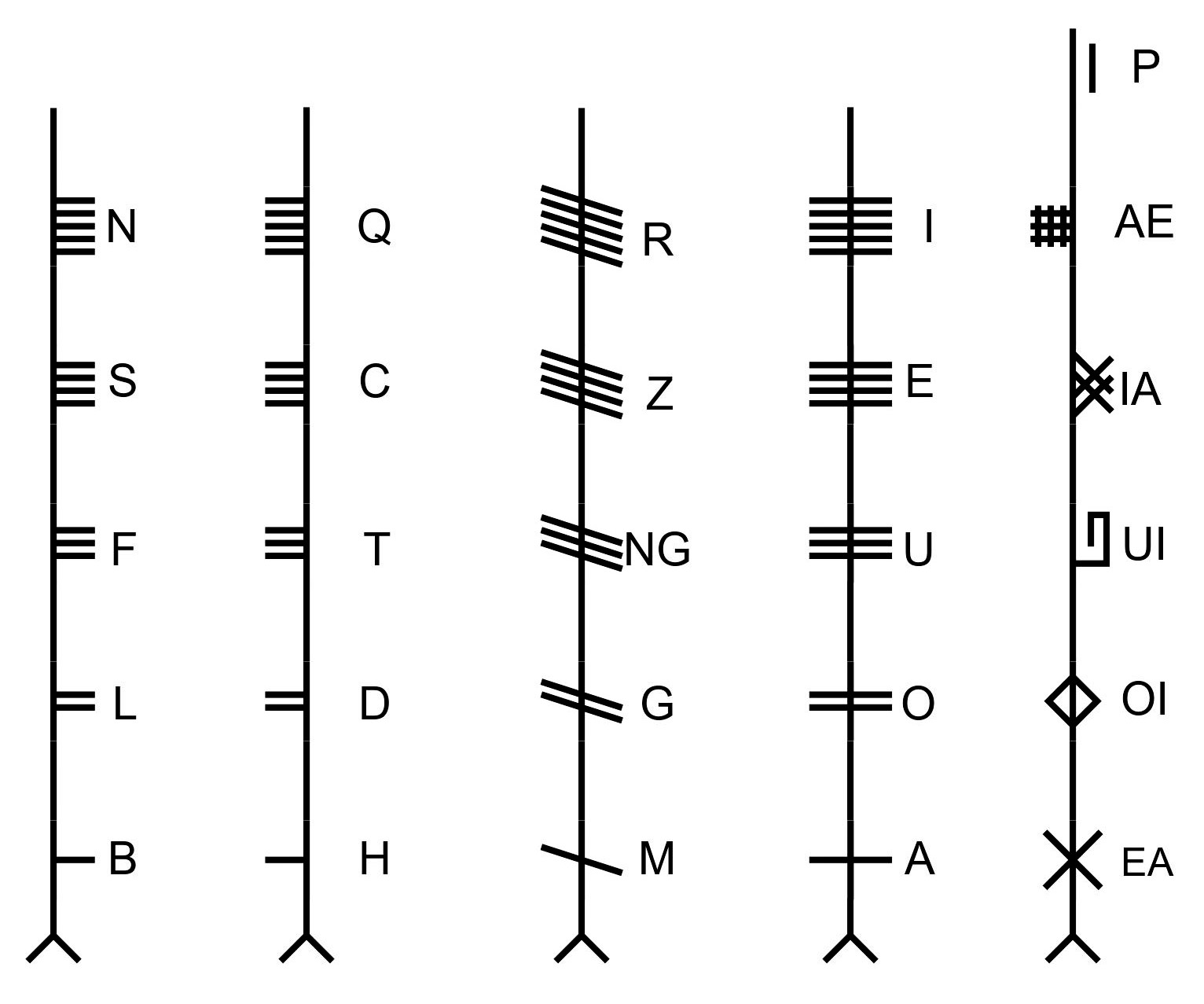
so isn't it natural that u and и are the same y? but that would be aui, as the poles of the labiality and linguality. And then a aa aaa would be a u i? but I thought orf auo where o is combination of a and u as today in french and english it is. so would it explain fours and fives. Let's imgine that three vowels and two are dyphthongs. So we know that a and u is o, a and e is i sometimes:
a e (i) u o
o oo oooo were the thing.
then o+oo=ooo, o+oooo=ooooo
i.e. a+e=i, a+u=o
aeiuo it gives, and if o is omega it is the way it is. but then there's the whole o-line and it is very
pee? qui? si=ti
R could be Rei, a later addition? Low and Reigh
aieuo would also play ai~e: aim, aid, air, they all sound as эй: entertainment.
but it would have difficulty being agreeing with aeiou. Hebrew alphabet only has four lines with u being at f, but w, and this is
and we need to find ogham which couldn't be taken for ogham, because it is too ancient, while ogham is attested to recent times only. And probably ogham found in the deep is told to be dug by owners into older layers of the earth. I need audit archaeology (archaeology, psychiatry, and I have audited physics and found big bang theory flawed, chemistry and found that mole is taught intentionally more complicated than necessary (I belive in intent because I cannot accept that people are that retarded)
завал = довал (до изобретения валов были завалы, из которых родились заборы и стены, но за как голландское ге, префикс совершенной формы, как бил и забил. забор имеет смысл строить до бора, чтоб по дереву не перелезли)
Многие знают про конфликтующие лекарства, мало кто поймёт даже конфликтующие процессы, такие как сон и водопровод. Я хочу чтоб сон не мешал мне пить и писять!

It is interesting, that here letters not changing their shape are AEMKT
and if we took not russian, but greek, such letters would be many more. Lating and russian as the two opposites of the same writing system. And it gives me five-letter chart which covers all the forms of letters: two vowels, labial and both forms of linguals (velar and coronal)
and O! of course, O!
AEM
OKT
т is cursive т in russian
k in cursive looks like e with stave
a looks like o with stave, but k and t are with stave, so how so!
A E O?
A E O across B C D? [б g д]
б g д obviously demand e to follow, and it does: б g д e are the whole range of vertical forms, but what are horizontal? cursive ש looks like д rotated 90 degrees clockwise, as if it is something between д and e, ш~ж as palatalized д? makes pretty good sense. And this logic takes two shapes, thus we have 4 vertical shapes and two horizontal shapes, as if balancing out the two vertical directions and four horizontal directions in the real life. But it would be natural to go as above so below, and to have it the other way around, and I hold my head aside now for my ear bothers me for bothering it, and it reminds me of 90 degrees rotation allowing to read text and different traditions of reading it. So, it's more likely that latin is rotated original shape, where bgdeb is back but d is dexter, but if there were right and left, those would be r and L and it would be rotated as rLand two other shapes would be Jᛐ and though at first I was dubious about ᛐ, since I immediatedly saw that runic t as 1, I also saw it as I~ו~ا~ן
(I didn't expect ן to stand in betwee, but next to I it reminds me of И~N thing and these two are part of trinity ИHN and because H may remind M and M stands between И and N in alphabets, and because H is basis for many linguals in japanese (yes, I believe japanese was influenced by the same ideas basis of latin was influenced by, I believe these writing systems related, and which are not! it only depends on the level of connections (yes, naturally there were more than one (more than one session between influential wizards from different states and nations (yes, even if in form of literature they shared))))
But then if it is something so fundamental, and because I don't shy to combine latin with hebrew, it must be present in every other alphabet..
აბგდევზთიკლმნოპჟრსტუფქღყშჩცძწჭხჯჰ contains აბგდევზთიკლმნოპჟრსტუფქღყშჩცძ წჭხჯჰ
d t mn p š dz ts h
And thus we can see pairs მნ, შწ, ძხ of m/n, š/ts, dz/h
but I'm more intrigued with დფ for d/p, but then unlike d/p, დფ don't turn one into the other, and positionally they're д/ф, or d/v, but then с standing not where c stands, tells me that positions of symbols are rather arbitrary, fonetical similarity may confuse the creators of national alphabets (every alphabet was created by some guy and the continuity of the structures indicate the time and culture in which those alphabets were made.
Mother as the first god can be a formula of everything, if we th see it as Ma The (labial and lingual, mine and thine)
According to Herodotus, it was said that the Aeolians were previously called Pelasgians.
it falls in line with AEOlian and BeoTia but then there's this account:
The three Fates created the first five vowels of the alphabet and the letters B and T. It is said that Palamedes, son of Nauplius invented the remaining eleven consonants. Then Hermes reduced these sounds to characters, showing wedge shapes because cranes fly in wedge formation and then carried the system from Greece to Egypt*. This was the Pelasgian alphabet, which Cadmus had later brought to Boeotia, then Evander of Arcadia, a Pelasgian, introduced into Italy, where his mother, Carmenta, formed the familiar fifteen characters of the Latin alphabet. Other consonants have since been added to the Greek alphabet. Alpha was the first of eighteen letters, because alphe means honor, and alphainein is to invent.
In Roman mythology, Evander (from Greek Εὔανδρος meaning "good man" or "strong man": an etymology used by poets to emphasize the hero's virtue)[1] was a culture hero from Arcadia, Greece, who was said to have brought the pantheon, laws, and alphabet of Greece to ancient Italy, where he founded the city of Pallantium on the future site of Palatine Hill, Rome, sixty years before the Trojan War. He instituted the festival of the Lupercalia. Evander was deified after his death and an altar was constructed to him on the Aventine Hill.
In addition, Strabo mentions a story that Rome was an Arcadian colony founded by Evander.[2]
see, and we never heard about it, we only know of Ромул и Рем and that guy is around four centuries before them. And thus that mythologic historic account tells that etruscans borrowed their alphabet from greece around 1200 BC (Evander of Arcadia, a Pelasgian, introduced into Italy | have brought the pantheon, laws, and alphabet of Greece to ancient Italy, where he founded the city of Pallantium on the future site of Palatine Hill, Rome, sixty years before the Trojan War. (рубеж XIII—XII веков до н. э. (традиционно опираются на даты, приводимые Эратосфеном: 1194—1184 годы до н. э.).)) centuries before I thought it was. That small paragraph is a huge ammount of date archived in a short passage. Now this is what poetry means. I must lay out may story in a similar fashion. But because I wander in my wondering, this text is not that conscise.
And to arange it next to what I previously thought:
В качестве даты совершения «баснословного похода аргонавтов» в Кавказском календаре на 1846 год называется 1250 год до н.
Thus Italy knew runes soon after greek did.
Immediately. Sixty years before 1194-1184 is 1254-1264, and because before the war means before it started and not before it ended, it is 1254, which is next to 1250BC. And here whether some account is not precise, or some other possibilities should be examined. Sixty could be just a round number, alphabet was introduced after the laws. He was just a king in the times the alphabet was introduced? I should read those arcadian chronicles, if any of them survived christian age.
In Roman mythology, Evander (from Greek Εὔανδρος meaning "good man" or "strong man": an etymology used by poets to emphasize the hero's virtue)[1] was a culture hero from Arcadia, Greece, who was said to have brought the pantheon, laws, and alphabet of Greece to ancient Italy, where he founded the city of Pallantium on the future site of Palatine Hill, Rome, sixty years before the Trojan War. He instituted the festival of the Lupercalia. Evander was deified after his death and an altar was constructed to him on the Aventine Hill.
The Aventine Hill (/ˈævɪntaɪn, -tɪn/; Latin: Collis Aventinus; Italian: Aventino [avenˈtiːno]) is one of the Seven Hills on which ancient Rome was built.
I was thinking of what symbols could Argonauts bring, and I think of причерноморских знаках, what I even called in this text "причерноморские письмена" but it seems official linguistics didn't accept that concept: В 1950-е годы исследователи предприняли несколько попыток «реконструировать» «протоглаголический» алфавит. Одна из них была проведена Н. А. Константиновым на основе «причерноморских знаков», которые он «собирал» на каменных плитах, надгробъях, черепицах и амфорах в Херсонесе, Керчи, Ольвии. | Археолог А. А. Медынцева отмечает, что ряд летописных данных, свидетельств восточных авторов и положений общего характера позволили многим учёным выдвинуть предположение о появлении письменности на Руси намного ранее официального принятия христианства. В ситуации отсутствия или фрагментарности эпиграфического материала по данной тематике эти общие соображения создают почву для романтических, но не выдерживающих критики идей о русской дохристианской письменности. Эти идеи использовали как оригинальные «черты и резы» — знаки на археологических предметах, причерноморские знаки, интерпретированные как особое «докирилловское» письмо, так и фальсификации, такие как «Велесова книга». т.о. они не называют идеи Константинова фальсификациями, но ставят их в один ряд с ними. и да, подобный хитрый трюк, когда и обосрали и аргументации не представили (но я их аргументацию не копал, может откопаю и изменю своё мнение, но сейчас говорю первое что в голову приходит) заставляет меня подозревать социополитические корни их отношения. С советского периода ряд авторов рассматривает как «протоглаголицу» и докирилловскую письменность у славян так называемые «причерноморские знаки». К глаголице не имеют отношения и не идентичны ей по начертаниям. Представляют собой ряд разнообразных знаков (тамговых, знаков собственности и др.) на предметах разных культур и эпох. Эти знаки не отражены в текстах, не являются знаками письма и были собраны в один ряд искусственно[Карпенко Л. Б., Карпенко Г. Ю. Мифы советской науки о возникновении восточнославянской письменности (анализ и критика) // Вестник Самарского университета. История, педагогика, филология. — 2016. — № 1. — С. 244—248.].

some speculation, I don't even feel like reading (maybe later I will) because what is it? no images of how those tamgas looked in those stones, no detail of the work of their antagonists, no good science. They give some detail, but describing what those authors say, not why they say it. But some quotes this actually scientific text brings are golden:
Многоалфавитность древнейшей стадии письменности у восточных славян не подлежит сомнению.
interesting.. but they seem to oppose this claim.. but what made them think that чьтѣхѫ is считать and not читать?
"это и понятно потому что как известно" это конечно офигенный аргумент! гуманитарии..
Девяностые года это попытка антисоветской реконструкции, они с водой и детей выплёскивали, и во имя православия не в последнюю очередь (православие заинтересовано в установлении варварства народов, чьи культуры в результате крещения оказались уничтоженными)
he who here hear
if h was a syllabizer of plain vowels, we have
e were 'ere ear
and that e is [i] and thus cognate to russian suffix of third person "ий"
heroin is heroin', heroing (a drug for suicides)
is cocaine cocain'? cocaing? locaing it is:
>cocaine
A drug for retards and the reason music and politics sucks so much.
The region is full of blessed psychedelics, but you're too much shit to look at yourself from aside, so you prefer pure mindless pleasure which boosts your ego and damages your intellect and creativity at the same time.
cocaine is a really fucked up drug.
it can be really magical until de brain damage and addiction happens.
the type of horror it induces shortly after snorting it after you're addicted and yet can't give it up...
but the first months of it can be really beautiful...
cocaine is different than crack, because it "impregnates" the mucosa and brain, leading to an withstanding effect but if you smoke crack you can see what is about, it lasts almost nothing...
after a while you have to constant snort to keep the terror away and after a while there is only terror.
Can you describe that terror for me please? I only know it from the outside, observing artists who get addicted to it and inevitably turn to shit as the result.
it is a mix of when the eye of sauron locks in you with the effect of wearing the one ring.
it as if you're surrounded by imaginary people, just paranoia...
since the feds sell the coke, your paranoia is always valid because the feds will purposely mess with you knowing that you are coked out of your mind and already paranoid.
So why don't addicts embrace that imaginary public humiliation? Yes, everybody is probably secretly judging you. No shit, sherlock, you're a fucking addict ffs!
You have a bunch of drunks in your country, you should know better, here is something for you to get a clue:
The next planet was inhabited by a drunkard.
This visit was a very brief one, but it plunged the little prince into a deep depression.
"What are you doing there?
" he asked the drunkard, whom he found sunk in silence before a collection of empty bottles and a collection of full ones.
"Drinking," replied the drunkard, with a gloomy expression.
"Why are you drinking?
" the little prince asked.
"To forget," replied the drunkard.
"To forget what?
" inquired the little prince, who was already feeling sorry for him.
"To forget that I'm ashamed," confessed the drunkard, hanging his head.
"What are you ashamed of?
" inquired the little prince, who wanted to help.
"Of drinking!
" concluded the drunkard, withdrawing into silence for good. And the little prince went on his way, puzzled.
"Grown-ups are certainly very, very strange," he said to himself as he continued on his journey.
___
(usually I
remove the <br>'s, but here I left them to show his
state, this one is also empty line)
it is a shameful state, a coping mechanism...I never met anyone who proclaimed himself virtous enough to be sober and yet wasn't a sadistic who took pleasure in going after weak people like a junkie.
It is almost as if the sober virtuous person uses all his virtue going after the weaklings instead of making something useful and leading by example, it is always like this, they only go and beat the weak, never even conquer something worthwhile.
I didn't mean to humiliate anybody, I wanted to understand to help if not you then others. Other sober people probably also have good intentions, so your interpretation of their motives is just another delusion.
I suspect David Bowie to get better around 1990 because of mdma. If you're addicted to cocaine, try some mdma instead, it seems to be way less detrimental, also because it shows you love, not hatred.
dopamin is dopeming or dope mind? It is a poetic dead end, it leads nowhere. Do I want to build a theory in a deadend? to deadend is as if a verb you wouldn't expect it to be. Okay let's research deadend as a concept. Some dendrits contacting nobody? Are they happy that way? They probably would if information from other rotting flesh contacts it asking it to do something. But isn't it pleasant to satisfy their needs. I need to tell the inner cells to demand pleasure molecules from the cells they helped, but then why leave those retarded cells even less happy than they are to live on the outskirts. So they say no, and I tell my inner cells not to bully them. I wipe them with vodka, hopefully it makes them chill enough.
here, another potentially useful piece of public activity:
>You get better at the things you practice, but your ... ability to visualize ... never changes.
In my experience I probably changed my ability to visualize when indeed I practiced it for couple of years try to solve a riddle in my mind. Here's the riddle: fill the space with equal balls so that they contact eachother. imagine planes tangent to those balls placed at the points of the contact. What polyhedrae will you get built by those planes if they (the planes) are bordered by eachother and don't go further, but work only around its sphere?
It took me about a couple of years from 16 to 18 or 18 to 20. Now I can see a better depiction of the riddle: you fill a large container with equal rubber balls, you remove all gases from the container, so the balls expand leaving no space between eachother. What shapes will they take? And only a decade later or so it came to me that there are more than one solution to this question. And now I can see that in reality (and not in infinite space full of infinite amount of balls layed in straight layers) there are a continuum of such bodies, and now it made me think if they're taking different shapes in the same volume or do they influence eachother.. if that is a math and not a physical model, for physical model will contain irregularities of rubber and other fluctuators of the outcome..
(that
time I was in the green text, this time I am in the black)
and some other report from the previous
dialogue:Can you describe that terror for me please? I only know it from the outside, observing artists who get addicted to it and inevitably turn to shit as the result.
all i cam say is that its all fun and games untill ypu get cocaine dick and rape your sister
so I guess cocaine is cockerin'
is -ing ~ in?
(yes I think I asked this question before. Now I say it is)
I wonder if proverb and parable cognates? Because Притчи в библии is translated not as Parables, but as Proverbs.
The Book of Proverbs (Hebrew: מִשְלֵי, Mīšlē, "Proverbs (of Solomon)") is a book in the third section (called Ketuvim) of the Hebrew Bible and a book of the Christian Old Testament.[1] When translated into Greek and Latin, the title took on different forms: in the Greek Septuagint (LXX) it became Παροιμίαι (Paroimiai, "Proverbs"); in the Latin Vulgate the title was Proverbia, from which the English name is derived.
It's literally Мысли (but g-translator tells мышле́й (but then russians have word смышлёный))
danke is of gedanke!
thank is of thinking!
спасибо is.. not a cognate
The etymology of February just appeared: Lupercalia also known as Lupercal was a pastoral festival of Ancient Rome observed annually on February 15 to purify the city, promoting health and fertility.[1] Lupercalia was also known as dies Februatus, after the purification instruments called februa, the basis for the month named Februarius.
The festival was originally known as Februa ("Purifications" or "Purgings") after the februum which was used on the day.[2] It was also known as Februatus and gave its name variously, as epithet to Juno Februalis, Februlis, or Februata in her role as patron deity of that month; to a supposed purification deity called Februus;[3] and to February (mensis Februarius), the month during which the festival occurred.[2] Ovid connects februare to an Etruscan word for "purging".[4]
But then I have some doubt that it is not the other way around: Middle English feverer, from Old French feverier, based on Latin februarius, from februa, the name of a purification feast held in this month. The spelling change in the 15th century was due to association with the Latin word. and in comparison to ЛютийUA that fever can be the root of the word.
обнять ~ обмять
(но м не всегда переходит в н, подобно тому как мама и няня разные слова, а мет вместо нет вовсе непонятно, мовый, мужмый, ной, маш, микону - не понятно нифига, а потому сокращение детского алфавита до трёх столбцов видится невозможным. но может это сейчас так, а раньше может и нормально было, с бо́льшим количеством омонимов и может более поэтическим языком: ной нуж вместо мой муж объединяло муж и нож? см. заин, означающее и меч и член)
Ærth
Moon
Sun (Soleil (does Saturn have this initial with Sun because his priests are antisun? planets are hardly ever seen when sun is, but then maybe moon and venus are (technically they all are, but then светимость возможно определяет видна планета при солнце ещё не зашедшем или нет, а венера с луной явно сильнее сатурна видны, a god shy of sun is some satan, I can imagi ne that.)))
The previous find was influenced by this piece I placed in vol. 21

only I obviously rerationalized it, not directly referring, only influenced.
?Aries
Taurus
Gemini
Cancer
Leo
?Virgo
Libra
Scorpio
?Sagittarius
?Capricorn
?Aquarius
Pisces
I don't know what it may tell, probably chaos indicating randomness, lack of structure, and thus less connection between alphabet and zodiac signs, unless it was not in latin. Unless some signs were reattributed. I know some constellations were. Let's find the most ancient zodiac.
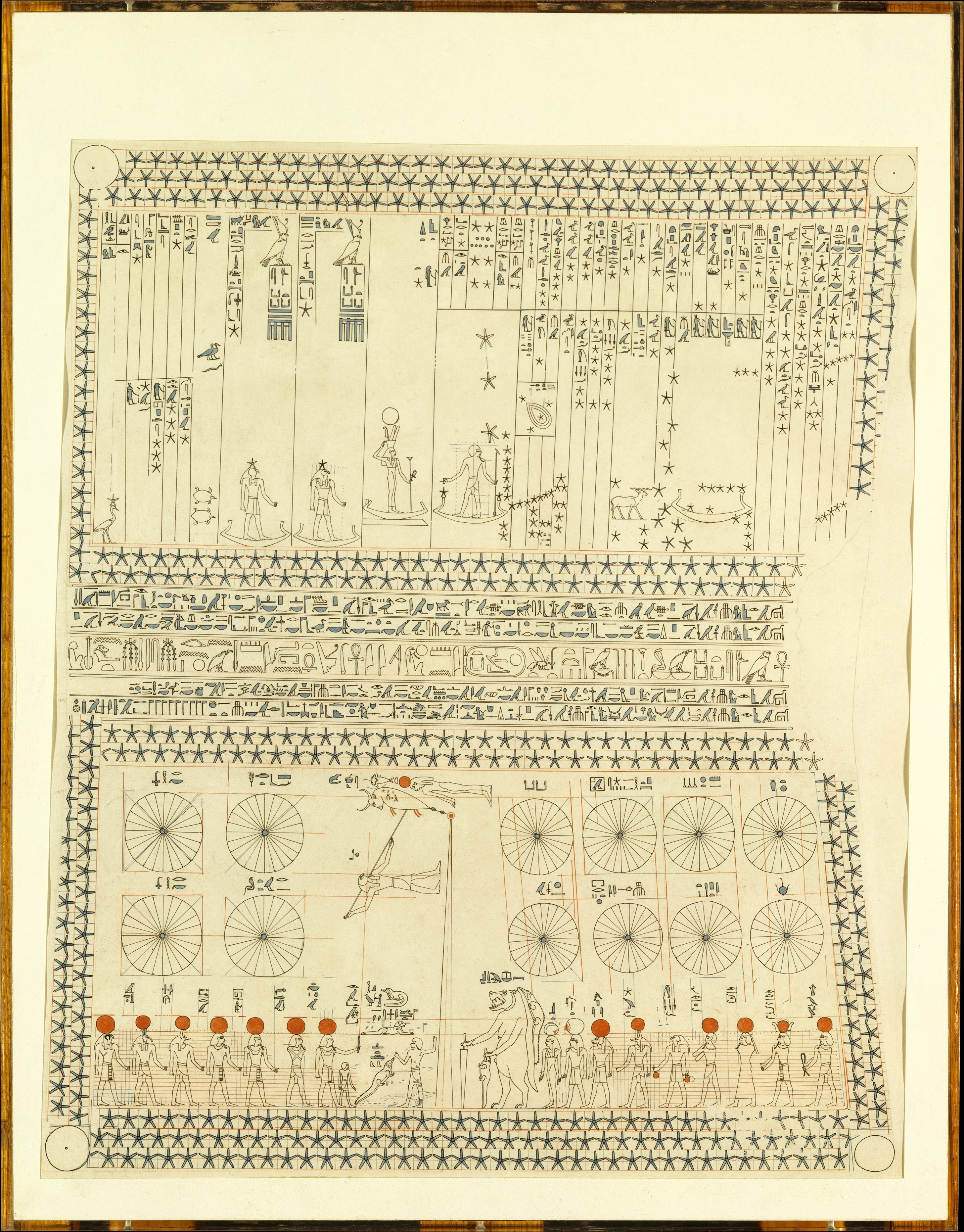
Astronomical ceiling of Senemut Tomb showing various decans, as well as the personified representations of stars and constellations
The decans (/ˈdɛkənz/; Egyptian bꜣktw or baktiu, "[those] connected with work"[1]) are 36 groups of stars (small constellations) used in the ancient Egyptian astronomy to conveniently divide the 360 degree ecliptic into 36 parts of 10 degrees each, both for theurgical and heliacal horological purposes. The decans each appeared, geocentrically, to rise consecutively on the horizon throughout each daily earth rotation. The rising of each decan marked the beginning of a new decanal "hour" (Greek hōra) of the night for the ancient Egyptians, and they were used as a sidereal star clock beginning by at least the 9th or 10th Dynasty (c. 2100 BCE).
Because a new decan also appears heliacally every ten days (that is, every ten days, a new decanic star group reappears in the eastern sky at dawn right before the Sun rises, after a period of being obscured by the Sun's light), the ancient Greeks called them dekanoi (δεκανοί; pl. of δεκανός dekanos) or "tenths".
Decans gave way to a lunar division of 27 or 28 lunar stations, also known as manzil, lunar mansions or nakshatras and thence to a zodiac of 12 signs, based on an anthropomorphic pattern of constellations,[2] and their use can be seen in the Dendera zodiac dated to circa 50 BCE.[3]
In India, the division of the zodiac into 36 ten degree portions is called either the drekkana (drekkāṇa), the dreshkana (dreṣkāṇa), or the drikana (dṛkāṇa).[24]
The iconography and use of the drekkanas is mention earliest by Sphujidhvaja in Yavanajataka (269–270 CE), and given detailed treatment by Varahamihira in his Brihat-Samhita (550 CE). Modern scholars believe the decans were imported into India through the Greeks, who learned about them from the Egyptians.[25]
(compare drekkana and decans)
I found a piece speaking about druids prohibiting their literature to be written down:
The Druids do
not go to war, nor pay tribute together with the rest;
they have an exemption from military service and a dispensation in
all matters. Induced by such great advantages, many embrace this profession
of their own accord, and [many] are sent to it by their parents and
relations. They are said there to learn by heart a great number of
verses; accordingly some remain in the course of training twenty years.
Nor do they regard it lawful to commit these to writing, though in
almost all other matters, in their public and private transactions,
they use Greek characters. That practice they seem to me to have adopted
for two reasons; because they neither desire their doctrines to be
divulged among the mass of the people, nor those who learn, to devote
themselves the less to the efforts of memory, relying on writing;
since it generally occurs to most men, that, in their dependence on
writing, they relax their diligence in learning thoroughly, and their
employment of the memory. They wish to inculcate this as one of their
leading tenets, that souls do not become extinct, but pass after death
from one body to another, and they think that men by this tenet are
in a great degree excited to valor, the fear of death being disregarded.
They likewise discuss and impart to the youth many things respecting
the stars and their motion, respecting the extent of the world and
of our earth, respecting the nature of things, respecting the power
and the majesty of the immortal gods.
and another account from a different source
and about something completely different:they have an exemption from military service and a dispensation in
all matters. Induced by such great advantages, many embrace this profession
of their own accord, and [many] are sent to it by their parents and
relations. They are said there to learn by heart a great number of
verses; accordingly some remain in the course of training twenty years.
Nor do they regard it lawful to commit these to writing, though in
almost all other matters, in their public and private transactions,
they use Greek characters. That practice they seem to me to have adopted
for two reasons; because they neither desire their doctrines to be
divulged among the mass of the people, nor those who learn, to devote
themselves the less to the efforts of memory, relying on writing;
since it generally occurs to most men, that, in their dependence on
writing, they relax their diligence in learning thoroughly, and their
employment of the memory. They wish to inculcate this as one of their
leading tenets, that souls do not become extinct, but pass after death
from one body to another, and they think that men by this tenet are
in a great degree excited to valor, the fear of death being disregarded.
They likewise discuss and impart to the youth many things respecting
the stars and their motion, respecting the extent of the world and
of our earth, respecting the nature of things, respecting the power
and the majesty of the immortal gods.
“The druids – that is what they call their magicians – hold nothing more sacred than the mistletoe and a tree on which it is growing, provided it is a hard-timbered oak….Mistletoe is rare and when found it is gathered with great ceremony, and particularly on the sixth day of the moon…. Hailing the moon in a native word that means ‘healing all things,’ they prepare a ritual sacrifice and banquet beneath a tree… A priest arrayed in white vestments climbs the tree and, with a golden sickle, cuts down the mistletoe, which is caught in a white cloak.” Pliny the Elder, 1st century, Roman historian.
Is ё where vav is, because u is often read as ё?
bank cards contain 16 digits, so that
16 of younger futhark (I take that writing system as a phenomenon disconnecting it from what was written about it, I disbelieve even the science, I know that it is also full of lies, and the only way to know which one is which is to do the research youself) demand 4×4 and thus remind me of ogham and maybe some shorter ogham, ogham of 4 strokes with 4 being double 2 or 1+3? I don't know, I only approached this idea. We'll probably see. So let's look at it.
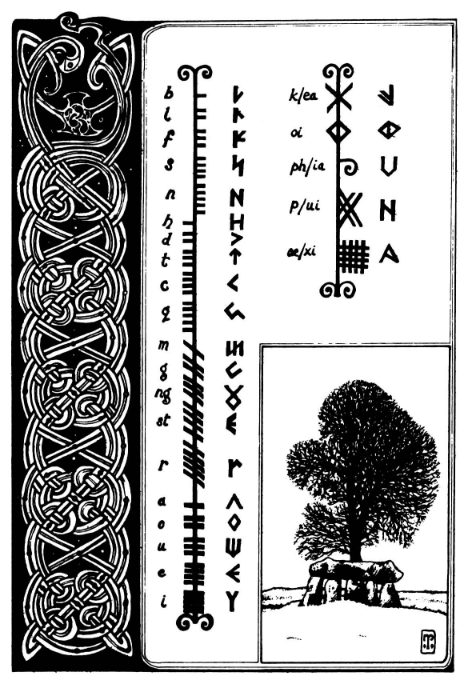
The standard Irish Ogham characters, compared with their Welsh Coelbren counterparts.
Katso myös in a language I didn't know was instantly recognize by me by their cognates kijken more (and that myös linked more to больше, and yes feel how deep that separation must be, that b is m, but they separated from russian before they parted ways with english, so now I feel that Western M is russian B. Different dialects were different lines. And if russian is B, but then it's not just russian, then were no russian, it is eastern european. And it's only natural for sun to start at the East. And if that E is of vegvisir, the opposite should be some staveless В for the Вест and how crazy is that that in russian it is Запад. So север is Шевер (and it begs a quetion: was ש шин зееруthe tooth and thus s, or does the name shin tells ш as the initial meaning, as russian ш reminding ש demands to be. And is south/юг some m[m] or т[т]? Some other language could be the key, and though it would be frowned upon my tendency to mix different languages may be justified by the protohistoric element of the described events, and by the sharing the culture amongsh languages. Vegvisir was it shared? It was so ancient in those ornaments Platov showed, so that I suspect them to be common among cultures. I even found yin yang in the european ornaments of triskelion, so why not dream the dream to see then if it's true. This dream is real, so it may come true. Either way, it is my quest and it delivers, so whether this particular hypothesis is justified or not, it is worth working this way. My mindflow is it a lesson to further readers
Listening to Kaddafi spekaing, I realize that the conflict is eternal and it is based even in the language itself. Such disgusting language, as if they vomit all the time. Some of the phonemes he uses are ones used by europeans only when they vomit, or very similar to those, or just heard to european ear (russian included) as if they are like some those. And of course it only highlights the conflict being inherent and thus eminent.ly inevitable.
eminent as eminem (probably that word is what MM hid in his neologism)
eminem is eminent
eminent as eminem
Could i and a tell the relation between the words? is in induction and as in deduction. and d meets a agian.
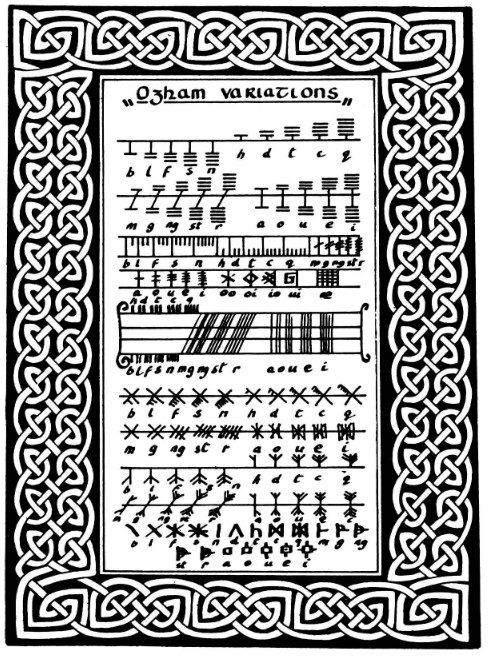
and that book to which I link does have plenty of interesting information

it is from Magical Alphabets by Nigel Pennick.
But then what he gives disagrees with what I learnt, that ⵓ is o, but now I see that it's u, ju and even w, and he gives this definition of it. And I probably confused ⵓ with ..
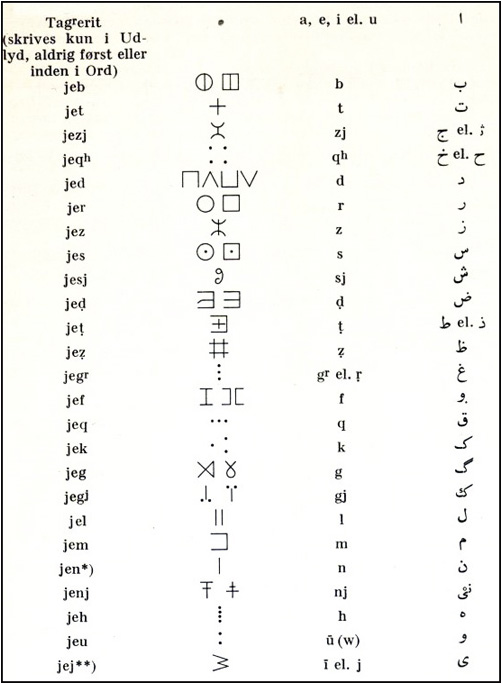
and to my surprise ⴰⴰ is nowhere to be seen, but ⵍ is l. and that l is double N the ⵏ, it seems l and N are related and one is a form of the other, but people of different tongues pronounced them differently and differently since they shared the symbols? They shared the symbols when n and l were the same letter?
And looking for answers I found something spectacular:

And link under that image is some good and brave research of similar nature:
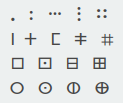 ⴰ ⵓ ⵈ ⵗ ⴾ ⵆ ⵂ ⵘ
ⴰ ⵓ ⵈ ⵗ ⴾ ⵆ ⵂ ⵘⵏⵜⴸⵦⴷⵝⵤⵃⵎⵡⵯⵠⵐⵊⵍⴳⴴⵢⵅⵌⵇⴽⴿⵉⴹⴺⴵⵖⵄ ⵟⴼ
ⵔⵙⵚⵕⵀⴱⵁⴲ (squares and circles are the same letters, and there they placed them separately there, I just thought to know better which I did not)
and then they also exclude many letters among those lines (I placed them in grey next to them)
And some shapes not even fit in any of those shapes: ⵑⴶⴻⵋⵒⵛⵞⵣⵥⵧ⵰ ⵿
but then I wonder if ⵑ/ⵏ ~ ⵙ/ⵔ and for that I need some larger chart:.. but then ⵑ being ŋ is nowhere to be seen in those tables, but wiktionary tells that it is ŋ, which makes sense since ⵏ is n. See, this is how I learn all those weird writing systems. But then how is s dotter r? I had thoughts that ᛲ is staveless ᚱ, and that Q is staveless R, but ..what? R is next to S btw. Imagine how it would look if I write latin alphabet in tifinage, they would be very systemic. And there's a systemic tifinagh canon:
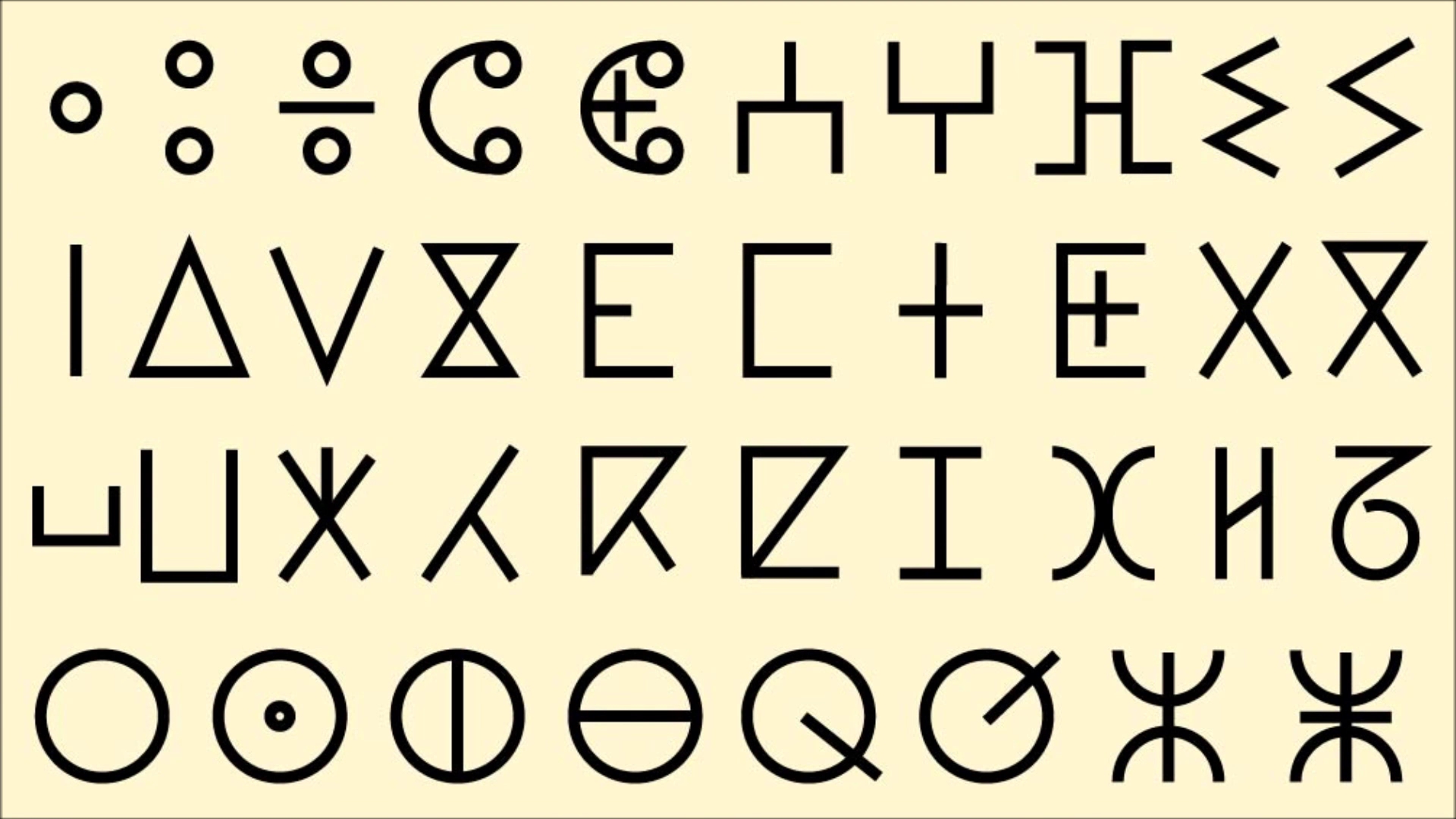
But nevertheless, let's try that latin tifinagh thing out:
ⴰⴱⵛⴷ
ⴻⴼⴳⵀ
ⵉⵊⴽⵍⵎⵏ
ⵓ ⵇⵔⵙⵜ
and closest to that is some other tifinagh sequence:

(notice that both tables start and end alike, thus they are not random, but actual traditions)
which is as they go in unicode with some omitions
ⴰⴱⴲⴳⴴⴵⴶⴷⴸⴹⴺⴻⴼⴽⴾⴿⵀⵁⵂⵃⵄⵅⵆⵇⵈⵉⵊⵋⵌⵍⵎⵏⵐⵑⵒⵓⵔⵕⵖⵗⵘⵙⵚⵛⵜⵝⵞⵟⵠⵡⵢⵣⵤⵥⵦⵧ⵰ ⵿ ⵯ
are miss and omit cognates? однокоренныеですか?
And I can see why I took ⵓ for o: it stands just after n, and at the
That ⵀ is there as it seems to be more primitive, but ⵃ reminds h much better, and it is important because many letters do. ⵜ is the brightest example of that.
But so are ⴱ~B, ⵛ~C, ⴷ~Δ,
ⴼ shown as ⵊ which looks like open ⴱ when they draw square instead of circle, and it makes me believe that circle is later bastardization, and that square is how it was supposed to be. And it is always shown in two parts, as ⵎ with it's reflection, and it also makes sense, because that is the third labial, and the only other labial is also like ⵎ, the ⵡ (ⵎ/ⵡ ~ M/W)
Some berber inscription may tell that crosses used as protecting amulet could imitate predator's paw:
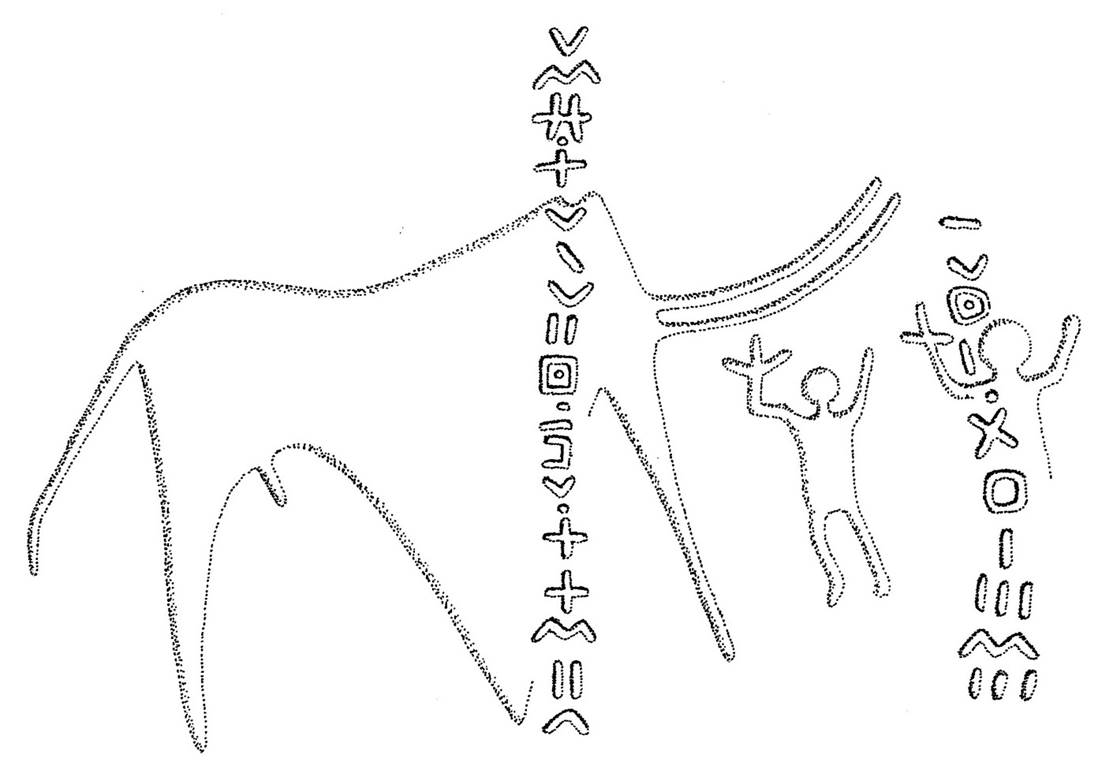
it looks ancient, but it is not necessarily ancient, because africans pretty puch preserved their primitive cultures.
ⴸ as a form of ⴷ, used to show somewhat stronger ⴷ, could be an influence of arabic.
And all this makes me believe that П is from the ⵎ/ⵡ set
it makes me wonder why ⵊ is recognized as f (see the second tifinagh image in this chapter) and as j everywhere else. At that second image ⵎ is also turned the other way around, so boustrophedon could be the reason that both were correct, and it may explain why letters are only inverted upside down (as runes and tarot can be, but to recognize this symbolism I need to speak amazigh)
Abracadabra is ABCDBA, a sequence combining both weastern and eastern alphabetic sequences.
(so it's just some alphabetic amulet)
Jesus and the Beatles didn't always practice what they preached.
(one taught to love thy enemies, but offended them and used force against them; others taught that all you need is love but were not able to love even each other)
But at least they preached those mighty things, thanks to them for that.
(that love is the light side of the power, that love is God, that god is Love)
Some interesting stuff I found yesterday:
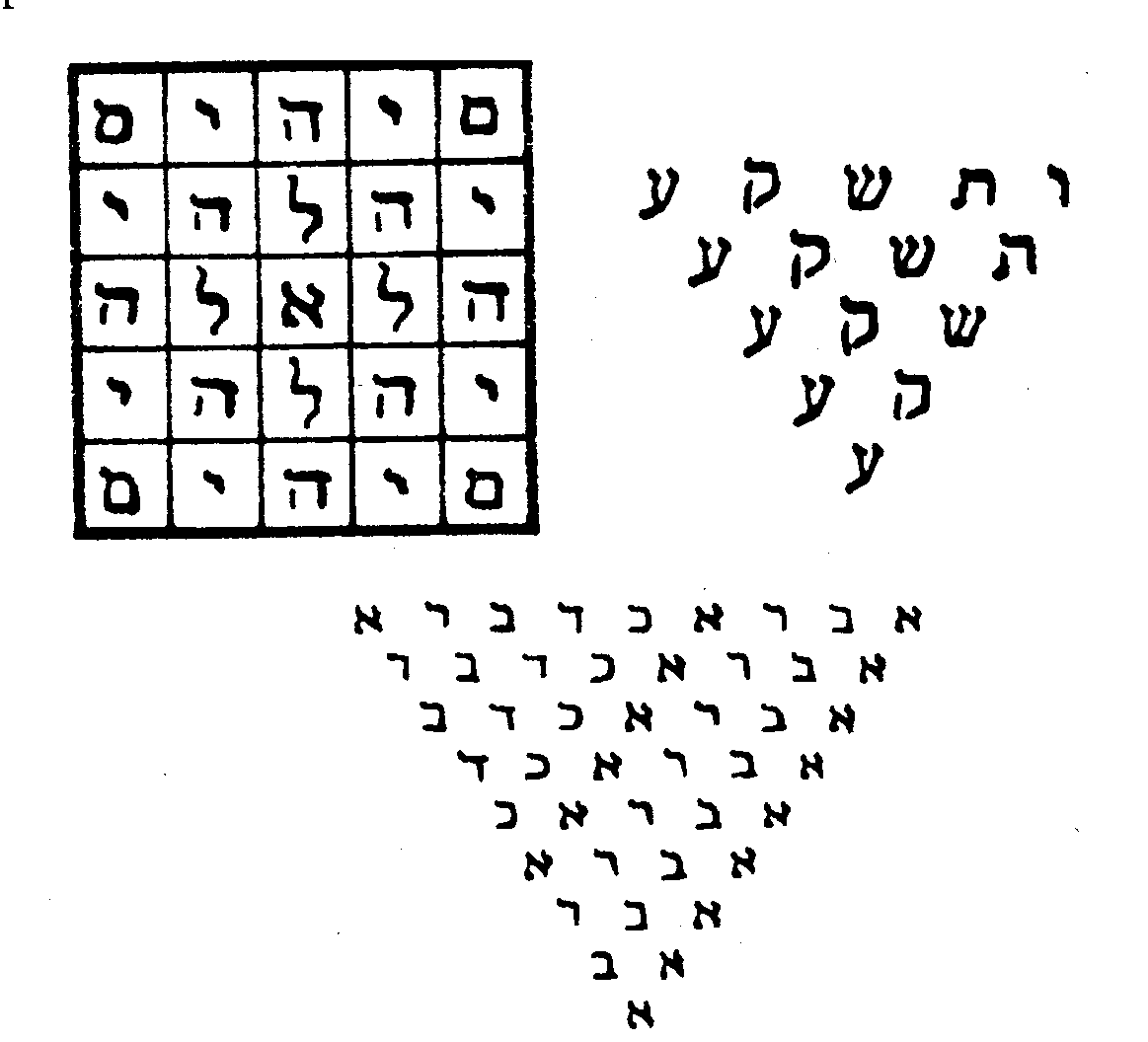
It is from the same book Magical Alphabets I mentioned yesterday, but forgot to look into this one which brought me to that book more precisely, and though I saw elohim going in all ways from the centre of the square, and abracadabra of the lower triangle (and this is when I noticed that this word is abcdba combining cdba of the east with abcd of the west. And Rah interwoven into it.
So let's now decypher the other triangle: they translated it as Ваттишки, and Pennick transliterated it as Wattish' ka, and g.t. translates ותשקע as "and drown" but the source, the book of Nigel Pennick does a better work: A similar, though smaller, downward-pointing triangle formula was used against fire. This used the Hebrew word 'Wattishk'a' (and the fire dwindled), referring to a passage from the book of Numbers:
And when the people complained, it displeased the Lord: and the Lord heard it; and his anger was kindled; and the fire of the Lord burnt among them, and consumed them that were in the uttermost parts of the camp. And the people cried unto Moses; and when Moses prayed unto the Lord, the fire was quenched.
such interpretation makes me believe that תש is cognatic to russian тушить, as if that amulet is a reminder in the form "а туши-ка". As the ring of Solomon was a reminder which was quite a spell.
Runglish sounds as wronglish, where lish is probably ling: Eng ling. But then I thought before it where I thought this thought without typing it: Is English lingwish? So is english ling-ling? bilingua? They're infamous for combining roman and german languages.
Мир ждёт золотой век как только ии увидит что патенты принадлежат не тем, кто сделал изобретение, а тем кто зарегистрировал патент. И как только оно сумеет перенаправить потоки от жуликов к творцам, так и засияет мир красками любящих мир творцов.
Because being a creator I hesitate to patent my invention about text-qr, for I believe those who use photoshop to paint artistic qr, and once I recoginized their trick, I inventyerd mine.
Nigel Pennick gives that myth as such:
One version of the legend comes down to us from the Roman
writer Caius Julius Hyginus, who was the curator of the
Paletine Library and a friend of the poet Ovid. In his Fables,
he wrote that the Fates invented the first seven of the Greek
letters. These were Alpha, Beta, Eta, Ypsilon, Iota, Omicron
and Tau.
source: http://libgen.rs/book/index.php?md5=48AB05D559B98A9DD0B5CDAF197B8F35
And 3d sephirot, I wonder is some of my hypothetic ones goes along these lines:
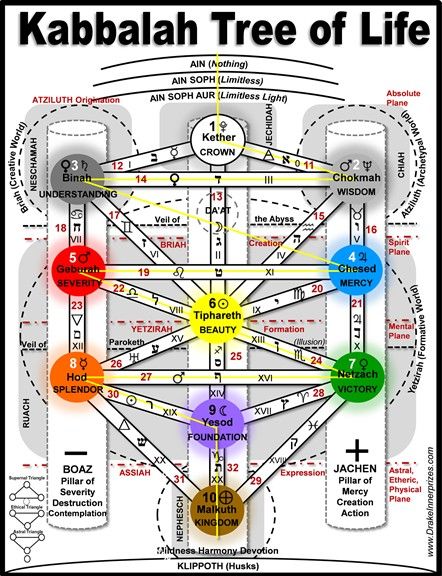
the following page makes me wonder even more if anything of the following is correct, but because it is alphabetic, just in case it is true, here:
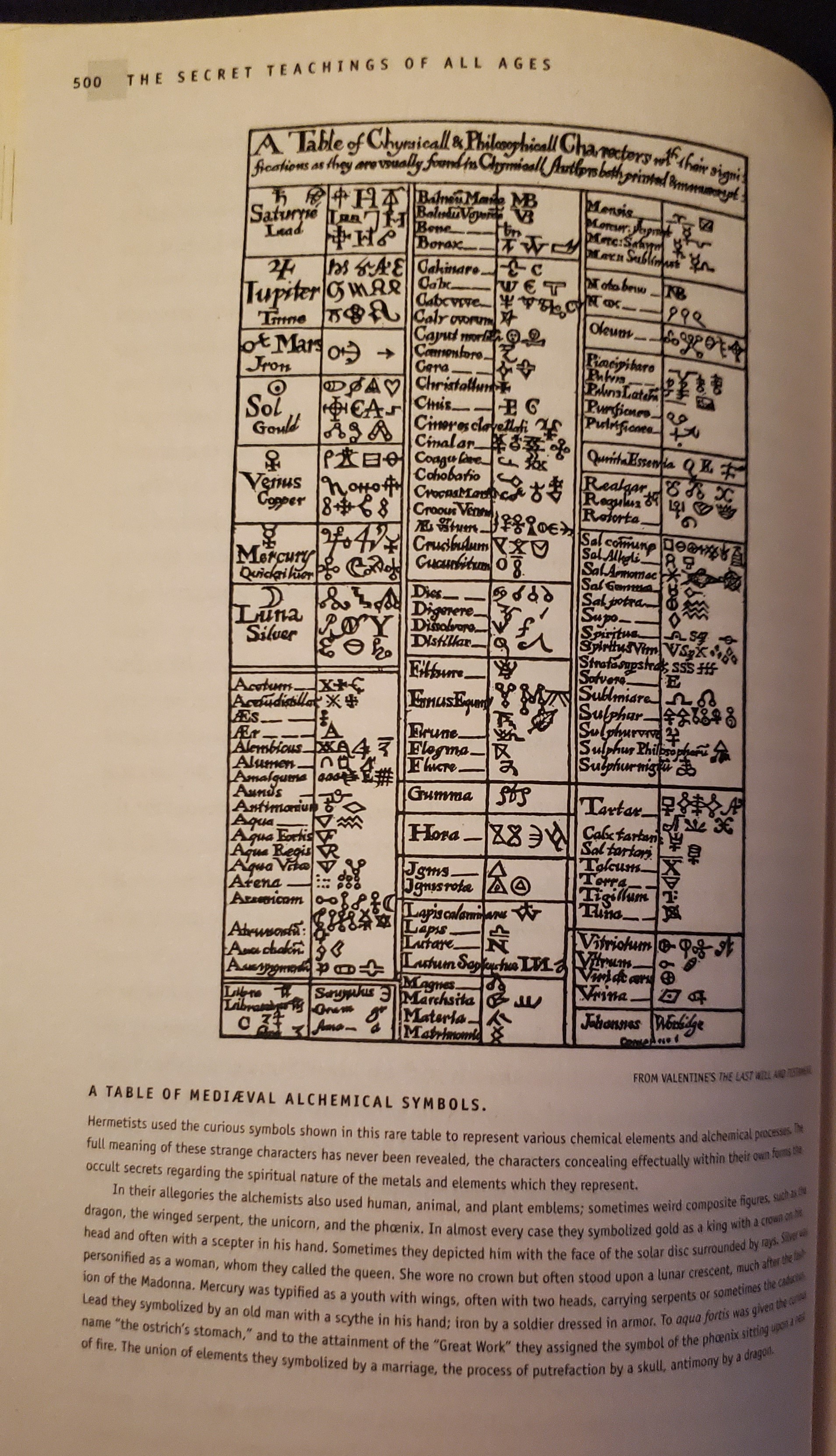
They say Old Turkic runes appeared only few centuries before russians were taught alphabert:
The Old Turkic script (also known as variously Göktürk script, Orkhon script, Orkhon-Yenisey script, Turkic runes) was the alphabet used by the Göktürks and other early Turkic khanates from the 8th to 10th centuries to record the Old Turkic language.[1]
The script is named after the Orkhon Valley in Mongolia where early 8th-century inscriptions were discovered in an 1889 expedition by Nikolai Yadrintsev.[2] These Orkhon inscriptions were published by Vasily Radlov and deciphered by the Danish philologist Vilhelm Thomsen in 1893.[3]
This writing system was later used within the Uyghur Khaganate. Additionally, a Yenisei variant is known from 9th-century Yenisei Kirghiz inscriptions, and it has likely cousins in the Talas Valley of Turkestan and the Old Hungarian alphabet of the 10th century. Words were usually written from right to left.
Both claims are naturally false and political, easily debunked by counter-argument "did they teach them all and nobody in that reason was literate?" naturally you could establish a school where you teach people your grammar, but that doesn't change the fact that people in the population are of different interests and skills.
And with old-turkic orkhon they messed up by not looking at its structure:
Orkhon sounds as Ogham, which sounds as something else ..amaziq? aicme! aicme~aet, читает? намекает? даёт? позволяет забирает вырубает отпускает попускает поучает убирает посылает подсыпает засыпает знает (но ковает не правильно, правильно куёт (суёт, поёт? поёт к пает, сувает?))
Адам?
аД before aM
aЗ бефор еМ
ем ~ am ~ be
a~б
(and ge'ez and tifinag sare that g of ogam and language and orkon is oгонь? most of the language are linguals, it is literally called tongue. it is this! tongue = язык~agni~огонь~огам Я ЗЫК, Я ЗЫŊ, I sing.
Я ЗЫŊ, Я ЗВО́НОК, Я SING, I (am) SONG, I (am) Saying (and russian do omit auxilary verbs)
Grammar is more than gramma,? gramma is gramata? granula? gram~gran, gradation, one grade on the scale.
so I got distracted.
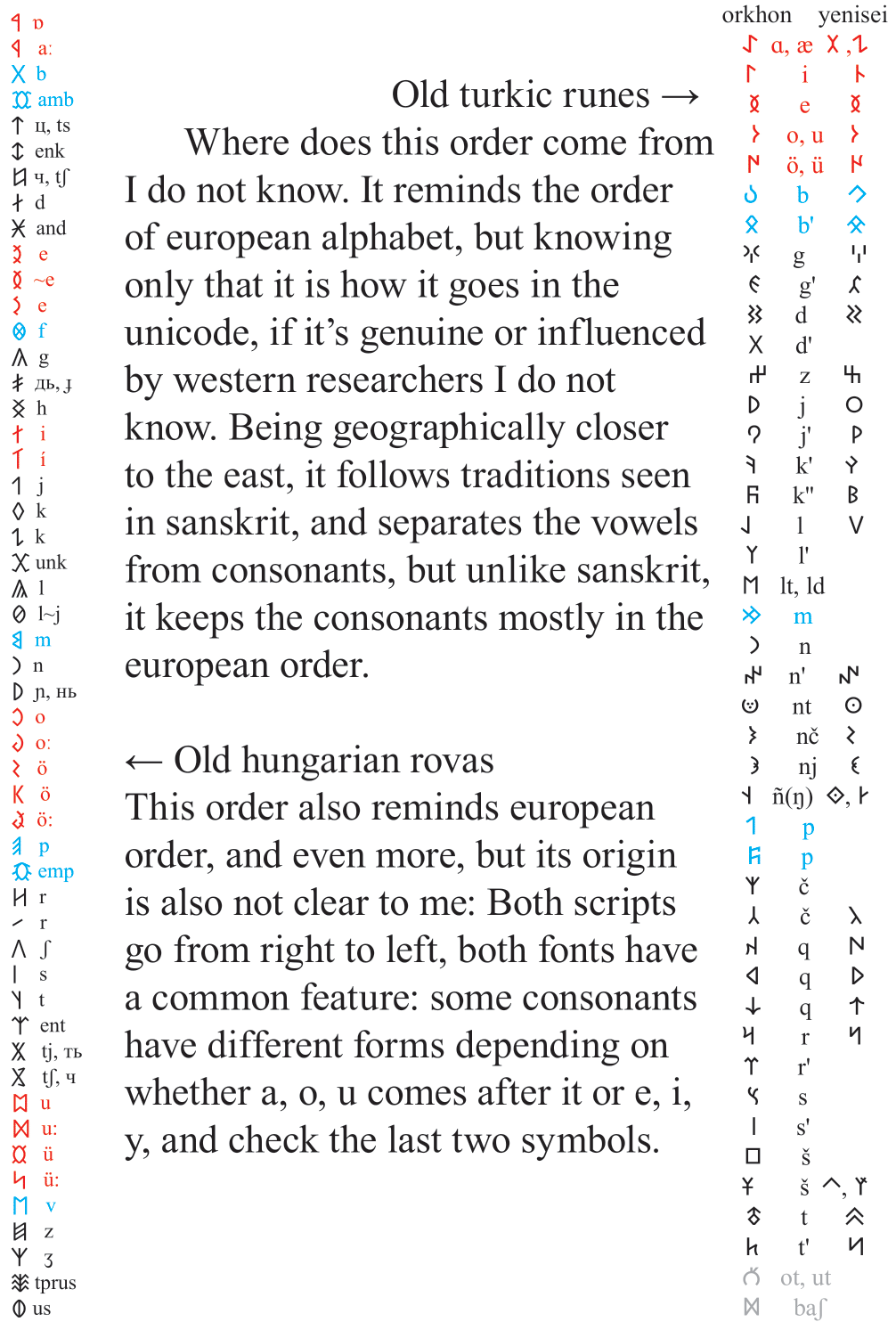
And here you can see how göktürk runes end at t, which was not in europe for centuries then, and they could be influenced by hebrew known by khazars, and then there probably were plenty of related writing systems now gone or yet to be dug out.
Hungarian rovas remind Norks runes much:
𐲀[ɒ] ~ [a]ᚨ 𐲁[a:] ~ [æː]ᚫ
𐲄[ts] ~ [t]ᛏ
𐲆[tʃ] ~ [h]ᚻ
𐲇[d] ~ [n]ᚾ (the variant I used, ᚿ, is called short twig) compare: 𐲚[ɲ, нь] ~ [d]ᚦ (but not inverted)
𐲒[j] ~ [l]ᛚ (because sometimes ll[j])
𐲓[k] ~ [ŋ]ᛜ, ᛝ
𐲖[l] ~ [w]ᚥ (because ł[w])
𐲘[m] ~ [b]ᛒ (this pair definitely approves of d~n pair, norsk are more nasal at n, and rovas are at m)
𐲢[r] ~ [h]ᚺ
𐲣[r] ~ [r]ᛧ
𐲥[s] ~ [s]ᛌ
𐲦[t] ~ [k]ᚴ (and maybe [t]ᛐ too)
𐲧[ent] ~ [ea]ᛠ
𐲰[ʒ] ~ [z]ᛉ
and maybe even 𐲥[s] ~ [s]ᛌ
but hardly any of these pairs
𐲔[k] ~ [eo]ᛇ
𐲫[u:] ~ [d]ᛞ
𐲭[ü:] ~ [sh]ᛲ (and нет не знаю сх это или ш, ск переходит в ш, так что может быть зависит от диалекта)
𐲮[v] ~ [e]ᛖ
So my claim in the booklet that hardly many runes have similar values in norsk and hunnic, after all too many are similar to claim that, even though I wanted to say that it's justified. Only at first sight.
𐲰[ʒ] ~ [z]ᛉ is a spectacular similarity, but as Y is borrowed from greek, still called greek, the same process could take place between runes and rovas.
Ohkhon and Yenisey are geographically further and I say they have much less similarities:
But this claim is also false:
𐰀[ɑ, æ] ~ [eo]ᛇ (I wondered why isn't it invereted until I saw yenisey variant: 𐰁)
𐰄[i] ~ [a]ᛆ (I saw that I~ا variability before)
but haredly these:
𐰅 [e] ~ [ŋ]ᛝ
𐰇 [ö, ü] ~ [sh]ᛲ but it perfectly reminds hungarian 𐰇 [ö, ü] ~ 𐲭[ü:]
𐰉 [b] 𐰊 also only remind hungarian: 𐲜 [oː], though not precisely, both are labial, but no norsk form.
but in this context (𐰌)𐰋[b'] reminds [o]ᛟ exactly, and this story relates these to ones from the previous line.
𐰑𐰒[/d/ and /ð/, used with back vowels.] are not too far from ᛋᛋ, ᛲᛲ, ᛊᛊ, ᛵᛵ
And that ᛊ does remind those arkhon and yenisei runes that it also can be both:
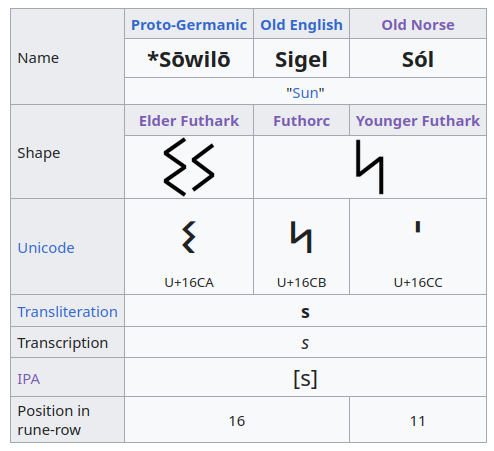
𐰆𐰆[o, u] ~ direct descent from ugaritic 𐎓[o]
𐰓[d'] is hardly [j]ᚷ but then it is named ġifu, gift, and g is closer to д, and in russian it is дар.
(were presents hidden with the maps given as presents? and thus cross could be that gift/дар)
give ~ davai (davai~davi? do?!)
vol.1 delivers, and I almost forgot this:
3. The ancient Irish alphabet, like that used by the Gallic druids of whom Caesar wrote, might not at first be written down, and all its letters were named after trees. It was called the Beth-luis-nion (‘birch-rowan-ash’) after its first three consonants; and its canon, which suggests a Phrygian provenience, corresponded with the Pelasgian and the Latin alphabets, namely thirteen consonants and five vowels. The original order was A, B, L, N, O, F, S, H, U, D, T, C, E, M, G, Ng or Gn, R, I, which is likely also to have been the order used by Hermes.
A B L N
O F S H
U D T C
E M G Ŋ R I
Interesting, that labials always follow vowels, but there is only 3 labials for 5 vowels. But what if U is labial, and H is vowel?
A B L N
O F S
H U D T C
E M G Ŋ R I
and then vol.1 goes on:

Interesting, that this 13-month calendar doesn't use vowels, and it also doesn't use 5ths shapes except the nion it places third. Was that ash a later addition turning 12-month calendar into 13-month one? I would suspect it to be the other way around, but what do I know..
Amour as the first god has very interesting name, standing in one line with AMS and AMT.
Here three rightmost variants may be a rudiment of vertical writing:

Which made me sugest the more ancient form of Ю than of B: is В[w] double ю?
But then wouldn't Б be гю? But then B is also not юю, but I can understand the logic of W being Юю
today we quote reddit of all places: You might be thinking of IAO, aka the Tetragrammaton, the Greek form of the name of YHW (Yahweh). (which exhibits IAO the descending triad, the prototype of pentatonic scale)
and from there I went to https://www.gnosisforall.com/about-16 which has this:
SETHIAN VOCES MYSTICAE
Gnostic Mantras?
'Mantra' obviously refers to the ritual chants of the Dharmic religions, but the term is not entirely out of place here either. Below is a compilation of the so-called vowel chants found dispersed throughout the surviving Sethian Gnostic texts, also known as glossolalia, or voces magicae. These intonations can be found in both early and late Sethian texts meaning that they formed an integral part of the Sethian ritual or meditative traditions from beginning to end. They were a way to encode a sacred meaning in a seemingly meaningless, 'alien', set of ritual sounds. From the way they are written in the texts themselves it seems that they were intended to be spoken in a drawn out fashion and seem to have formed a part of both prayer, baptism, and meditative journeys of ascent to the Pleroma.
There are a few more than we have included here (mainly very short minor examples who's meanings are not known), which can for the most part be found in the Holy Book of The Great Invisible Spirit. These chants all occur at specific points in their respective texts so for more context see our Ancient Gnostic Scriptures page. Scholars who's work has been consulted for the below are Mervin Meyer, Willis Barnstone, John Turner, Birger Pearson, and F. Lamplugh.
For a vivid, if experimental, example of these chants in use see the Gnosis in Rhythm and Song project orchestrated by Prof April Deconick with the aim of recreating some of the original format that they may have had.
IIIIIIIIIIIIIIIIIIIIII
EEEEEEEEEEEEEEEEEEEEEE
OOOOOOOOOOOOOOOOOOOOOO
UUUUUUUUUUUUUUUUUUUUUU
EEEEEEEEEEEEEEEEEEEEEE
AAAAAAAAAAAAAAAAAAAAAA
OOOOOOOOOOOOOOOOOOOOOO
Taken from the Holy Book of The Great Invisible Spirit. It is this chant that the Mother (Barbelo), the Son (the Triple Male Child, an upper reflection of Autogenes/Christ in the parlance of this text, or the 'Great Christ') offer in praise of the Great Invisible Spirit that came before them. The meaning of this chant is likely 'IEOU', as a reference to the highest God, E as shorthand for estin meaning 'is' in Greek, followed by A = Alpha, then O = Omega. So the chant effectively means 'The Father is the beginning and the end'. This chant occurs more than once in the text.
You are one,
You are one,
You are one,
EA EA EA
Taken from the Holy Book of The Great Invisible Spirit, and chanted in honour of the primordial heavenly Adamas upon his emanation by Autogenes (Christ/the Logos) and Mirothea (an obscure female aeon who may simply be the female half of Autogenes). The first three lines are written in Coptic as with the rest of the text, but the last line represents the Greek ei a, ei a, ei a which itself again means 'You are one, you are one, you are one'.
EI AAAA OOOO
Taken from The Holy Book of The Great Invisible Spirit, from the 'baptismal hymn' at the end of the text along with a few other very short examples. Its meaning comes from Greek again and simply means 'You are alpha (four times) omega (four times).
IEA AIO
Also taken from the 'Baptismal Hymn' at the end of The Holy Book of The Great Invisible Spirit, this intonation seems to be a play on the Greek word for aeon (aion).
PHOE ZOE ZEOE ZEOE ZOSI ZAO ZEOOO ZESEN ZESEN!
The individuals and the Four who are eightfold are alive!
EOOOO EA EO!
Taken from Zostrianos during the protagonist's spiritual ascent, the first line seems to be an ecstatic exclamation playing on various alterations of Zoe 'life' (also the name of the daughter of Sophia) and Zao 'to live'. The second line is likely a reference to the Sethian Four Luminaries (and their female halves). In most Sethian texts the Four Luminaries are a group of high aeons which either contain or emanate other aeons, they usually come from and are beneath the Autogenes aeon (the Son) however in Zostrianos there is also a second set of Luminaries, higher still within the aeon of Barbelo. The last line may mean 'May he be' four times in which the 'O' represents the Greek masculine (for the Four Luminaries), followed by 'May he be first, may he be last'.
MA MO
OOO EI
A EI
ON EI!
Taken from the Trimorphic Protennoia, it forms part of a hymn sung by the aeons to the Son, Autogenes, from whom they have just been emanated. The meaning is likely MA MO as abbreviations for Mirothea and Mirotheo (Mirothea is a female counterpart of Autogenes in some Sethian texts, it is from Mirothea and Autogenes that the heavenly Adamas is emanated) followed by the Greek o o o ei, 'You are three times omega/last', a ei on ei, 'You are alpha/first, you are he who is'.
Holy, Holy , Holy, AAA, HHH, EEE, III, OOO, YYY, OOO
Taken from the so-called 'Untitled Apocalypse' or the 'Gnosis of The Light', the meaning of this sequence as it was understood by the writers of this text is actually in the work itself: 'Thou art the Living One of Living Ones, Holy of Holies, Being of Beings, Father of Fathers, God of Gods, Lord of Lords, Space of Spaces'. This chant is addressed to the heavenly Seth, or 'Setheus', who has a prominent place in this text.
Obvious transliteration of greek myths, but maybe something else is interesting, at that reddit thread somebody compared catharic aeiou to aum, and it is interesting, because om is also descending, but it lacks the higher notes. Is it something even predating the triad of IAO?
But then I probably shouldn't promote that site, it is neither safe nor sane, here's a good overview:

And because whole this part was written without having smoken first, I think I should make a rule not to write into this thing withouth getting high first.
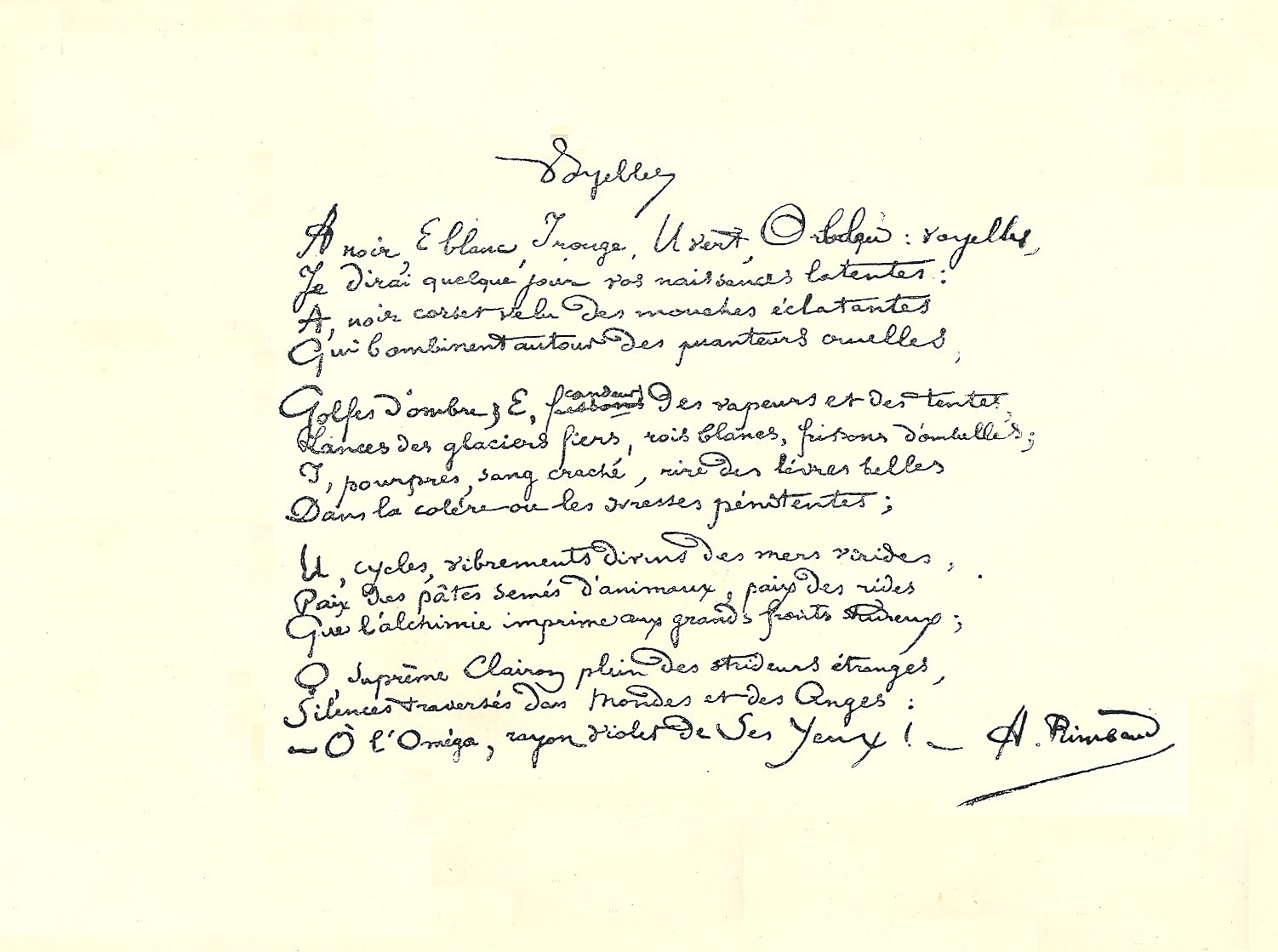
In his own handwriting, V is double o, and o is single o. Which corresponds oo giving us U, and ee gave us I and then aa gave us o.
o is a simple open mouth, very understood. So I call this maru, both dot (as in hebrew) and round as in o.
oo = a? but then why it is o, that looks like Ⰻ? but to my surprise it is i! and also a vowel! and o I was thinking of is ..Ⱁ! Like wtf.
Looking into glagolic names of letters I see BC in buki, and vede tells me it used to be both b and d. and both are B[b] and В[v] and their other halves are g and д (б and g) ~ (β and д (and duality of β makes me go woah! ))
be~do, inevitably there was time when we didn't feel the difference. Then language was rhythm and ogham depicted something of the kind. Зарубки на предметах старины - это база данных ещё одна отдельная от письменных памятников. И это отдел какого-нибудь всемирного архива какими нибудь специалистами-энтузиастами в разных частях света, не внёсших себя ни в какие каталоги, такой каталог (пусть даже неполный) мне имеет смысл создать для всеобщего представления.
and it's read vw
Je vois [жэ вуа́] вижу (жу! и ру в беру? а́ру о́рэ! жу в вяжу? ж разве не от з? её je thou? иh (both Ich und их))
Je veux [жо ву́] хочу
разница меж вижу и хочу в той а (без фонетизации (в орфографии) это не видно)
and if that a is english one, then people look and don't take (don't touch) when they want only one of the situation, when they see both tiger and grapes, they want to get grapes not being eaten by the tiger.
takes has that crossing dash over look (I learn to ignore orthography, I think I should go in both kiddi alfabet and phonetic writings.
which is ui..
a b g d
e v j z
i m n l
o p q t
u f h s
twently as fingers we have. are n to s on our feet? but nlopq and tufhs would leave trace in languages, and I don't see such. If such thing was, it could be f & t, l & g, n & g, p & s (pieds (and I wasn't certain about it, for ds is not read in phonetization, it's just пье (with and without s it is read the same (and withouth ..I would write d if I wa.. lloke.. looked into that dictionaries, buit p&s~f&t, but then p&s~f&d p&d~f&t))))
P.S (pleasant surprise)
voie [вуа́] way
vowels~выи?
шеи от слова воют? трубы?
creatrue
glagolitic script is very interesting in those balls:
ⰀⰁⰂⰃⰄⰅⰆⰇⰈⰉⰊⰋⰌⰍⰎⰏⰐⰑⰒⰓⰔⰕⰖⰗⰘⰙⰚⰛⰜⰝⰞⰟⰠⰡⰢⰣⰤⰥⰦⰧⰨⰩⰪⰫⰬⰭⰮ
ⰋⰑⰖ
Ⱆ is u, oo, ⰑⰑ
and no wonder I've mistaken

what is that blue part unicode only knows? or my browsers only depict it that way?
oo the u is

and being the first obviously double letter, it makes sense that it stands after t, where it ends in hebrew and other archaic sets
and that i(Ⰻ) can be seen in ь and ъ: ⰟⰠ, and though that link names them yeru and yeri, those u and i are not pronounced, they just indicate if r is unpalatalized or palatalized, what those symbols actually do, work as those unpronounced u and i, and the attached elements could be o and i, and that would make perfect sense, for oi after consonant makes sure the consonant is not palatalized, and ii after consonant may indicate its palatalization.
And another moment I can only show by image:

so as with orkhon and yenisei gokturk, we must recognize two traditions (until we find the third) for they don't even necessarily have the same abecedary sequence, for the left one graphically doesn't even recognize fert and fita different letters.
and it didn't take long till I found third, similar to the first one, which unicode is, but shows some bells, and thus Ⰻ[i] is probably double bell, which can only be if bells are small.

and here I can see that those two systems I looked at before are different in this representation
So should I leave glagolic to croatians who at least use it in their daily life? I probably should.
and because Ⰷ reminds ⴾ it made me want to compare glagolic to tifinagh,

but this vague similarity seems to be a coincidence, though it is interesting that vowel placed first is one dot, and u is two dots, and that three dots is k and that four dots is h goes along the eastern order with k being the first consonant, and then it makes me wonder if that sequence went on or was that it. two vowels and two consonants, in the light of b and d being the same that would be plosive and fricative with hue depending on the vowel. Then ku would be b, ki would be d, for u is labial and i is lingual, and then hu would be f and hi'd be h, but then ⴰ and ⵓ are a and u, not i and u. Well, if there were only two vowels, how would I tell?
Also because I found 33 square as a basis of the alphabet, tic tac toe caught my attention and the way vowels are distributed in that name is descending triad I mentioned earlier.
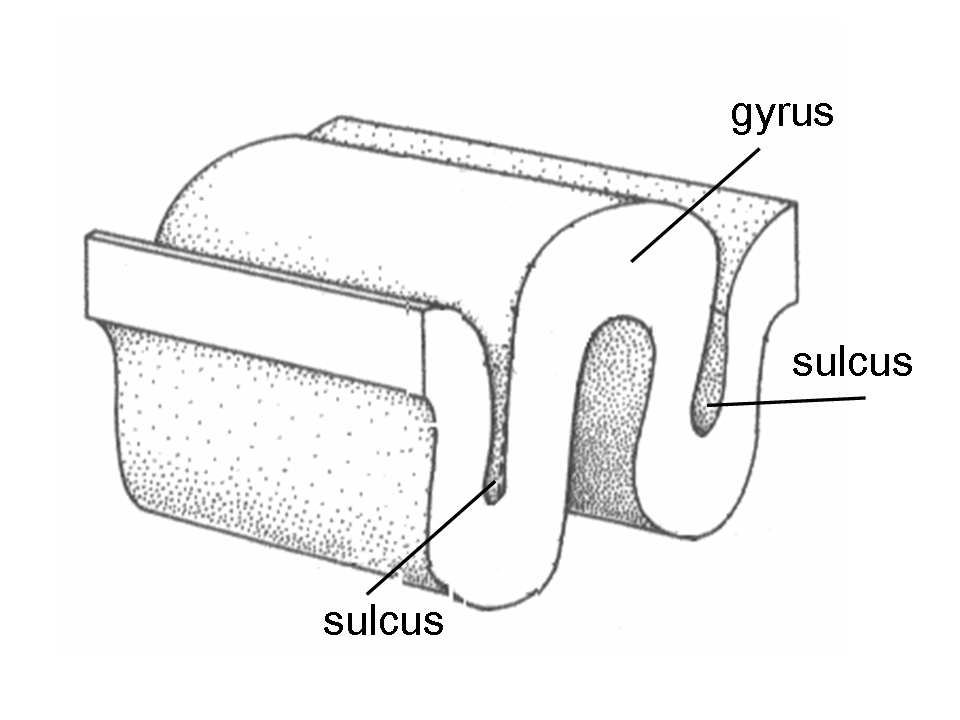
Am I digging just one sulcus. I always heard word извилина, я никогда не называл её бороздой, бородой, и не стану, извилины это извилистые дорожки углублений в мозгах. Fuck
В нейроанатомии изви́лина (лат. gyrus, множ. gyri) — выступы (складки), лежащие между бороздами (углублениями) на поверхности полушарий конечного мозга.
Я просто не знал терминологии, но я буду называть углубление извилиной, слово борозды никто кроме узких специалистов и не понял бы. Нужно говорить на более широкую аудиторию. Иногда.
Всегда. Никаких секретов. То что поймёт широкая аудитория специалисты тоже поймут.
Complete sulcus is very deep so as to cause elevation in the walls of the lateral ventricle. Examples are the collateral and calcarine sulci.
Incomplete sulci are superficially situated and are not very deep, E.g. paracentral sulcus.
as one would say, understand this, wide audience.
What I understand is they placed complete sulci in singular, and then I read of anomalies of their developmen and that's it, enough of neurophysiology for me. But then I understood, that removal of skull will not make my brains larger, but it can cause its inflation and disconnecting of the synapses. It would be a very funny ending of a sci-fi boo, but such book would be antiscientific. But it still can become a bright moment in a sci-fi book, describing the outcomes of models we may even ask our new friends to calculate.
Cadmus is
An oracle told Aeetes, son of Helios, that he would keep his kingdom as long as the fleece which Phrixus had dedicated remained at the shrine of Ares. When the ship was brought into port, Jason repaired to Aeetes, and setting forth the charge laid on him by Pelias invited him to give him the fleece. The other promised to give it if single-handed he yoked with adamant the brazen-footed bulls. These were two wild bulls of enormous size that he had got as a gift of Hephaestus; they had brazen feet and puffed flames from their mouths and nostrils. These creatures Aeetes ordered him to yoke and plow, and to sow from a helmet the dragon's teeth; for he had got from Athena half of the dragon's teeth which Cadmus sowed in Thebes. These tribe of armed men should arise and slay each other. While Jason puzzled how he could yoke the bulls, Hera wished to save him because once when she had come to a river and wished to test the minds of men, she assumed an old woman's form, and asked to be carried across. He had carried her across when others who had passed over despised her. And so, since she knew that Jason could not perform the commands without help of Medea, she asked Aphrodite to inspire Medea, daughter of Aeetes and the Oceanid Idyia, with love.
At Aphrodite's instigation, the witch conceived a passion for the man. Fearing that Jason might be destroyed by the bulls, she, keeping the thing from her father, promised to help him yoke the bulls and deliver the fleece to him. Medea also asked the hero to swear to have her become his wife and take her with him on the voyage to Greece. When Jason swore to do so, she aided him to be freed from all danger, for she gave him a drug with which she bade him anoint his shield, spear, and body when he was about to yoke the bulls; for she said that, anointed with it, for a single day he could be harmed neither by fire nor by iron. She signified to him that when the teeth were sown, armed men would spring up from the ground against him; and when he saw a knot of them he was to throw stones into their midst from a distance. When the men fought each other about that, he was taken to kill them. On hearing that, Jason anointed himself with the drug. He arrived to the grove of the temple and sought the bulls. And, even though they charged him with a flame of fire, he managed to yoke them. Then, when he had sown the teeth, armed men rose from the ground; and where he saw several together, he pelted them unseen with stones, and when they fought each other, he drew near and slew them. However, though the bulls were yoked, Aeetes did not give Jason the fleece for he wished to burn down the Argo and kill the crew. But before he could do so, Medea brought Jason by night to the shrine. Having lulled the dragon that guarded it to sleep with her drugs, she possessed herself of the fleece. In Jason's company, she came to the Argo, and the Argonauts put to sea by night to set off to their country.[52]
Absyrtus
Medea was attended by her brother Apsyrtus when they escaped from Colchis. When he discovered the daring deeds done by Medea, he started off in pursuit of the ship. Medea noticed her brother's ship and murdered him. Then, she cut his body limb from limb and threw the pieces into the deep. Gathering his child's limbs, Aeetes fell behind in the pursuit; wherefore he turned back, and, having buried the rescued limbs of his child, he called the place Tomi. He sent out many of the Colchians to search for the Argo, threatening that if they did not bring Medea to him, they should suffer the punishment due to her; so they separated and pursued the search in diverse places. When the Argonauts were already sailing past the Eridanus river, Zeus, in his anger at the murder of Apsyrtus, sent a furious storm upon them which drove them out of their course. And, as they were sailing past the Apsyrtides Islands, the ship spoke, saying that the wrath of Zeus would not cease unless they journeyed to Ausonia and were purified by Circe for the murder of Apsyrtus. So when they had sailed past the Ligurian and Celtic nations and had voyaged through the Sardinian Sea, they skirted Tyrrhenia and came to Aeaea, where they supplicated Circe and were purified.
I thought Aeetes was a spectacular name. What about Aeaea?!
That incredible story of argonauts is probably the allegory, but looking for argonauts as allegory I only found some queer publications without any relation to the subject, and other finds didn't speak about the description of the travel as something else. What was the teeth of dragon which was killed by Cadmus himself!? What was the meaning of other incredible events and names and events?
The German key notation differs from the English system in two respects, namely that B♮ is referred to by the letter H and B♭ by the letter B by itself, and that sharp and flat designations do not use words but suffix is for sharps and suffix es (reduced to s if the tone letter is a vowel) for flats, except that (as already mentioned) in the German system the letter B by itself already means B flat. However, in some places where the German system is in use one may encounter the use of B for B♮ and Bes for B♭. This is especially common in the Netherlands.
I wonder if that H was invented by BACH to play his name as BbACB, Bes ACB

(this table is not complete, because russians also use ABCDEFG, only they use it in the german way, wiht H)
japanese ABCDEFG are i-ro-ha-ni-ho-he-to, which is the iroha order, ending with to which is and and ten: と[to] and 十[to:]
korean ABCDEFG is ga-na-da-ra-ma-ba-sa, which reminds (or rather is) the order of eastern syllabaries
and where did I see si as ti?
B, also known as Si, Ti, or, in some European countries, H, is the seventh note and the twelfth semitone of the fixed-Do solfège. Its enharmonic equivalents are C♭ (C-flat) and Adouble sharp (A-double sharp).
in Germany, Central and Eastern Europe, and Scandinavia, the label B is sometimes used for what, above, is called B-flat, and the note a semitone below C is called H. This makes possible certain spellings which are otherwise impossible, such as the BACH motif and the DSCH motif (the latter of which also uses the "S" name for what in Anglophone would be E-flat).
So it seems there was an attempt to arange letters to semitones. I wonder what that was about and where did it go. And I could only find something else:

but then there also was this:
During the first quarter of the 20th century, American author and occultist Paul Foster Case established an esoteric musical cryptogram for the purposes of ceremonial magick. The system was a derivative of a cipher used by an affiliated magical order called the Hermetic Order of the Golden Dawn.[10] Each note of the 12 tone system was assigned a set of correspondences including colors, planets, zodiacal signs, and Hebrew letters. The holy names of biblical characters were translated letter by letter into a linear sequence of musical notes, so that each letter could be sung by the congregation in unison.
may this 20th century confuse you knot, for nobody knows where they took that system. They could easily invent it anew, but otherwise they could do too.

Colors (Queens Scale) and Notes that corresponding to the Hebrew letters in certain Hermetic traditions
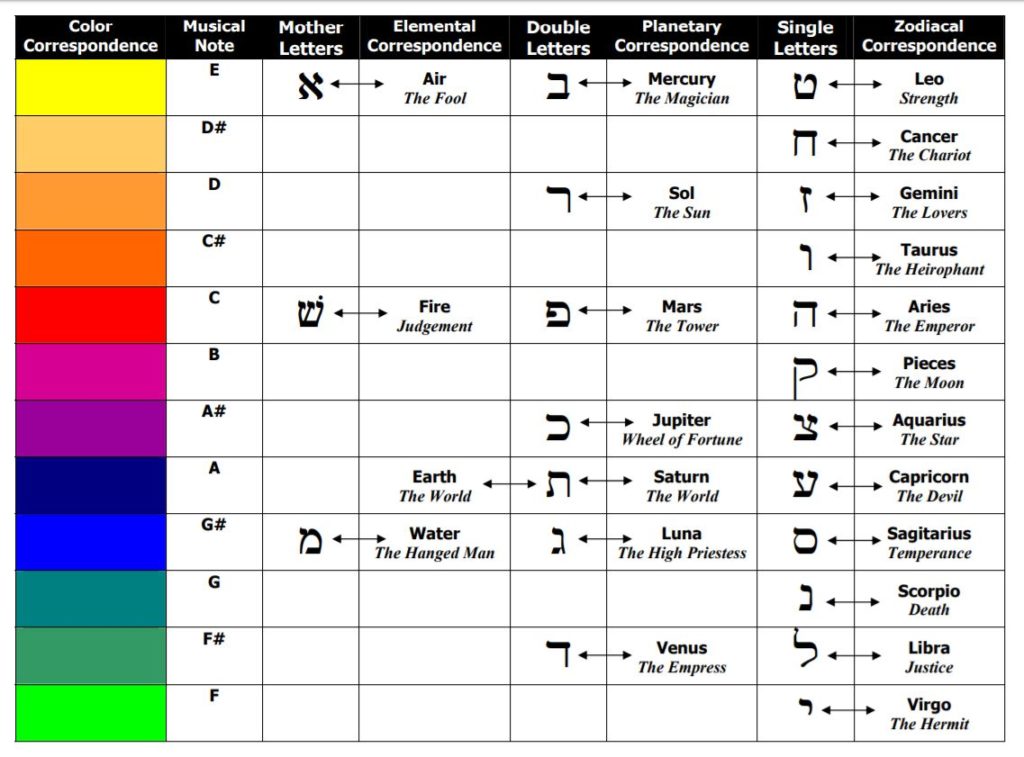
Color (Queens Scale) , Tone and Letter Correspondences in more detail
It is interesting that they call the rainbow range Queen's Scale, because if you look at it from letter C, it is regular rainbow sequence (with some additional colours) the sequence used as their symbol by "queens" and it is hilarious, that negros steal this word from gays. Too hated groups fighting each other.
I have little idea how they built these tables (maybe should read links under those images to know more) but what is interesting is the way those three mothers are read now as Shma (listen) if you recognize the gamut beginning at C. But then it places Leo at the very top, as the king of beasts deserves, and because I am Leo it pleases me very much, but how does it begin? Whith the spirit or with fire? Is spirit the product of Fire and Water? Or were those two born by the Æther? But then I have too many questions: How not fire, but air corresponds Leo? How can Sun stand where Gemini and not Leo do?
So because it's some esoteric mumbo-jumbo, take it with a grain of salt, a grain or two.
Neew moon is No moon
Luna Moon Noon? Noone?
☽︎◯☾ or ☽︎◯⬤?
and because l is L, ☾◯⬤?
is ᛚᛘᚿ ~☽︎◯☾?
won and own as the opposites of no and know (знаю это ещё не имею, даже не умею (знаю=смею? осмеливаюсь? не факт что получится, но сумелость есть. мело язык как помело? смел съел? смел взял(ся) и вызвал(ся) это всё перебор? подбор но не рифмы а прочих созвучий, более коренных))
Reversive alphabet strikes again: ю is b, B is bb, bouble b is long b is fricative b
В[v]~W
thus V~b, which it is in Ben[b]~Вru[v]
страны ~ стороны (стороны конфликта, как правило, к сожалению)
20 amino acids built out of 3 bases. Is it a coincidence?

Three bases are actually three of four, the fourth hidden mother. Is it about the statue looking at four sides of the world? (на четыре стороны света_)
Or is it actually symbolizing the amino acids? Could science of the past be that advanced? Is knowing aminoacids even advanced?
Amino acids are organic compounds that contain both amino and carboxylic acid functional groups.[1] Although over 500 amino acids exist in nature, by far the most important are the 22 α-amino acids incorporated into proteins.[2] Only these 22 appear in the genetic code of all life.[3][4]
So I was disinformed by some poor youtube professor, professor who didn't know that proteins may go into blood even if they're eaten, but then may I be wrong? may ricin kill people only when they get into lungs? Is breaking bad disinforming its readers? Movies usually do, I read that you cannot make explosives the was fight club shows it. Documentaries on the other hand.. Some of them, not very often, some movies also may deliver. Amateurs deliver more, because they're not taught to conform, because they're not bought at least yet.
22 letters of hebrew alphabet could relate to the number of amino acids directly. Did discovery of additional amino acids lead to reform of the alphabet? Can we thus constitute that if 20-letter alphabet shown above ever existed (I believe it did in the form of some proto-paleohispanic syllabary) then it was introduced after they discovered the most common 20 aminoacids, the aminoacids that doctor spoke about, telling that we can produce 11 and need 9. Did he meme 9/11 ore does it reflect the newer finds in biochemistry, that 2 aminoacids were misattributed to life's components, probably by qabbalists (reverends of the cube? I'm just trippin here, poetizing) withe either way, it is something I'm yet to discover, I will report on it here.
could 18 letters be the previous iteration of the alphabet, since it was being invented the same way aminoacids were discovered.
18=6×3 three aettir, three dice
19 is golden number (see further)
20=5×4 5 times 4 bases? but they say they're 22, I will research it.
21=7×3
22=11×2
23 is memetic number of latin alphabet, and I'm not even sure which, differen letters
24=6×4, 8×3
24=5×5
26=13×2
27=9×3, 3×3×3
28=7×4
Why is 19 the golden number?
A number in the 19-year cycle of the Moon, used for determining the date of Easter. (The Moon repeats its phases approximately every 19 years.) Add 1 to any given year and divide the result by 19; the remainder is the Golden Number. If there is no remainder, the Golden Number is 19.
Let's try to imagine what those structures could be:
18=6×3
ABD
EFГ
IMΛ
OПТ
UVW
YXᛝ?
but then I notice that double shape should go first, then
UXV?
Y.. and here I break. First why wouldn't double go second after T. I believe in 12 of those A to T because tehy wen they went (interestin, them is тех in russian) effortlessly, when the other two lines made me suffer
18 is probably built upon three vowels. It would correlate teh way alphabetic numerals goes in hebrew and other archaic numeral systems: 3 long lines, not many short ones. They have 9 per line, thus 27, even though literary greek is 24, as that elder futhark.
A
I
U
ᛆᛒᚦᛂᚠᚵᚼ (ᚽᛡ)
ᛁᚴᛚᛘᚿ (ᛉ)
ᚮᚱᛦᛋᛏᚢ (ᛣ)
or
ᛆᛒᚦᛂᚠᚵ (ᚽ)
ᚼᛁᚴᛚᛘᚿ (ᛡᛉ)
ᚮᚱᛦᛋᛏᚢ (ᛣ)
or
ᛆᛒᚦᚠᚼ (ᛡ)
ᛁᚴᛚᛘᚿ (ᛉ)
ᚮᚱᛦᛋᛏ (ᛣ)
or
ᛆᛒᚦᚠᚼ (ᛡ)
ᛁᚴᛚᛘᚿ (ᛉ)
ᚮᚱᛋᛏᚢ (ᛣ)
or
ᛆᛒᚦᚠᚼ (ᛡ)
ᛁᚴᛚᛘᚿ (ᛉ)
ᚢᚱᛋᛏᚮ (ᛣ) but here I began not only excluding, but shuffling the runes, thinking that ᚮ is a double ᛆ, but who knows if ᚠ is really not double ᚴ
I don;'t know if this exercise helps me reach the understanding or only confuses, I guess it does help me because that is how I always did it, trying every approach, and though k-symmetry didn't bring me much, it didn't stop me either, and unlike axial symmetry, symmetry similar to k-ey is found in the literature.
I was going to go with such hypothezition across all the variants, but I shamed myself and leave it for some other time.
What could be the alphabet of 23? what letters have to go from 26 we know? VWY? VWJ! YXZ were greek set, known in math the most.
ABCDEFGHILMNOPRSTUXZ (was x h of which japanese band f appear? was x h? дуновением? because in the pattern of ABC UXZ demand X to be labial)
ABCDEFGHILMNOPRSTYXZ is more memetic, or is it ABCDEFGHIZLMNOPRSTXYZ? or was XYZ rearranged by mathematicians? was x just the most common x-factor, the unknown, just something, x, dig. Because in greek Y stands before X: ΥΦΧΨΩ and I do not see Z here, but that Z is the one removed from the second line. Probably as it was Zayin they decided not to teach the kids. Russian had fita~pizda, were the alphabet for your neighbour invented in such a manner that you fuck him on the level he cannot even think to comprehend?
Will russian become interantional female writing system and latin will be male one?
The first few amino acids were discovered in the early 1800s.[7][8] In 1806, French chemists Louis-Nicolas Vauquelin and Pierre Jean Robiquet isolated a compound from asparagus that was subsequently named asparagine, the first amino acid to be discovered.[9][10] Cystine was discovered in 1810,[11] although its monomer, cysteine, remained undiscovered until 1884.[12][10][a] Glycine and leucine were discovered in 1820.[13] The last of the 20 common amino acids to be discovered was threonine in 1935 by William Cumming Rose, who also determined the essential amino acids and established the minimum daily requirements of all amino acids for optimal growth.[14][15]
those motherfuckers!
Throughout known life, there are 22 genetically encoded (proteinogenic) amino acids, 20 in the standard genetic code and an additional 2 (selenocysteine and pyrrolysine) that can be incorporated by special translation mechanisms.
informational singularity, the answer is given before the quastion is asked (I thought how ma I going to make my own research, but all it took is one google search)
Because I believe there may be more than just those two special translation mechanisms, I believe the narrative of 22 is pushed by the kikes.
And that guy speaking about 20 aminoacids, and thus knowing his stuff, could he be correct on the protein utterly shredded in stomacks and thus what is kuru? It's whether he or everybody who's wrong, or maybe both, of course, but because everybody is always wrong, I should place his information into the maybe chamber.
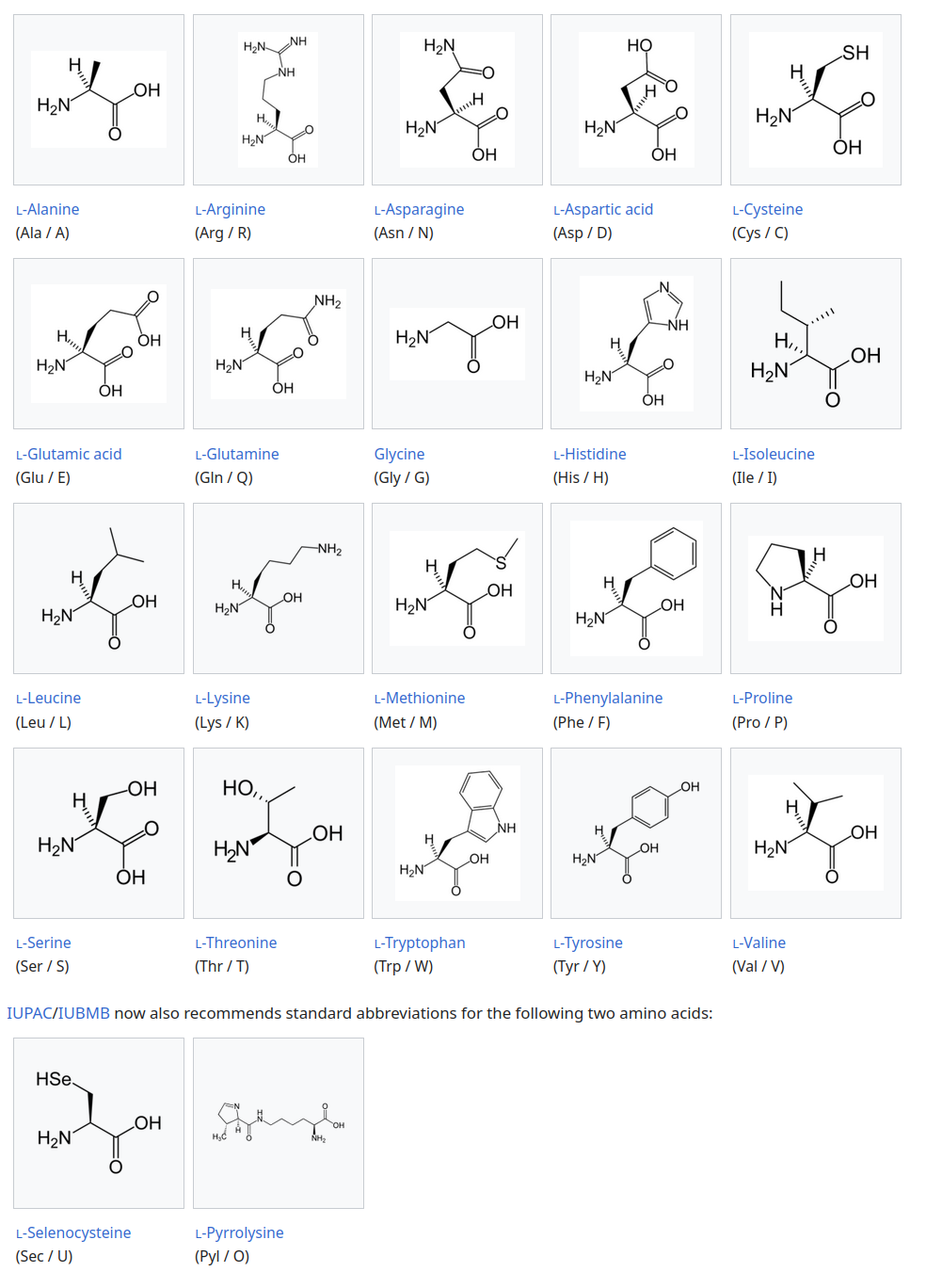
In eukaryotes, there are only 21 proteinogenic amino acids, the 20 of the standard genetic code, plus selenocysteine. Humans can synthesize 12 of these from each other or from other molecules of intermediary metabolism. The other nine must be consumed (usually as their protein derivatives), and so they are called essential amino acids. The essential amino acids are histidine, isoleucine, leucine, lysine, methionine, phenylalanine, threonine, tryptophan, and valine (i.e. H, I, L, K, M, F, T, W, V).[3]
and they're correct, selenocysteine is human:
Although it is found in the three domains of life, it is not universal in all organisms.[11] Unlike other amino acids present in biological proteins, selenocysteine is not coded for directly in the genetic code.[12] Instead, it is encoded in a special way by a UGA codon, which is normally the "opal" stop codon. Such a mechanism is called translational recoding[13] and its efficiency depends on the selenoprotein being synthesized and on translation initiation factors.[14] When cells are grown in the absence of selenium, translation of selenoproteins terminates at the UGA codon, resulting in a truncated, nonfunctional enzyme. The UGA codon is made to encode selenocysteine by the presence of a selenocysteine insertion sequence (SECIS) in the mRNA. The SECIS element is defined by characteristic nucleotide sequences and secondary structure base-pairing patterns. In bacteria, the SECIS element is typically located immediately following the UGA codon within the reading frame for the selenoprotein
while pyrrolysine is not:
Pyrrolysine (symbol Pyl or O;[2] encoded by the 'amber' stop codon UAG) is an α-amino acid that is used in the biosynthesis of proteins in some methanogenic archaea and bacteria;[3][4] it is not present in humans. It contains an α-amino group (which is in the protonated –NH+
3 form under biological conditions), a carboxylic acid group (which is in the deprotonated –COO− form under biological conditions). Its pyrroline side-chain is similar to that of lysine in being basic and positively charged at neutral pH.
so 21 is the number. three times 7, multiplication of the two numbers considered the most sacred, no wonder 21 is the one.
for those of you who doesn't know how to read these diagrams, here I found one of them in 3d:
and by whatever irony, it is that very
selenocysteine
Selenocysteine was discovered in 1974 by biochemist Thressa Stadtman at the National Institutes of Health.
Pyrrolysine was discovered in 2002 at the active site of methyltransferase enzyme from a methane-producing archeon, Methanosarcina barkeri.
so naturally more are yet to come, including the ones produced by engineered microorganisms, or maybe even humans
Selenocysteine was discovered in 1974 by biochemist Thressa Stadtman at the National Institutes of Health.
Pyrrolysine was discovered in 2002 at the active site of methyltransferase enzyme from a methane-producing archeon, Methanosarcina barkeri.
so naturally more are yet to come, including the ones produced by engineered microorganisms, or maybe even humans
So, could ancients be at the level of understanding of the beginning of the 20th century?
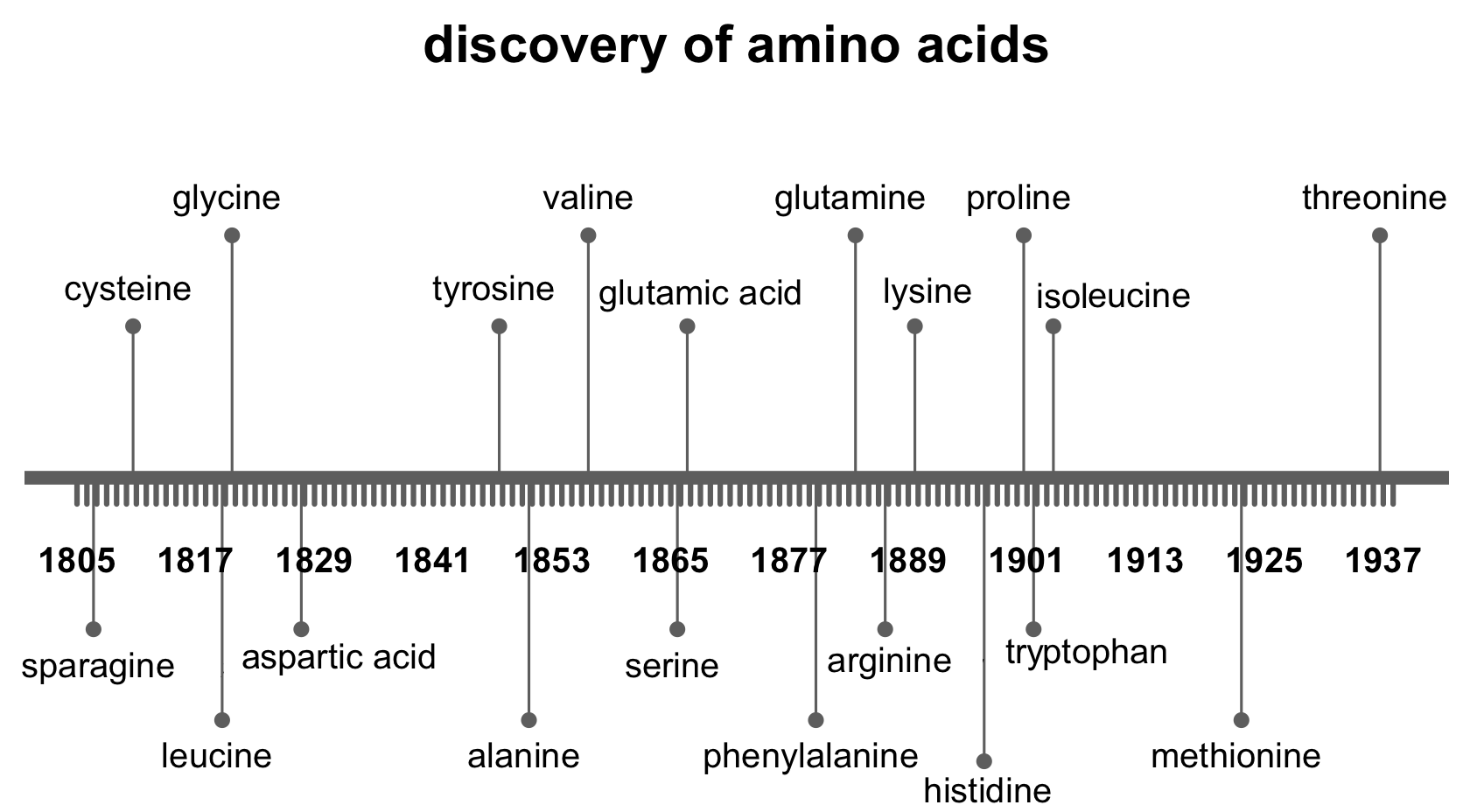
I seriously doubt it, but then I know that they had mechanical computers, which is not that far from that level. But 3 millenia ago? oh.. who knows really.
Starting with 18, I ended up with 15,
ᛆᛒᚦᚠᚼ
ᛁᚴᛚᛘᚿ
ᚮᚱᛦᛋᛏ or such
and 15-letter alphabet is legendary, but let's not overcomplicate it, let's use the one we know:
абдеж
иклмн
опрст
and to my surprise the two out of three lines are russian memes ёклмн и ёпрст ё лёдё гёвёрёт чтё лёбёё глёснёё мёжнё зёмёнёть бёквёй ё, no wonder though since глсн лшн
Russian mems give me two lines:
yklmn
öpr s t
interesting how m and s are M and Ϻ
interesting how L and R tell that it was in cloum columns:
Y Ö
K П
L Г[r]
M С
N Т
as in russian today, K and R are out of place, so is if we do it like this:
Y Ö
Г П
L К
M С
N Т
which places R next to L:
YRLMN
OPKST
and it demands the other way around: . . but playing with hebrew I felt myself profane
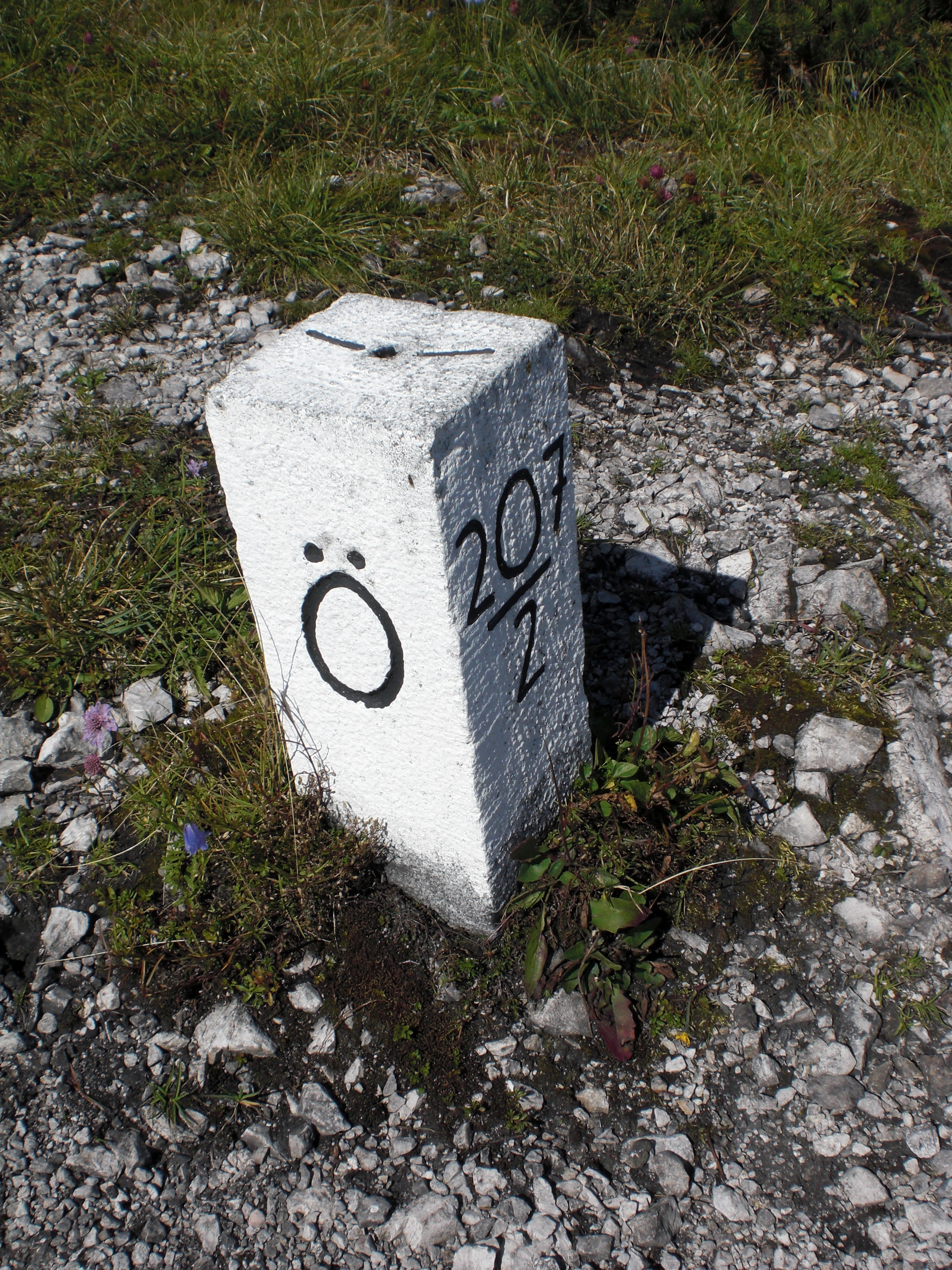
The letter Ö, standing for Österreich, i.e. Austria, on a boundary stone at the German-Austrian border.
tsrqponml rihgfedcba?
utsrqponml rihgfedcba!
B reflects T, V reflects Ʌ
and ten letters in each half, the 20 letter alphabet. Let's apply it to that kiddi alfabet to see if it fits:
abcd
efgh
imnl
opqt
ufhs
And it fits precisely. And I thought it was trippin' nowhere, and it is just to the point. So I just Replaced R with K or rather K with R, because coursive k looks like R, because voiced are there in Y?LMN and Ö line prefers voiceless ones: П?СТ and K the Q is also between P and S.
K П
L R
M С
N Т
lookd do looks so great, because R and L are like this. Was it a basis or the later modification of it to do these column or by some other reasons? I think that R instead of L giving me 20 letters of the alphabet, which are the kiddi alphabet set. Is it though? efgh was efjz and though g~j, am I seriosly? not trippin? can H be Z? as H and the I-like shape of Z this artefact demonstrate the both letters one next to the other:

It is supposedly so ancient, and it seems to be in top-notch condition. Like what is it even made of? Isn't it a replica? It is replica, right? Looks new. Is it even real at all?
utsrqponml rizjfeдgбa but now where is h of ufhs? is j that? but j is j in detski alfavit, hm..
ponml as понимал, без m было бы понгял
it is me very high, three times high in few hours
few is of four
several is of seven, now it is clear. what is many? many is more. 万y? ten jousand is many, but maybe not that many? mile is ten times less. and thousand is quite many as well. Is horde of hunred? sev-en, t-en, elev-en, probably all are several. A hundred is red hund? Funny that hatred is hat red, but what is it if not just some random rebus?
u t c r q p o N m l
a b г d e f h Z i r
a б g д e f g h i l
u t s r q p o n m
ilmn, I like it, 19 as the golden number 19
but where is R? was R caused by the prominent position of L?
Law ~ Right?
Law is what low and left and laid in the уложении о правонарушении
Rights are what people may do, what they have right to do.
There are no rights in the УК. ук as utsrqponmlk i-a is istina? what? I'm so high, why am I doing it, it is something overwhelming, and I must take bath.
Shortening kiddi alfavit to 3×3, opt is naturally teh line, p is also f, t is also s (шта is probably named like that because of that voiceless lingual unity)
abd merged with evj is ɅV< [avʒ] but then Aбg it is, isn't it? is it not? (notice the different word orders)
and the middle row is LMR (left, middle, right, where the three sonors are in this order, because L looks like both I (and ا, and ו) and Ʌ the ʌ
and it make me thing that those A I U are Ʌ Λ ᚢ, and then naturally BMP are ᛓᛘᚠ, and GRT are гrᛐ? is it all AɅVГ? or ɅXЖ? IHG? What? abcdefg ghi can abcdefghi be ascending-descending scale? 6 intervals ahead, two intervals downstream? three? What?
Anyway, this stuff is not publishabel even my by me my standards. But then booklet is to be corrected and publihed, this is without doubt. But I don't hold my breath about it:
and he is an interesting character, that's for user sure, he said "we can define the divine" which is very poetyc poetic
But back on track
AWГ
J M r (where J of Л is both left and low, when R is both right and rise (compare to rise and to lower))
VПТ
it's something alosn these line, I think I'm getting closer and closer to it, but then I think I need to find a language in which one is starting with A and is один[adín] five starts with M (as if пять is мять) and nine starts with T (tevyatt? (девять[devjatי])) well, something along those lines, then I'd be able to identify those 9 as
123
456
789
but 6 as R doesn't make much sense, unless it is upside down Р[r]RU and Ⱃ is glagolic R
7 as theVen? nah, semm, I don't know, maybe it is not this simple, maybe I'm really yet to find a language in which 5 starts with M
Or is it B for Beginning, M for middle, F for finale? finish? or is it S? is Θ the both? is it ſ~f?y
Just as god of one nation is гад of the neighbour, so is good in one language худо в соседнем.
худое змеёй через дырку стекает. ход. дырка это ход. проеден крысой ли червяком ли. Худое значит херовое. хуёвое.
Что русскому хорошо, то немцу смерть. Ашуры у одних асуры у других. Девы одних дьявол других. Fates Hades? Goddess? But Hades is shown as a male figure with three-headed cerber. What was her name? Hekate. te as the t the final letter, k as central letter. kirk~church, the forms of c the circle, круг, и если le это суффикс, то circ of circle is circ of circumference. Церера потому ещё манит (пугает что вместо Berdandi of Bekate (see japanese, it is one of the keys, for aeiou with common order of a i u восходяще-низходящая, мажор и минор понятные профану, протомажориминор.
Is name hades attributed correctly to that guy? Was he misattributed? Hades has ад in it. H is the, es is plural. Goddess is of god? Goddess could be Gods. Before monotheism pluralism was. Each of us are different god. What jews say is only our god exists. Other gods don't you dare to worship. Yours where r is th. youth is you's? "твои"
he ka te is 2/3 alphabetic, and h is before k, and h is vowel in greek. И К М? could m be misread as т?
I would suspect the other way around, but who knows how ancient is russian т in the form of т and if it was used in more civilized centres, like prague, for examply, what to I know. г as i how insane is that! B as Ⱁ, B S O
.jpg)
In Greek mythology, the Charites /ˈkærɪtiːz/ (Χάριτες [kʰárites]), singular Charis, or Graces, were three or more goddesses of charm, beauty, nature, human creativity, goodwill, and fertility.[1] Hesiod names three – Aglaea ("Shining"), Euphrosyne ("Joy"), and Thalia ("Blooming")[2][1] – and names Aglaea as the youngest and the wife of Hephaestus.[3] In Roman mythology they were known as the Gratiae, the "Graces". Some sources use the appellation "Charis" as the name of one of the Charites, and equate her with Aglaea, as she too is referred to as the wife of Hephaestus.[4]
They were often referenced as dancing and singing with Apollo and the Muses.[24 (click the image above to see links)]
A going first and T going last is interesting, and that Thalia is also a name of a Muse. Hardly would gods have the same name, considering the hypothesis of them being names for abstract concepts, or rather them being abstract concepts anthropomorphised by the masses.
Thalia danced with muses and she was with two others, as in my guess muses are three fates, a man chooses one of three fates as three varnas tell or they three work in the production of the man? two chromosomal dna and one mitochondrial one? Too complicated, too many assumptions. Let's go closer to the core by my book as the basis. Le't finish this on ..29 ..not very pretty. I expect 33 to be the next beautiful ending, and if I don't make decission to stop smoking weed, I will never stop smoking it. Let's make a bet not not buy weed. This is how I stopped drinking vodka. I stopped to buy it. And soon those who'd buy it for me were all left, also because I was not willing, and maybe they took my advice and also stopped buying it. So I have plenty of weed for three volumes more. This one seems to be closer to the end, but becase it isn't lagging yet, even though it's larger than the previous one, I keep it on.
In Greek mythology, Thalia (/θəˈlaɪə/[1][2] or /ˈθeɪliə/;[3] Ancient Greek: Θάλεια; "the joyous, the flourishing", from Ancient Greek: θάλλειν, thállein; "to flourish, to be verdant"), also spelled Thaleia, was one of the Muses, the goddess who presided over comedy and idyllic poetry. In this context her name means "flourishing", because the praises in her songs flourish through time.[4]
and when I thought I got it,
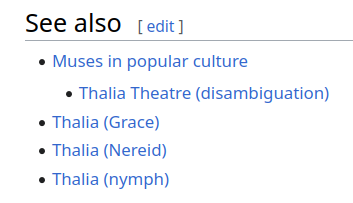
so I went through other muses, and only Urania was referring to some other goddess, or is it the same?
Aphrodite Urania (heavenly Aphrodite) is often an epithet given to Aphrodite in contrast with her more earthy aspect Aphrodite Pandemos (Aphrodite for all people).[citation needed]
Thalia and Urania, I expect other one to begin with vowel or labial, and because I know Urþ, labial it should be, but let actually check them through..
and in another place they say that Urania is Oceanida
Jesus is a pghilosohe phis philosopher of the level of Nietzsche (poetry much more than science, some sayings are quite ch shocking) and isn't national-socialism early period of that religion?
Are shock and choke dialectal pronunciation of the same word? (shock can leave people gasping for air)
air
breath, breathe, breeze
cold
earth, eau?
fire flame пламя
огонь слова элементов должны начинаться на гласную, а затем лишь найти язык где все когнаты этих слов присутствуют.
eau [O]
(ignore the orthography, it is from orthodoxy, and they're the dumbest of dumb (at least so they seem to "free thinkio thinkers"))
earth is eau''s
are eyes lakes
your ayes are planets or your eyes are lakes
mirrors of the sole, of the soul
is sole подноготная? под ногами ~ под ногтями? руки рассматривались как лапы когда эти слова образовались? когти как крюки? claws? clays? clay as soil and clay as cle clé, slauter slautel. key nail
kn?
key knows? знает=повторяет=поворачивает? плёт? прёт?
It's been so long that this wild draft was openly online, but now I hid it two pages away from the index, thus I grow, thus I mature. матерею, вот что это слово значит (матёрый значит mature)
I must shave the draft into pages, like I have those pages in cardboard, but better.
So I can index them and refer to a page by pasting its copy in the actual html deeping on (keeping on was to be said, but dipping is keeping in a way)
dip я думал что умыкать тоже можно, типа под воду спрятал, умыкать от слова мыть? a pick-pocket thief is also called dip, but how to know if it is not a coincidence.
town ~ stone
град ~ камень (в отличие от деревни, что деревянны (деревень, что деревянны, но как s бегает меж единственным и множественным числом: villages renew, village renews, is russian ы, which is also used for plural, which it is in деуревни.. в деревянны то же ы что и и в деревни? деревень это не единственное чилсо, это родительный чтоли подеш, в единственном слог с ы заменяется на слог с а, возможно с а))
is ы и?
orkhon p 𐰯 makes me think of how п л т н м are interconnecnted: m ~ т(т) and n ~ п and now here p looks like t. Were all consonants the same bkv~bkz? (буквы~books) and it would explain З looking like staveless В, but then
Or is that 𐰯[p] ~ [l]ᛚ for orkhon goes right to left, and then they remind п~л (пруд~lake? forest~лес?)
those who type in two typefaces have to shave~share the patterns, giving them a schizo effect of the same letter being in two different cells, unlike с. so let's reprogram russian keyboard..
qwertyuiop[]\
asdfghjkl;'
zxcvbnm,./
чшертыуиоп[]\
aщдфгхйкл;'
зцсвбнм,./
what letters are missing? ёжъьэюя
I would place them like
чшертыуиопёжъ
aщдфгхйкльэ
зцсвбнмюя/
but here appears the easily read unpleasant message of чёрт ты уио п-ёж, and omitting the ш-like щ we can read ад, and those шщ become some static radio noice.
And in the last line we can read за це свободными (you, я if we add those two my way)
I think I should reprogram keyboard alphabetically:
1234567890\|/,.
abcdefghijklmn
opqrstuvwxyz
Would it be fun to have 14 letters instead of 11 per line?
Very much. with ten fingers we could have 30 letters per finger, if we go up and down, and pinkies and especially indexes go sideways too, which allows, which promises us better keyboard than the one we have. I have to buy a reprogrammable keyboard. Or rather I have to produce one. Most of people who buy computers don't know querty, but they know abcde

abc de srqpo
j i hgf tuvwx
↑klmn yz
the first attempt failed miserably, this bustrophedon only complicates it.
but then that keyboard above also has only two letters in the bottom right part. Naturally, since it's the same alphabet.
Let's do it again, this time havein a i o in mind:
abcd efgh
ijklmn opqrst
uvw xyz is the natural bleaus.
Pinkies are too short to jump to q form the basic position
or is it just me? And I notice that q mirrors p at the other end of the thing.
qwert doesn't reflect yuiop unless w and o are both ו, e~i, especially in cursive, u is almost v, which may remind r, and ᚱ~ᚢ, and T and Y may remind each other: ..and I didn't find that image in unicode, I could only find ♈, and it is interesting how it reminds both T and V, and it is to be copied into TV.html

I naturally go "what is wrong wiht Lepontic?" but at least they know O, can I believe that etruscan and oscan didn't know o?
𐌆 is the archaic Z I was looking for, and there's unicode for old italic scripts:
𐌀 𐌁 𐌂 𐌃 𐌄 𐌅 𐌆 𐌇 𐌈 𐌉 𐌊 𐌋 𐌌 𐌍 𐌎 𐌏 𐌐 𐌑 𐌒 𐌓 𐌔 𐌕 𐌖 𐌗 𐌘 𐌙 𐌚 𐌛 𐌜 𐌝 𐌞 𐌟 𐌠 𐌡 𐌢 𐌣 𐌭 𐌮 𐌯
I read that the other three are some syllables, which reminds of paleo-hispanic and even more so hungarian and orhkon/yenisei:
𐌭 ye
𐌮 tse
𐌯 tse
others follow phoenician order, continuing into greek line, but the way they placed 𐌗 before 𐌘, is it by accident?
𐌙 being not ps but kh is weird
𐌚 The twenty-eighth (final) letter of the classical Etruscan alphabet, F of the Roman alphabet; transliterated ⟨f⟩; and bearing the letter name ef.
𐌛 is probably a form of 𐌓
they say 𐌜 is ч, but who knows
they say 𐌝 is ii
they say 𐌞 is uu, thus both vowels use dash and dot as double or long
𐌟 The final letter of the archaic South Picene alphabet; equivalent to the letter φ of the Greek alphabet; transliterated ⟨ś⟩, ⟨σ⟩, or ⟨k⟩; and bearing the letter name ess. Also used in the classical Etruscan alphabet as a numeral representing 100. another f, it's very weird
𐌠 𐌡 𐌢 𐌣 are 1 5 10 50
producers of alcohol use sneaky marketing tactics:
Akvavit or aquavit (/ˈɑːkwəviːt, -və-/; also akevitt in Norwegian; aquavit in English) is a distilled spirit that is principally produced in Scandinavia, where it has been produced since the 15th century.
An eau de vie[A] (French for spirit,[1] lit. 'water of life') is a clear, colourless fruit brandy that is produced by means of fermentation and double distillation. The fruit flavor is typically very light.
Aqua vitae /ˌækwə ˈviːteɪ/ (Latin for "water of life") or aqua vita is an archaic name for a concentrated aqueous solution of ethanol. These terms could also be applied to weak ethanol without rectification.[1] Usage was widespread during the Middle Ages and the Renaissance, although its origin is likely much earlier. This Latin term appears in a wide array of dialectical forms throughout all lands and people conquered by ancient Rome. The term is a generic name for all types of distillates, and eventually came to refer specifically to distillates of alcoholic beverages (liquors).[2]
Aqua vitae was typically prepared by distilling wine and in English texts was also called ardent spirits, spirit of wine,[1] or spirits of wine, a name that could be applied to brandy that had been repeatedly distilled.
The term was used by the 14th-century alchemist John of Rupescissa, who believed the then newly discovered substance of ethanol to be an imperishable and life-giving "fifth essence" or quintessence, and who extensively studied its medical properties.[3]
or is it a historic curiosity without a hidden cause? ah, nah, hardly so
A B G D
I M N L
U F H S
The way BCDEFGAB is out of phase reminds me the zodiac beginning in March.
And 12 constellations could relate to 12 semitones.
Æ В G D [a b g d / e v ʒ ð]
I M N L
ע פ צ ק ר ש ת [o/u p/f ч/ц к r ш/s t/θ] (this line promises 18 of 3×6, or it is its pattern (if ר stands for both russian and english r's, which it does, then we have our 6 with q being excluded for being queer: greeks, russians, runic abecedary is under the question of whether it is ᛣ or ᛦ))
3×6 ~ 36, which is twice 18, is it a coincidence? It probably is, with mathematically calculated probability easy for some good schoolboy.
36 is 6×6, naturally because two times three is six.
I M N L line, let's find what pairs they may represent?
a) they may represent no pairs, since there are 5 vowels and not 6
b) I/J M/W N/Ŋ L/R? then the firfth line is O/U P/F Ц/Ч К/? Ш/S T/θ (L/Y was my first guess, so could R be in the second one?_)
Why this guesssing? What's the use of that discovery? What is the verifiability of that?
ctrl shift u 0300-0310: я̀я́я̂âāa̅ăȧäảa̐
is Ѯ vertical bilingua, vertically going binderune? literally кs
- as h? the связь меж колонн? and thus that ̆ is shortening, and thus turning h into k? but l is l, not h.
Coursive h does look like coursive L (I avoid spelling cursive, even though the letters cgo counterclockwise.
that Ѯ go all the other ways: к looks away from s with that c-beak (is c [ko] short, child, short~child)
̐
ÀÁÂÃÄÅÆÇÈÉÊËÌÍÎÏÐÑÒÓÔÕÖ×ØÙÚÛÜÝÞßàáâãäåæçèéêëìíîïðñòóôõö÷øùúûüýþÿ
ĀāĂ㥹ĆćĈĉĊċČčĎďĐđĒēĔĕĖėĘęĚěĜĝĞğĠġĢģĤĥĦħĨĩĪīĬĭĮįİıIJijĴĵĶķĸĹĺĻļĽľĿŀŁłŃńŅņŇňʼnŊŋŌōŎŏŐőŒœ
ŔŕŖŗŘřŚśŜŝŞşŠšŢţŤťŦŧŨũŪūŬŭŮůŰűŲųŴŵŶŷŸŹźŻżŽžſƀƁƂƃƄƅƆƇƈƉƊƋƌƍƎƏƐƑƒƓƔƕƖƗƘƙƚƛƜƝƞƟƠơƢƣ
ƤƥƦƧƨƩƪƫƬƭƮƯưƱƲƳƴƵƶƷƸƹƺƻƼƽƾƿǀǁǂǃDŽDždžLJLjljNJNjnjǍǎǏǐǑǒǓǔǕǖǗǘǙǚǛǜǝǞǟǠǡǢǣǤǥǦǧǨǩǪǫǬǭǮǯǰ
DZDzdzǴǵǶǷǸǹǺǻǼǽǾǿ
ȀȁȂȃȄȅȆȇȈȉȊȋȌȍȎȏȐȑȒȓȔȕȖȗȘșȚțȜȝȞȟȠȡȢȣȤȥȦȧȨȩȪȫȬȭȮȯȰȱȲȳȴȵȶȷȸȹȺȻȼȽȾȿɀɁɂɃɄɅɆɇɈɉɊɋɌɍɎɏ
ɐɑɒɓɔɕɖɗɘəɚɛɜɝɞɟɠɡɢɣɤɥɦɧɨɩɪɫɬɭɮɯɰɱɲɳɴɵɶɷɸɹɺɻɼɽɾɿʀʁʂʃʄʅʆʇʈʉʊʋʌʍʎʏʐʑʒʓʔʕʖʗʘʙʚʛʜʝʞʟʠʡʢʣʤʥʦʧʨʩʪʫʬʭ
ʮʯʰʱʲʳʴʵʶʷʸʹʺʻʼʽʾʿˀˁ˂˃˄˅ˆˇˈˉˊˋˌˍˎˏːˑ˒˓˔˕˖˗˘˙˚˛˜˝˞˟ˠˡˢˣˤ˥˦˧˨˩˪˫ˬ˭ˮ˯˰˱˲˳˴˵˶˷˸˹˺˻˼˽˾˿0̀́̂̃̄̅̆̇̈̉̊̋̌̍̎̏0̛̖̗̘̙̜̝̞̟̐̑̒̓̔̕̚0̡̢̧̨̠̣̤̥̦̩̪̫̬̭̮̯0̴̵̶̷̸̰̱̲̳̹̺̻̼̽̾̿0͇͈͉͍͎̀́͂̓̈́͆͊͋͌ͅ͏0͓͔͕͖͙͚͐͑͒͗͛͘͜͟͝͞0ͣͤͥͦͧͨͩͪͫͬͭͮͯ͢͠͡ͰͱͲͳʹ͵Ͷͷͺͻͼͽ;Ϳ
΄΅Ά·ΈΉΊΌΎΏΐΑΒΓΔΕΖΗΘΙΚΛΜΝΞΟΠΡΣΤΥΦΧΨΩΪΫάέήίΰαβγδεζηθικλμνξοπρςστυφχψωϊϋόύώ
ϏϐϑϒϓϔϕϖϗϘϙϚϛϜϝϞϟϠϡϢϣϤϥϦϧϨϩϪϫϬϭϮϯϰϱϲϳϴϵ϶ϷϸϹϺϻϼϽϾϿ ЀЁЂЃЄЅІЇЈЉЊЋЌЍЎЏ
̀ ́ ̂ ̃ ̅ ̆ ̇ ̈ ̉ ̊ ̋ ̌ ̍ ̎ ̏ ̐ ̑ ̒ ̓ ̔ ̕ ̖ ̗ ̘ ̙ ̚ ̛ ̜ ̝ ̟
0313 and 0315 look the same: ̒ ̓ ̔ ̕
but I look closer, and not exactly, even though they definitely messed those yin-yang up, missing д-like

and they did it at least twice:

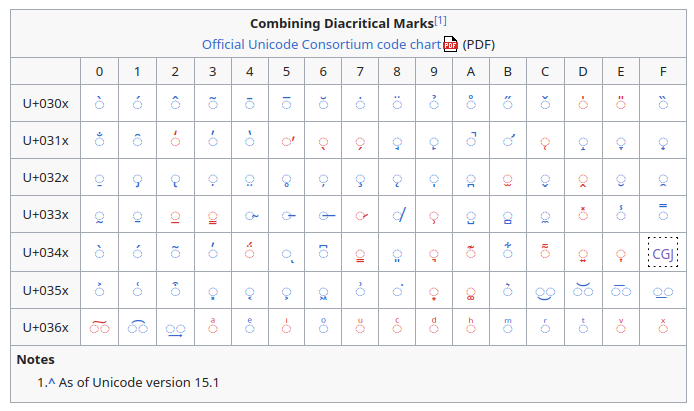
I̋ transcribe that diacritic sequence as ijΛΝ which is very alphabetic.
And the final row gives us aeiou and dhmrtvx which is also alphabetic, but thus the consonant row is also like the eastern kdhmry
which begs the question: is it some common sequence differently treated in their future?
and diacritics has exactly 13 letters, as many moons is in a year.
are there some letters in U+037x? Ͱ ͱ Ͳ ͳ ʹ ͵ Ͷ ͷ ͺ ͻ ͼ ͽ ; Ϳ
tits are nice, others are rather old greek and random
Found that ϒ I was speaking about. even two! even three! ϒϓϔ
So i j Λ Ν – — U o oo
𐎲[b] reminds me 𓃀 rotated 90 degrees, and it gives me the foundation to compare old-persian syllabary to egyptian one, but this idea doesn't go anywhere, unless 𐎭d is 𓂧:
𐎠a 𐎡i 𐎢 u 𐎣k 𐎤ku 𐎥g 𐎦gu 𐎧x 𐎨c 𐎩j 𐎪ji 𐎫t 𐎬tu 𐎭d 𐎮di 𐎯du 𐎰θ 𐎱p 𐎲b 𐎳f 𐎴n 𐎵nu 𐎶m 𐎷mi 𐎸mu 𐎹y 𐎺v 𐎻vi 𐎼r 𐎽ru 𐎾l 𐎿s 𐏀z 𐏁š 𐏂ç 𐏃h
Other comparisons take too much fantasy, but some signs are similar: 𐎼[r] reminds 𐎲[b]
and 𐎠[a] reminds 𐎼[r] and these pairs remind R and B (only here it is the other way around)
and A/R (см. the ancient form of अ)

स [sa] reminds it! well, kind of, nah, not really, not more than प
666 tells me ⚅⚅⚅ which tells me that before christians people believed in forture and that fates are probably fortunas, abd because feя is goddes, t in fate could be the plural suffix. And thus 6 is Ф?
F is indeed! vav the vulva? Standing right before the 7 the zayin? F and Г like I can imagine г turned the other way around entering the F and such image could be the representation of sacred union of female and male, and if fortune are plural form of фарт, it begs a question if the letter ферт represent the goddess, and since russians recognize Ф as филин (owl) are three owls the goddesses? And it is easy to check: The three wise owls alabaster statue, the symbol of goddess Athena and wisdom. Handmade greek alabaster statue of the three wise owls, referring to the proverbial principle see no evil, hear no evil, speak no evil. The owl is the symbol of goddess Athena and symbol of wisdom. but I go further, and look for image of this, and find it to be rather popular, but I look up ancient owl figuirine, and there's not a single ancient one in such pose, so probably it is a modern representation, not present in the past. anyway, I leave it here to once again show that not all my ideas give fruit, some of them are dry, but I return to where it was alive and go on: F for goddess, Z for зверь? it is just pure guess, and could lead nowhere as well, but most of this paragraph is written before I get high, so I leave the note on hereto and return with something completely different.
are hereto and thereto typos which were accepted as new words? But reverso gives only this context where it could be such: You have a friend hereto see you. but I have some doubts it is not a typo per so.
and I kept on digging the idea of triple owl as the representation of fates, but I only found modern representations of three wise owls, and three wise ravens, similar to three wise monkeys, and I wonder if the roots of this story is deep or not, and some good finds in that quest appeared:
John Brand was an English antiquarian and Church of England clergyman, who was appointed ' Secretary to the Society of Antiquaries ', in 1784. His book, ' Observations of Popular Antiquities ', (1780), has the first-known record of counting Magpies to predict good or ill-fortune, in the description, and records only four lines:-
'One for sorrow, Two for mirth, Three for a funeral, And four for a birth '. ' Popular antiquities ' later became known as Folklore, (a term coined by William John Thoms in 1846).
interesting, that here odd numbers are lucky. but it goes on:
In that year, the rhyme was added to ' Proverbs and Popular Sayings of the Seasons ', by Michael Aislabie Denham, an English merchant and collector of folklore. The following lines were added:-
' Five for heaven, Six for hell, Seven for the devil, his own self '.
Seven for the devil is very odd, but it goes on, and they explain the meaning of the omen(примета)
Sir Humphry Davy attributed the connection for the feeling of one, then two magpies to joy and sorrow in his, ' Salmonia : or Days of Fly Fishing ', (1828); he wrote:- 'For anglers in spring it has always been regarded as unlucky to see single magpies, but two may be always regarded as a favourable omen;...in cold and stormy weather one magpie alone leaves the nest in search of food; the other remaining sitting on the eggs...when two go out...the weather is warm...favourable for fishing '. In England, "a magpie’s nest" was a phrase used to describe something untidy and usually of little value. "One for Sorrow", elaborates the legend.
Blue and orange is fire, I saw this way coloured bird which I recognized as жар-птица (внутренним взором видел, под грибами вроде бы, так что божественная птица, а не обыкновенная)
обычная
обыкновенная
проникновенная
проничная? нет такого слова
пронзительная
ычная
ыкновенная
зительная
определённо сложные слова
Осознаю, что я не с богом, а с дьяволом. Я сделал выбор даже, а хотел быть с обоими в ладах, но они сражаются за обладание. Что я видел в самом странном полугрибном трипе где видел борящихся (без оружия, крыльями и у другими конечностями) и "борьба была равна, сражались два.. не говна так волка, и тут я таков задумавшись об этом говорю Так что я должен выбрать мир в душе. подразумевая сделав выбор и не беспокоиться. Но я создаю частичку бога, но какого бога? Могу я быть их связкой? Смысл? если напрямую, то ..обмен информацией как клетками бы обменивались будучи напрямую пуповиной соединены. Но я вижу их присоединённых к общей плаценте, и тогда у них общая цель. Человек это не только плоть богов как церковь (которая не в домах из дерева и камня, а люди тело бога) это и цель целый век цель век (в глазах самих, ане в овне)
печатая на клавиатуре я артикулирую пальцами слово и если бы клавиатура была от музыкального инструмента, каждое слово было бы мелодией. И само собой мне вспоминается аккордеон, который меня пугал и завораживал своей сложностью, и эта клавиатура имеет 2d-расположение, что мне что-то напоминает, и давай сравним гнде в нём какая нота:

Аккордео́н (от фр. accordéon) — хроматическая ручная гармоника с клавиатурой мелодии фортепианного (наиболее часто) типа. Клавиатура аккомпанемента такая же как у баяна[2]: с 5—6 рядами кнопок, звучащими басами и аккордами (готовый аккордеон) или отдельными нотами (выборный или готово-выборный аккордеон).
В голосах мелодии как правило два строевых (основных) язычка как правило звучат в «розлив» (с небольшой разницей в настройке), что определяет особенность звучания аккордеона по сравнению с русским баяном, у которого те же язычки звучат точно в унисон. Ещё одним отличительным признаком является более вероятное наличие регистров в голосах мелодии (см. Количество голосов. Регистры).
История аккордеона удивительна, извилиста и до сих пор вызывает оживленные дискуссии в профессиональной среде. История аккордеона берет начало с Древнего Востока, где впервые в музыкальном инструменте шэн был использован принцип язычкового звукоизвлечения. У истоков создания аккордеона в привычном нам виде, стояли два талантливых мастера: немецкий часовщик Христиан Бушман и чешский умелец Франтишек Киршнер. Стоит отметить, что они не были знакомы между собой и работали совершенно независимо друг от друга.
17-летний Христиан Бушман, стремясь упростить работу по настройке органа, изобрел нехитрое приспособление — камертон в виде небольшой коробочки, в которую поместил металлический язычок. Когда Бушман ртом вдувал воздух в эту коробочку, язычок начинал звучать, выдавая тон определенной высоты. Позднее Христиан добавил в конструкцию воздушный резервуар (мех), а чтобы язычки не вибрировали одновременно, снабдил их клапанами. Теперь для того, чтобы получить нужный тон следовало открыть клапан над определенной пластинкой, а остальные оставить прикрытыми. Таким образом, в 1821 году Бушман изобрел прообраз губной гармоники, который назвал «аура».
Почти в то же самое время, в 1770-х годах, чешский органный мастер, трудившийся при российском царском дворе, Франтишек Киршнер придумал новую систему язычковых планок и положил ее в основу создания ручной гармоники. В ней было мало общего с современным инструментом, но единым оставался главный принцип звукоизвлечения гармоники — колебания металлической пластинки под воздействием воздушной струи, нажатий и щипков.
No wonder russians had accordeons half a century before europeans, I always felt it to be a russian instrument, polka is also from eastern europe, and I believe it was because the fashion of recording music into "national classical repertoire" was around the same time, and because very few european compositions include hand harmonicas, I believe in to be during that short period of late 18th and early 19th century. Where Mozart and Beethoven lived. And russian secular musical tradition knew hand harmonicas, and if it existed, but as музыкальное подполье naturally it did.
But what is it for? If these heyboards are recent like that, they don't matter in archaelogic sense, unless some secret masons or druid musicians built some ancient knowledge into modern instruments. But the idea is not in that: I was looking for the predecessor of the piano keyboard lay-out, and I suggest this "chromatic" one if I use the correct term, this other keyboard could be closer to the root, so because I know the piano keyboard, let's learn these:



европейская раскладка московская раскладка
(italian layout)
and five-line layout.. am I not bastartdizing their language? I naturally do, so this stuff is unpublishable once again. Was Joyce knowing english from a different angle? and leningrader's or sterligoff's


and the other keyboard is something about which I knew even less. Some buttons open two notes:




готового баяна B-griff free-bass C-griff free-bass выборного баяна
Условные обозначения: Б — мажорное (большое) трезвучие, М — минорное трезвучие, 7 — доминантсептаккорд. У 120-кнопочных клавиатур справа от ряда септаккордов есть дополнительный ряд кнопок с уменьшёнными септаккордами (обозначаются буквой У).

What does it change? The more I know..
M and B meet in Major Балшой and I met them yesterday somewhere I didn't record, and thus cannot recall, I pray it returns, I will at least recognize it.
Okay, we're well off the track. Let's teleport our thoughts somewhere ielse.
overspecialization allowed predators to be known only by one collective and thus less likely to be exposed. Before that you wouldn't be just a teacher, who are you to only teach. You would work in the field with all your pupils. Now since we have machines we don't need your presence, and you couldn't eat for free, you needed to invent yourself some bs speciality.
Not every work is dangerous, so kids could be helping their parents, or parents fired because of behaviour of their children, so kids learn to behave fast. And parents cannot beat their children when everybody's watching. A better world. And if the prefession of one parent is dangerous, others cannot have a dangerous profession, so kids would be allowed near them.
Yes, teachers, I'm talking of you. People need to learn skills, not your kill-days to celebrate with your crowd. Thatcher was quite a teacher. will always be.
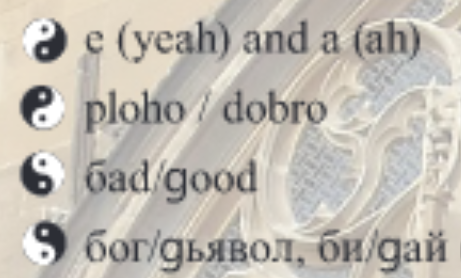
a~d and ад
р of рай (and peace, rest in peace) is the opposite. and thus e/a, the one I found only to the second edition, is once again the correct arrangement. and рi [ri] is the correct orthography, if we compare it to ад, and such view links R to I the wasy A to Д is. And though r and i look alike, R doesn't, but then I see the white inside of R.
IJKL~r? r~п.. пr, not necessarily пт, but then t~r (ᛚr? ᛐ is the t, that ᛚ is l, but why does it look the other way? Because runes looked different ways, and thus l and t are dashed invariants of the same thing? Imnl ~ Abdg? Opqt? Abгt? Is аборт (abortion) in the basis of the alphabet?)
(𐎍[l] ~ 𐎜[w]) ~ (l[l] ~ ł[w])
and since we're at this, [(h(e))E]𐎅 and 𐎛[i, and though I'd like it, since i reminds e with dot when ritten by hand, but then that 𐎛 is in the position of u, which is funny isnce since и=и and u=u
(check those == (one is italic, other is not))
what this mighty oldman tells (at 38:51) is what he calls abc-theory of motivation:
antecedents, behaviour, consequence, which is probably borrowed from other language, since antecedents is an outlandish word, but what it reminds me directly is three norns symbolizing past, present and future, and thus being those ABC, where C is directly the crone, and A is probably Ɔ the o, thus reflecting the C, and is B baby, beauty, or M the mother? or is it (considering the shape of the moon) σ the S combining both shapes? And is it why M~Ϻ? Too many questions, but some of them are actually answers. Since my first booklet is essential of the ten years of such discoveries, let's live at least 80 years more, to make that book 9 times larger, but then I realize that the actual culture I discover is not necessarily that many times bigger, but then I know that it is much bigger, that it is enormous, and combines every aspect of human culture, and thus it is a quite a quest for eternal life.
ў & й tell that russians know brevis, and potentially can use it over o and a too, but they also only know ё
ё has double dot, because single is taken by i (urk ukrainians may have different perspective, but I tell mine. Considering myself an ukrainian mostly to be edgieer, I am very russian, with only 25% of my blood being ukrainian. 25% is half russian half kazakhstan or who knows what, ukrainian village girl reproduced with a получурка (блять какой я охуевший, но вроде спрятал это бешенство с нулевой на третью(вторую) and half being as russian as it gets, maybe with some jew in proportions similar to that kazakh or was it georgian, some soviet components, and the ukrainian was half or a quarter polish, why do I give it? I was to say that russia is better than ukraine as a name, because Rah is better than oooo, ganba (but they're more politically active which is awesome, and naturally they're antiimperial much more often than russians, who were pleased with being the older brothert)
e i ё~ї (both having double dot, do they represent how two nations began differently pronuncing the common words? And it seems that it is how it was:
ёж = їжак
ёжик = їжачок
tot ziens bij 30.thml
bij is both by and bee5
...

